
5 Best Watermakers for Sailboats

Last Updated by
Daniel Wade
June 15, 2022
With the right Watermaker, the ocean becomes an almost immeasurable supply of fresh and clean drinking water to keep you hydrated during your offshore sailing adventures.
Many sailors do spend a lot of their time and money on various parts of the sailboat including the sails, engine, electronics, and generators especially when preparing for long-distance voyages.
While there's absolutely nothing wrong with this, they often overlook one crucial part of general human survival: having an ample supply of fresh drinking water.
Whether you have freshwater drinking tanks on your sailboat or planning to cruise in areas where you can easily access clean drinking water, the hassle involved in having to come to the dock to fill the water tanks can be quite overwhelming.
This is exactly why you need to find the best watermakers for sailboats.
Like many other nautical technologies, watermakers have significantly advanced in the last few decades to become very efficient and more reliable. They're no longer a luxury on your sailboat but a necessity. Better still, watermakers have become relatively affordable and are meant to keep you hydrated as you explore areas that do not have clean and fresh drinking water.
In this article, we'll take a look at how watermaker systems work, highlight its benefits, and highlight the best sailboat watermakers on the market right now. At the end of this read, you should be able to choose the best watermaker for your sailboat.
Table of contents

Benefits of Having a Watermaker on Your Sailboat
The freedom and security that come with having full water tanks on your sailboat are of immense importance, especially if you're cruising in an area where fresh drinking water is hard to come by and quite expensive when you do. As such, having a watermaker aboard your sailboat is no longer a luxury like it used to be in the past. With a steady supply of fresh and clean water, your life on the sailboat will be a lot better. This is because you'll have enough clean water to drink, cook, wash, and shower, which is beneficial if you want to enjoy your sailing adventures.
Honestly speaking, many sailors do not actually need a watermaker. Well, if you're planning to sail just near the shores, then there's a chance that you can easily access fresh and clean water by the dock. But this can be limiting if you've been dreaming of going off the grid and sailing to some exotic and unknown places in the world.
With that in mind, a watermaker makes a lot of sense to most sailors. You won't have to worry about having to carry aboard gallons of fresh water for cooking and drinking during your voyage. You won't have to treat freshwater as a precious commodity that must last until you can refill at the next port. With a watermaker, you can simply go ocean crossing without worrying about running out of water.
A watermaker allows you to have a steady supply of fresh and clean water to keep everybody well-hydrated and healthy. You can clean the water anytime you feel like and all you have to do is replace the filter once in a while and you'll be good to go. In essence, a watermaker is probably one of the most important equipment to have aboard your sailboat, so installing it is of great importance if you're a serious sailor.
The Basics of Modern Marine Watermakers
Modern marine watermakers essentially follow the principle of reverse-osmosis to produce pure, drinking water from seawater. During this process and through very high pressure, seawater is forced through a semipermeable membrane that only allows freshwater molecules to pass through it but not salt, bacteria, or any other organic material. The newly made pure, drinking water is then piped to the sailboat's water tanks while the leftover (brine) is discharged overboard.
Even though marine watermakers may differ in the type of pump that's employed and how it is driven, this is one of the most important features in every watermaker. In most cases, water can be electrically pumped or powered directly off the boat's engine. If you have an AC generator or alternator on your boat, it would make much sense to use the AC output to drive the watermaker directly. You can also choose the DC-powered models if you rely on renewable energy from solar or wind. Alternatively, you can still go for AC-powered watermakers but you'll have to buy an inverter.
All in all, DC-powered watermakers are more efficient since they integrate a power-saving energy recovery system (ERS). You must, however, keep in mind that your energy consumption levels might be quite high if you're sailing in colder and saltier areas. This is because the water purification process might be a bit slower in such areas. As such, you should consider investing in a more high-powered watermaker system if you will be sailing in colder and saltier areas than if you're planning to sail more in warm and less salty areas.
As far as an engine-driven watermaker is concerned, you should mount the high-pressure pump on the engine so that it can be belt-driven using an automatic clutch. An engine-driven watermaker should be your first option if you want large quantities of fresh drinking water. This is more productive than AC or DC-powered watermakers. Even with a relatively small engine, this setup has an automatic regulator that constantly pumps the water. With that in mind, engine-driven watermakers are ideal if you want to reduce your energy consumption. To put it into perspective, an engine-driven watermaker can lower energy consumption by an enormous 80%, especially when compared with conventional AC or DC-powered watermaker systems.
How to Choose the Best Watermaker for Your Sailboat
There are many factors to consider when looking for the best watermakers for your sailboat. Here are the most important things to consider.
Your Freshwater Needs
One of the most important things to consider before spending your money on a watermaker is your freshwater needs. What quantity would be enough to keep you going on your sailing adventure? While the quantity might differ from one sailor to the other or from one boat to the other, you should consider the number of gallons that a particular watermaker can produce per day. This will help you in choosing the ideal watermaker; a model that will ensure that you never run out of water. Do not underestimate your water needs, especially if you're planning to sail with your children or if you're planning to stay on the boat for an extended period of time.
Do you have enough space on your vessel to accommodate the type of watermaker you're looking to buy? While most watermakers are designed to fit in the smallest of space, you should consider the actual size of the watermaker and find out whether you have enough space on your vessel to fix it.
Watermakers can run on electricity, renewable energy such as wind and solar (if you have them on your vessel), or both. When looking for the perfect watermaker, you should consider how to power it and whether or not the watermaker has low-energy consumption, which is definitely a great feature. Again, there are also engine-driven watermakers, so it's important to know exactly what you're going for.
Maintenance
Watermakers have a reputation for being difficult to maintain. Fortunately, the equipment and components have improved in the last few years so you should go for a model that's easy to maintain. You should use the watermaker in water bodies that look good, You should avoid using the watermaker in dirty harbors as you may have to change the filters every so often or even damage your watermaker altogether.
Best Watermakers for Sailboats
Let's take a look at the best watermakers available on the market right now.
The Ultra Whisper
Engineered by limited electrical options that can run on either DC or AC, THE Ultra Whisper by Sea Recovery is one of the best watermakers currently available on the market. In addition to being very quiet, this watermaker features an automatic operation that requires very minimal operator adjustment.
This watermaker is ideal for small powerboats and sailboats since it can serve as an efficient water supply. This model boasts about a 75% reduction in power consumption, especially when compared to other models.
- Smooth and quiet water production
- Can produce up to 2,280 liters per day
- Ideal for small boats
- It is energy efficient
- It might not be perfect for large boats
Echotec Watermaker
If you want a watermaker model that can produce 60 liters per hour flawlessly and with no maintenance apart from changing the filters, look no further than the Echotec Watermaker. This model is designed for ultra-reliable performance and easy customer installation.
This watermaker is made from high-quality components that can withstand the continuous harsh marine environment, making it one of the most durable watermakers on the market. This is essentially a series of modular watermakers ranging from 12-volt to 24-volt DC-powered models. They bring forth energy efficiency, a computerized energy recovery system, and ultimate reliability to ensure that you never run out of fresh drinking water while out there on the sea.
- Energy efficient
- Cost-effective
- Comes with a very low speed
- Not ideal for large boats
Spectra Katadyn PowerSurvivor
As a compact and energy-efficient watermaker, the Spectra Katadyn PowerSurvivor is arguably the most affordable watermaker currently available on the market. We are talking about a model that only requires 4 amps to desalinate water for your sailboat. It can produce 1.5 gallons of fresh drinking water per hour, which is an excellent return for a watermaker of its size.
It is also one of the most portable watermakers around. You can choose to either install it permanently or temporarily in case you want to take it somewhere else. This portability is also essential if you're looking for a space-saving model that can fit in the smallest of compartments. Its simple but rugged design is essential in ensuring that it can perform at its best even in harsh marine conditions. In terms of its power capabilities, this is the only model on the market that will convert to a hand-operated system or manual power if there's a power shortage.
- Portable and lightweight
- Rugged design to withstand harsh marine environments
- Efficient and reliable
- Can revert to manual power if there's a power shortage
- Perfect for off-grid sailing
- Gasoline or diesel can easily damage the semi-permeable membrane
Village Marine - Little Wonder Series
Whether you're looking for a watermaker for your small sailboat or looking for a watermaker that can efficiently serve those huge yachts, the Village Marine Little Wonder Series provides everything. This model is meant for experienced sailors who are looking for various capacity options. This watermaker weighs just about 69 pounds but can produce nearly 180 gallons of fresh drinking water each day.
Designed with a low RPM high-pressure pump, this model remains one of the most efficient and economical watermakers on the market. That's not all; this watermaker is designed with corrosion-resistant features and is one of the most serviceable watermakers in the game. It is reliable, quiet, and portable; all factors that make a watermaker great.
- Easy to operate
- Corrosion-resistant
- Easy to maintain
- Quiet and versatile
- It doesn't have automatic adjustment controls
Ventura 150 Watermaker
This is one of the most versatile watermakers on the market. It can use both electricity and renewable energy. This model is engineered to be lightweight and energy-efficient and its compact and modular design makes it a great option if you're looking for a watermaker that's easy to use and install in confined spaces.
The Ventura 150 watermaker is highly efficient as it can produce over 6 gallons of water an hour, which makes it quite perfect for small vessels. This sailboat watermaker features a controller that allows you to operate and monitor the device remotely. It also has the auto store button that will automatically flash the system after every five days.
This watermaker is quiet and surprisingly compact despite its ability to produce about 150 gallons of water per day. It also gives you the option of going for the automated manual or manual model.
- Very versatile
- Can use both electricity and renewable energy power
- It is smooth and quiet
- It is compact and lightweight
- The manual model has analog controls
To this end, it's easy to see that having an ideal watermaker aboard your vessel is one of the first crucial steps towards being self-sufficient and sustainable. With a watermaker, you'll be able to access fresh drinking water at all times when sailing even in far-flung places. Most of these models are well-constructed and incorporate some of the best technologies that make them efficient, reliable, and easy to install, use, and maintain.
So when it comes to choosing the best watermaker for your sailboat, it may all come down to what is ideal for you in terms of energy consumption, efficiency, the quantity of water produced, among many other things. With an ideal watermaker, you can remain off the grid for as long as you want without ever worrying about running out of water and this is of great importance in enjoying your sailing adventures.
Related Articles
I've personally had thousands of questions about sailing and sailboats over the years. As I learn and experience sailing, and the community, I share the answers that work and make sense to me, here on Life of Sailing.
by this author
Sailboat Upgrades
Most Recent

What Does "Sailing By The Lee" Mean?
October 3, 2023

The Best Sailing Schools And Programs: Reviews & Ratings
September 26, 2023
Important Legal Info
Lifeofsailing.com is a participant in the Amazon Services LLC Associates Program, an affiliate advertising program designed to provide a means for sites to earn advertising fees by advertising and linking to Amazon. This site also participates in other affiliate programs and is compensated for referring traffic and business to these companies.
Similar Posts

How To Choose The Right Sailing Instructor
August 16, 2023

Cost To Sail Around The World
May 16, 2023

Small Sailboat Sizes: A Complete Guide
October 30, 2022
Popular Posts

Best Liveaboard Catamaran Sailboats
December 28, 2023

Can a Novice Sail Around the World?
Elizabeth O'Malley

4 Best Electric Outboard Motors

How Long Did It Take The Vikings To Sail To England?

10 Best Sailboat Brands (And Why)
December 20, 2023

7 Best Places To Liveaboard A Sailboat
Get the best sailing content.
Top Rated Posts
Lifeofsailing.com is a participant in the Amazon Services LLC Associates Program, an affiliate advertising program designed to provide a means for sites to earn advertising fees by advertising and linking to Amazon. This site also participates in other affiliate programs and is compensated for referring traffic and business to these companies. (866) 342-SAIL
© 2024 Life of Sailing Email: [email protected] Address: 11816 Inwood Rd #3024 Dallas, TX 75244 Disclaimer Privacy Policy
Yachting Monthly
- Digital edition

Everything you need to know about watermakers
- February 24, 2023
An onboard watermaker will free you from ever worrying again about where your next freshwater stop will be. Andy Pag looks at the latest models available for your yacht

The feeling of autonomy that a watermaker gives a yacht is unique. It transforms that weekend-only cruiser into a go-anywhere, life-on-the-hook, adventure craft, breaking the tether to marinas.
Filling your water tanks at the fuel jetty will always be a cheaper alternative to the eye-watering cost of buying and installing a watermaker, but there will be times when your plans are limited by having no access to a tap or if the only source available doesn’t look particularly appetising. And in the event of a burst pipe or accidentally draining your tank mid-passage, it means you’ll be able to keep sailing at the flick of a switch, rather than having to reroute to refill.
Watermaker desalination process
Watermakers – technically known as desalination units – use a process called reverse osmosis (RO) to make drinking water. By forcing salty water at a high pressure against one side of an RO membrane, fresh water will slowly seep through, leaving the salt and bacteria behind. The output is notably devoid of minerals, but the taste can be a little strange at first. Think of the membrane as a filter so fine that even bacteria and salt molecules can’t get through it.
But as well as the pressure, a membrane also needs to have the water flowing over it to flush away all the stuff that didn’t pass through as it would otherwise block the membrane’s pores. In this way it’s different to a filter because a membrane has a salty inlet, a freshwater output, and a saltier discharge outlet.

Much of the cooking done onboard needs fresh water. Photo: Tor Johnson
High pressure pumps
Creating high-pressure water, which is also flowing at speed, takes a lot of energy, and there are two methods watermakers use to achieve this. One is simple: a high-pressure pump. This can draw a lot of current but it creates the speed of flow needed, and the forceful pressure too. The saltwater is directed to the membranes and the pressure is created by closing down a tap, called a needle valve, at the discharge to build up pressure on the membrane while still allowing water to flow out through the needle valve at the required speed.
High-pressure pump watermakers are fast, but they aren’t the most energy- efficient way of creating clean water. They are usually tuned to produce 60 litres per hour or more but can draw upwards of 500W and while there are 12V versions, they typically use mains voltage pumps and are better suited to being run from a generator than a battery bank.
They’re designed to fill your tanks quickly so you don’t have to run the generator for long. Mechanically, they’re simple, and apart from the high-pressure pump there are no moving parts to go wrong.

A watermaker and its many parts.
Energy recovery
The alternative method is a Clark pump watermaker, also known as an energy recovery device (ERD). This uses a fast-running but much lower-pressure pump which needs less power. To obtain the high pressure required, the pressure in the discharge water is harnessed by a couple of reciprocating pistons and used to boost the inlet pressure. It takes a few minutes to build up pressure and during that time the output is slow and not very clean.
Watermaker running costs
An ERD unit will typically produce 20-60 litres per hour. The lower demand on the pump means it can be reasonably powered by 12V with as little as 9A, and can produce a litre of water with just 4-5Wh of energy. High-pressure units need between two and three times that energy per litre. If you run your boat from solar panels or don’t have a generator, this is the type of watermaker to go for.

Devoid of minerals, the taste can be a little strange at first
In fact, your boat’s power source is the first thing to look at when considering which type of watermaker to get. But it’s also worth remembering that the extra complexity of ERD units make them expensive to buy and more prone to breakdowns.
When choosing an ERD watermaker it’s therefore really important to consider the availability and costs of spare parts because sooner or later they will need servicing.
Most manufacturers have a dealer network that can provide advice, but don’t count on them stocking parts or offering servicing. These machines are notoriously fiddly to repair, and one dealer told me discreetly it’s not financially viable for him to offer a repair service as the time it takes can spiral into hours. That leaves you with the option to send the machine back to the manufacturer at great expense, or do it yourself.
Article continues below…
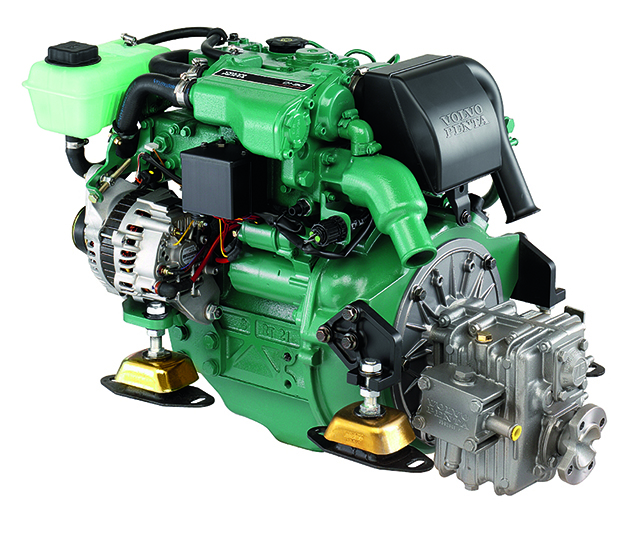
How it works: The diesel engine: The 4-stroke cycle
Understanding how your diesel engine works is key to knowing how to look after it, and fix it when it…

How it works: Looking after fuel: diesel, hoses and filters
Looking after fuel is essential for keeping your engine running smoothly. Callum Smedley shares his top tips
After-sales service
Spectra has one of the best reputations for after-sales service. In most places you’re more likely to find Spectra and Schenker dealers, but that doesn’t guarantee they’ll have parts in stock, and all manufacturers will ship parts to you. Spectra also offers rebuild kits which come with step-by-step instructions and special tools to get to those hard-to-reach O-rings. They feel like a lot of money for a bag of O-rings, but are a cheaper option than sending the unit back to the factory.
If you’re buying new, a warranty is highly valuable but once it runs out you’ll find out how pricey the parts really are. Some manufacturers give longer warranties if a certified technician installs the system.
Most ERD units are made out of engineering plastics such as Delrin which can split around fittings if over-tightened or if warm water is used during cleaning.
One leading UK dealer who sells all brands told me that since Spectra changed the type of plastic used a few years ago he’s had no returns, unlike rival brands. Spectra were tight-lipped on the material they use when Yachting Monthly asked them for details.

An average-sized watermaker will easily squeeze into the space under a bunk
Watermaker instillation tips
A bad installation can render a good machine useless, so there are a few key points to know. Use dedicated through-hulls for the saltwater intake and brine discharge. Make sure the intake is low enough that it won’t be exposed when heeling or in big waves to prevent air bubbles entering the system. Don’t install the intake where there will be turbulent flow, behind the keel, for example, or near the props and rudders. The discharge should be above the waterline.
To give the pump the best chance of producing the pressure needed, install it as low as possible in the boat. Follow the manufacturer’s recommendations on hose diameters and avoid long hose runs and tight turns that restrict flow.
Finally, use correctly sized wiring as the 12V pumps will underperform if there are voltage losses in the wiring.
Monitoring quality
A Total Dissolved Solids (TDS) meter measuring impurities in the output water coupled to a diverter valve can automatically protect the purity of your tank. Anything under 500ppm is fine to drink but a well-installed system should deliver 200-300ppm.
You can buy inline TDS meters, or stick meters that you dunk into a sample cup to monitor it manually. You’ll see it slipping over time if there’s a problem developing with the pump or membrane.

It’s important to flush or ‘pickle’ your watermaker if you decide to not use it for any period of time
Membrane care
The membranes will produce more output and cleaner output in warmer and less salty seas. For the best lifespan, use them every few days. Drying them out, or running chlorinated water through them will do irreparable damage.
According to Dupont, which makes the widely used Filmtec membranes, they should not be left unused for more than 24 hours, but in practice they can be left for around five days before organic growth risks building up on the membrane, which blocks it and reduces performance. This can sometimes be remedied with an alkaline flush if caught early.
The other thing that can block them is carbonate deposits. In this case, an acid flush will restore some of the membrane’s performance.
If idle for a few days, it’s worth flushing the membrane with fresh water. Some manufacturers recommend doing this after every use, but that’s to protect other components in their systems.
If the machine is going to go unused during the off-season, the membrane can be pickled in propylene glycol. Most manufacturers offer branded pickling solutions and restorative solutions which conform to their warranty and don’t react with other materials in the system.
Avoid using the watermaker in anchorages where other boats aren’t using holding tanks. Although the membrane will sift out e.coli, the pre-filters will become a nasty Petri dish of bacteria.

Pickling tablets will be less aggressive on internal metal components
Don’t leave me this way
Different manufacturers have different recommendations, but, as a general guide, here’s what to do if leaving your watermaker unused for any period of time.
1-5 days: In practice, leaving the membrane sitting in saltwater won’t do too much harm, even though the membrane manufacturer warns against more than 24 hours. Check your watermaker manufacturer’s recommendation though. For instance, Spectras suffer from dramatic internal electrolysis if left soaking in sea water.
1-2 weeks: Definitely flush it through with fresh unchlorinated water. Use a carbon filter to remove chlorine if you are flushing with tap water.
More than a month: Pickle it.
They used to recommend using acid (hence the term pickling) but now manufacturers recommend propylene glycol, which is less aggressive on O-rings and other metal components. Buying the branded solution for your machine will give you peace of mind.
If your boat lives in relatively clean water, think about setting a timer so the machine runs automatically every few days for 10-15 minutes. That’s long enough to flush the membrane and prevent organic build-up.
Enjoyed reading this?
A subscription to Yachting Monthly magazine costs around 40% less than the cover price .
Print and digital editions are available through Magazines Direct – where you can also find the latest deals .
YM is packed with information to help you get the most from your time on the water.
- Take your seamanship to the next level with tips, advice and skills from our experts
- Impartial in-depth reviews of the latest yachts and equipment
- Cruising guides to help you reach those dream destinations
Follow us on Facebook , Twitter and Instagram.

Home » Blog » Gear » Watermakers: a guide to marine desalinators and making water on a boat
Watermakers: a guide to marine desalinators and making water on a boat
By Author Fiona McGlynn
Posted on Last updated: March 23, 2022
There’s something magical about a watermaker—at least that’s how I felt after we installed one on our boat. That may sound overblown, but think about it: watermakers transform salt water into fresh water, providing a near-endless supply of potable water for drinking, bathing, and cleaning! THAT my friends is an amazing piece of technology!
(If you don’t share my enthusiasm, try going without a shower for a few days and you’ll begin to see my point).
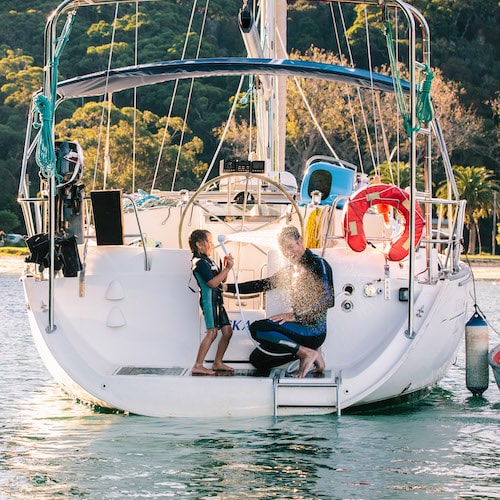
Having experienced living on a boat and cruising, both with and without a marine desalinator, I can attest that it’s a game-changing piece of gear. However, you definitely don’t need one to go cruising. There are plenty of low-tech ways to collect and make water on a boat.
Marine desalinators do offer some major benefits: there’s more water for showers, it’s easier to travel farther afield, you can spend more time in a remote location. However, these benefits have to be weighed against the drawbacks: namely a hefty price tag and ongoing maintenance.
Deciding whether a watermaker is right for you will come down to the type of cruising you’re doing, how much water you need, and your budget. Read on to learn about the pros and cons, costs, and key features of marine watermakers.
Table of contents
- 1 How does a watermaker work?
- 2.1 Benefits
- 2.2 Drawbacks
- 3.1 Powered or handpump
- 3.2 Electric or engine drive
- 3.3 Energy recovery watermaker
- 3.4 Modular, self-contained, and portable watermakers
- 3.5 Automatic flushing systems
- 3.6 Automatic Pressure Regulation and adjustable pump speed
- 3.7 Remote control panels
- 4 Top watermaker brands
How does a watermaker work?
A watermaker on a yacht converts seawater into fresh water through a process known as reverse osmosis (RO). A high-pressure pump pushes seawater through a semi-permeable membrane that filters out salt, organics, and bacteria. The fresh water is pumped into your water tanks while the remaining brine bi-product is discharged over the side of the boat, back into the ocean.
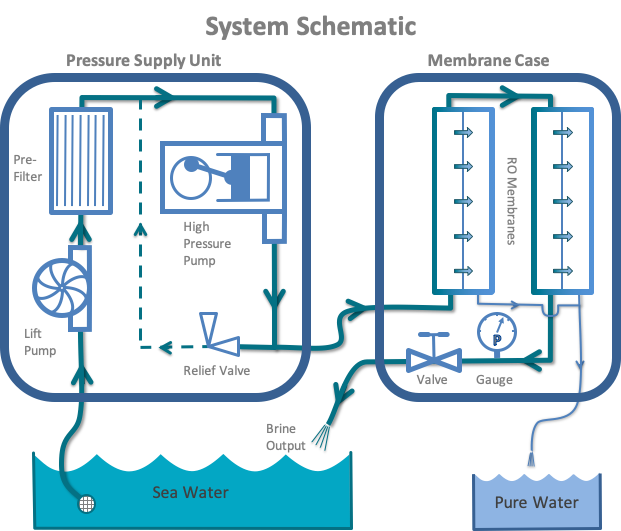
Marine watermakers: the benefits and drawbacks
Less water rationing.
When we started our 13,000 mile trip across the Pacific, we didn’t have a watermaker. We were on a tight budget and decided to prioritize other pieces of equipment like a life raft and wind vane.
As a result, we became experts in conserving water on a boat . We would carefully ration out water for washing dishes, taking showers, and even brushing our teeth!
After getting a watermaker we became far less meiserly because we knew we could always make more water if we needed to. It was a relief to not be constantly thinking about how much water we were using over the course of a day.
That being said, we couldn’t relax completely. We had to keep our tanks topped up, so as not to run the pump dry. We also always carried potable water in reserve, in case our watermaker broke in the middle of a long passage.
More luxuries
Can’t live without a proper shower? A boat water maker can make water-intensive luxuries like freshwater deck washdown, freshwater flushing heads, laundry, daily showers, and even baths, a possibility.
As great as this sounds in theory, we were surprised to find that we didn’t indulge in more showers after we got the watermaker.
We continued to use a hand pump pesticide sprayer to shower on deck despite having a watermaker and shower below. While some of this came down to habit, we also disliked running our engine (and consuming diesel) just to run the watermaker.
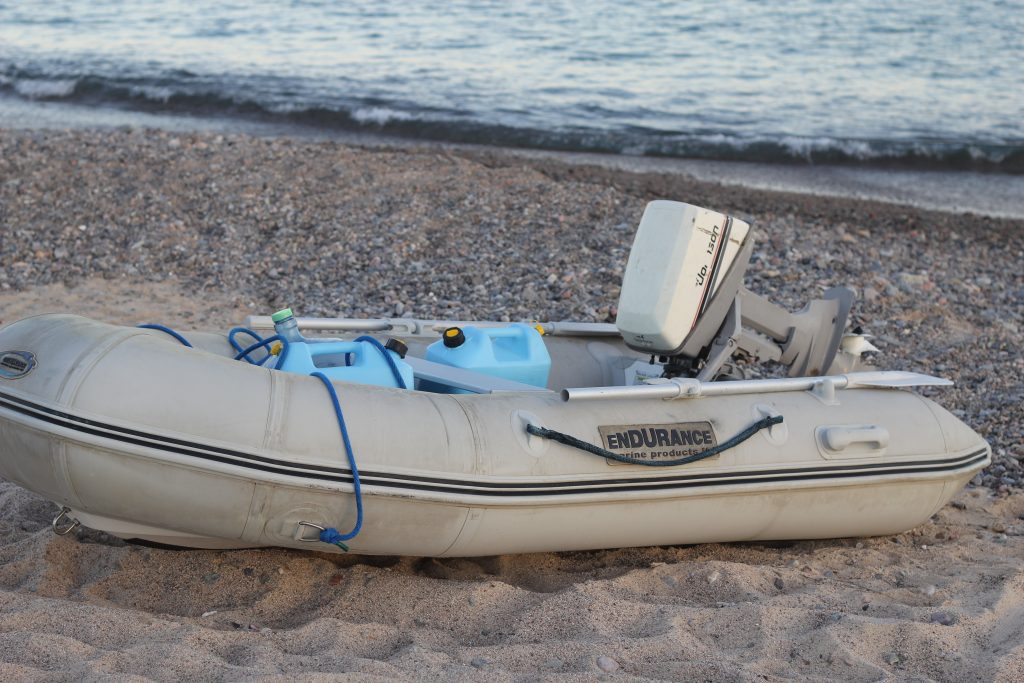
No hauling water
For us, this was by far the greatest benefit of having a watermaker!
While cruising in the US and Canada, we could refill our water tanks at a dock or marina. This was a minor hassle because it involved pulling up the anchor and docking the boat.
In Mexico, it was more challenging to get water. We would fill 5-gallon jugs at the local water purification plant in town and wheel them back to our boat on a collapsible dolly.
It often took a couple of trips with the dolly and dinghy to fill our water tanks. Oh, and we broke our dolly, twice!
We realized that if we wanted to spend more time exploring, and less time hauling water, we would have to invest in a watermaker. When we reached La Paz, Mexico we bought a refurbished watermaker, and we were so glad we did!
Our sailboat water maker gave us the gift of time, especially in places like Mexico and the South Pacific, where there were limited opportunities to fill water tanks up at the docks. It also saved us paying docking and water fees.
We estimate that our boat water maker saved us anywhere from four to six hours every week, time that we could spend exploring the wonderful places we were visiting.
A clean, safe water source
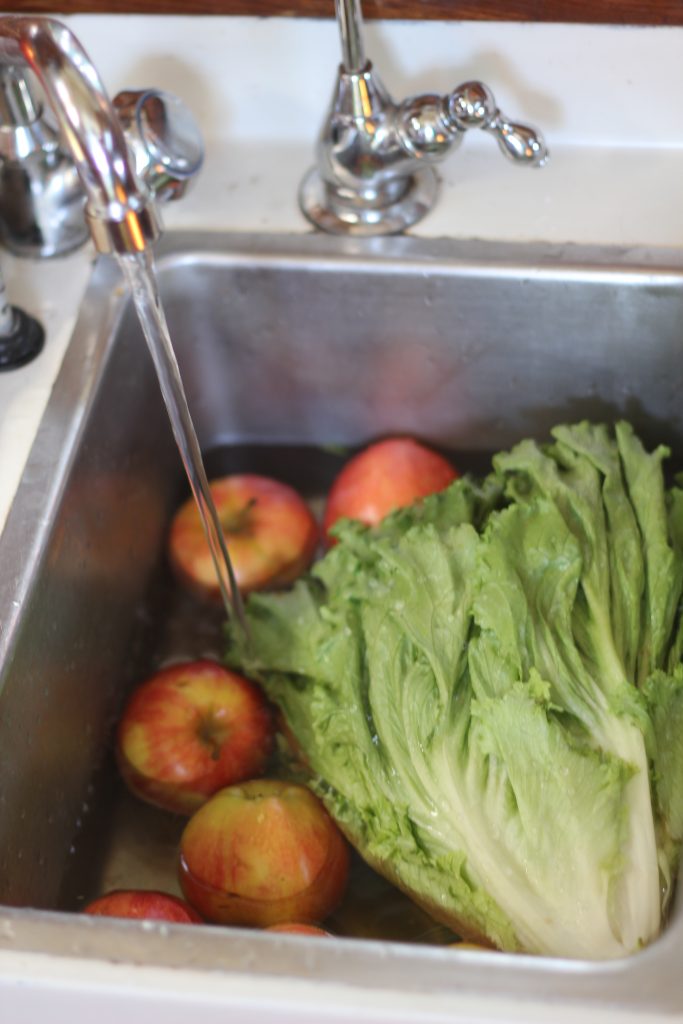
In places where the drinking water may be suspect, a boat water maker can be a reliable source of safe drinking water (assuming it’s in good working condition!).
More time in remote locations
A watermaker is a great tool if you’re drawn to remote locations where you might be the only boat in the anchorage.
It wasn’t until we reached Los Frailes, a secluded village on the Baja, that we really began to think about buying a watermaker.
There we were in an idyllic anchorage, surrounded by spectacular hiking and fishing. There was only one problem—every two days we had to walk 10 miles into town with our water jugs and hope that some kind samaritan would give us a lift back to our boat.
Before having a watermaker, we’d often leave a place we loved just because we needed to fill up our tanks. With a watermaker, we were more self-sufficient and could stay an extra few days, or as long as we wanted!
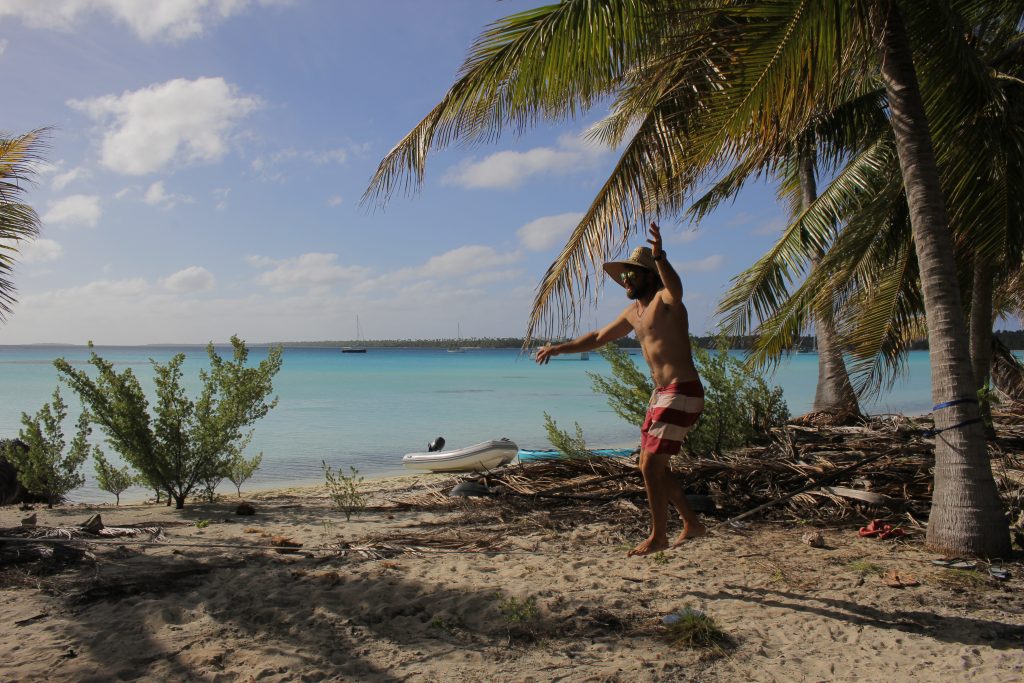
The number one drawback is the cost. We were able to find a refurbished water desalinator for $3,000, which was a great deal but also a considerable slice out of our cruising kitty.
How much does a watermaker cost?
Powered desalination systems for your average recreational cruising boat range from around 3,500 USD to 11,000 USD, with the more expensive options offering higher production (gallons of fresh water per hour).
Ongoing maintenance
Watermakers are yet another piece of boat equipment that needs to be maintained.
The majority of watermaker problems are caused by not using it enough or not using it properly.
If a watermaker is not used for a few weeks, the planktonic organisms in the seawater will die, rot, and clog the membrane and filters. This can eventually damage the reverse osmosis membrane in the watermaker.
For this reason, boat water makers should be used frequently and regularly flushed with fresh water.
Watermaker flushing
Check your manufacturer’s instructions on how to flush.
Rainman recommends flushing the seawater out of the system with fresh water if you are not using the system for more than a day or two. After another week, you need to freshwater flush the system again or pickle it for long-term storage.
Of course, it’s easy to forget, so we made it a rule to freshwater flush our watermaker after every use.
This is one good reason to choose a watermaker with an output that will meet your water consumption needs but not exceed them. If you’re using it every second day, you won’t have to try and remember whether you’ve flushed it or not.
Flushing a watermaker is relatively simple but it does involve a bit of work. We used a system with buckets of fresh water to flush our system and it generally took about 5 minutes.
You can also buy systems that automatically flush your watermaker at pre-determined times—even when you’re away from the boat (more on autoflush systems below).
Whatever you do, don’t use chlorinated water to flush as it will destroy reverse osmosis membranes. It’s possible to buy a carbon filter to remove chlorine from water sources at the dock.
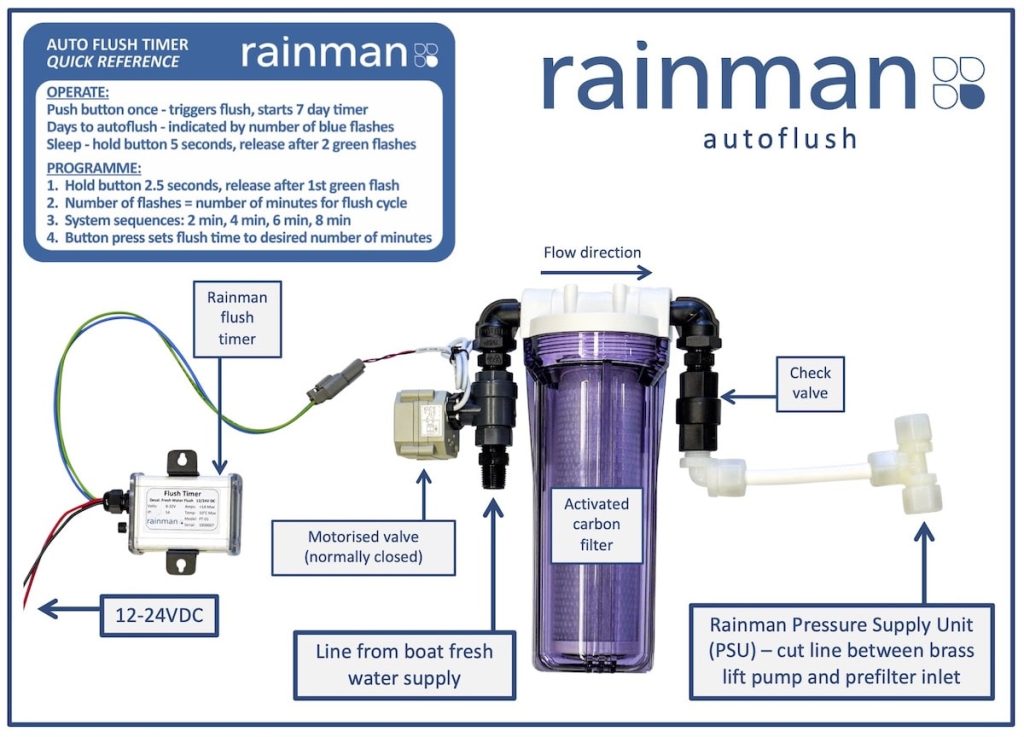
Pickling a watermaker
If you don’t plan on using your watermaker for a while it needs to be “pickled” with a special biocide to prevent growth and buildup which could render your reverse osmosis membrane totally useless.
A watermaker should also be pickled every so often to chemically cleanse the membrane.
In addition to flushing and pickling, you will also need to clean out and replace the raw water pre-filters.
Operating costs
When properly cared for, a membrane should last five to ten years. If you don’t properly flush or pickle your watermaker, it can be a lot sooner and membranes aren’t cheap, generally costing in the range of 200-700 USD.
You’ll also need to purchase pre-filters and pickling solution, which are generally quite affordable. It’s also a good idea to carry spare parts
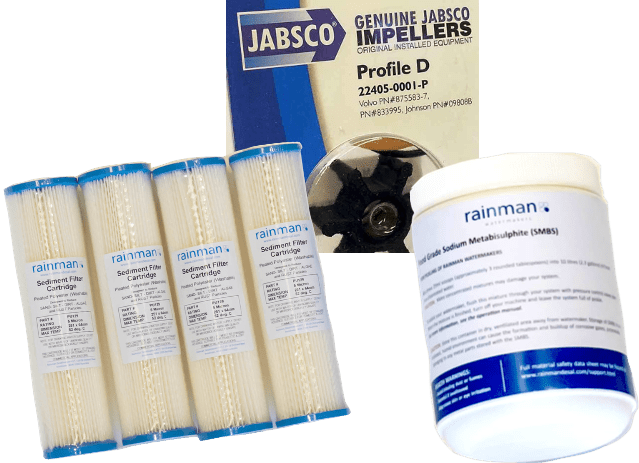
Power consumption
Watermakers can be real power hogs. When Practical Sailor tested a dozen DC watermakers they found they could draw anywhere from 12 to 48 watts per gallon, a huge range in efficiency!
According to Practical Sailor, “for maximum efficiency none of the systems drawing 15 amps or more should be operated without running the engine at the same time.”
We had to run our engine for hours to fill our tanks, which was annoying (and loud) when we were hanging out at anchor and also used up another finite resource—diesel fuel.
In our view, this was the single largest drawback to having a watermaker aboard.
Keep in mind that your power supply will determine what type of watermaker you buy. You may need to upgrade your electrical panels, get a generator or high-powered alternator, add solar panels, or increase battery capacity to supply the demand.
You can’t make water everywhere
While watermakers offer great flexibility and freedom, you can’t just make water in any old spot. If you make water in a polluted marina or anchorage, you’ll risk clogging up your filter. Most cruisers will head out to open water to ensure the saltwater they’re using is as clean as possible.
Key features to look for
Powered or handpump, handpump watermakers.
Handpump watermakers tend to be small and portable, the perfect thing to keep in your ditch bag in the event of an emergency. They’re less expensive than powered watermakers and produce far less water, usually around one gallon per hour.
Though I do know cruisers who have used a handpump watermaker for everyday use, they typically tend to be kept aboard for survival situations.
Powered watermakers
Powered watermakers run off your electrical supply or engine and can produce tens of gallons of water per hour. They tend to be a lot more expensive, but they’re productive enough to replenish your tanks.
Electric or engine drive
Powered watermakers can be electrically driven, by AC or DC, or run off the boat engine.
AC watermakers
AC models can produce in the range of 20-60 gph and are ideal for cruisers with an AC generator or alternator on board. They can also be used on boats with ample solar or wind sources and an inverter.
DC watermakers
DC watermaker systems typically produce in the range of 10-30 gph and are ideal for boats with solar power or 12V battery power.
Engine-driven watermakers
On an engine-driven watermaker, the high-pressure pump is belt-driven. These can produce a considerable amount of water, even on small engines. For instance, engine-driven units produce between 20-60gph, twice what a DC unit can produce.
Energy recovery watermaker
DC watermakers have become more efficient in recent years thanks to energy recovery systems (ERS). When the water leaves the watermaker it is still under pressure. ERS uses a set of valves to make use of this excess pressure to help drive the pump, which can reduce energy consumption by as much as 80 percent.
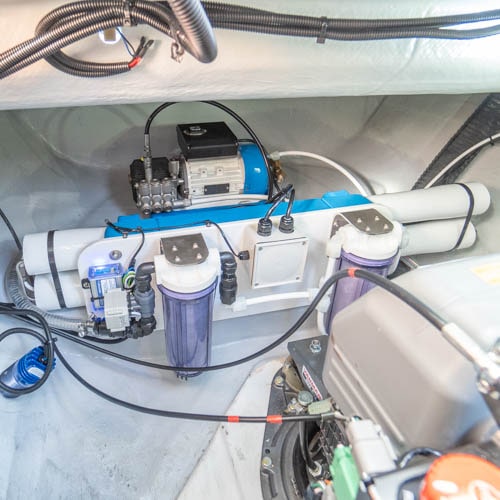
Modular, self-contained, and portable watermakers
Watermakers can be bought as modular, self-contained, and portable units. Choosing the right one may depend on your boat size and layout and whether you’re comfortable installing the watermaker yourself.
Modular units
Modular units come as several separate components that you can mount and connect yourself. This obviously offers a lot more flexibility and is particularly useful on smaller vessels where you may not have a lot of space. The downside is that these systems will take longer to install.
Self-contained units
Self-contained units arrive pre-assembled. While easier to install, they’re often bulkier and best suited to a bigger cruising sailboat with a large engine room.
Portable watermakers
Portable watermaker systems, like the Rainman watermakers, are entirely self-contained. Their compact design makes them easy to move and stow and you can completely avoid a permanent installation.
Simply put the intake and brine discharge hoses overboard, the freshwater hose in your water tank and you’ll be making water in no time.
If you race, have multiple boats, or plan on selling your boat, a portable watermaker is a great option because it can be easily moved from boat to boat.
If we were to buy another watermaker, we would probably opt for a portable one.
Automatic flushing systems
Automatic flushing systems use your boat’s freshwater supply to flush the watermaker for several minutes every few days. These systems require additional components (e.g., a timer, carbon filters, and a motorized valve) and installation but they take a lot of the maintenance out of having a watermaker onboard.
Automatic Pressure Regulation and adjustable pump speed
Your watermaker’s efficiency will be affected by the temperature and salinity of the water you’re cruising in. Cold and highly saline waters (e.g., in the high latitudes) will be more work for your watermaker, so it will take longer to purify.
Some units feature Automatic Pressure Regulation (APR) and adjustable pump speed which can help compensate for fluctuations in water temperature and salinity.
Remote control panels
Some watermakers have the option of a control panel which allows for easier access and remote control. Control panels tend to have a fairly simple interface with just a few gauges but may include a salinity sensor—so you can keep tabs on water quality—and auto-flush integration—so you can flush your watermaker with the flip of a switch.
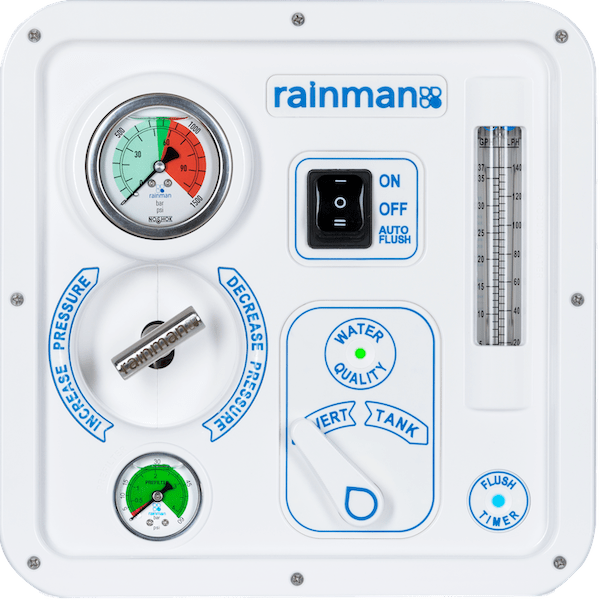
Top watermaker brands
If you’re considering buying a watermaker for a boat, here are some of the top brands to consider.
- Cruise RO Watermaker
- Echotec watermakers
- Horizon Reverse Osmosis (HRO)
- Sea Recovery watermakers
- Schenker watermakers
- Spectra watermakers
Fiona McGlynn is an award-winning boating writer who created Waterborne as a place to learn about living aboard and traveling the world by sailboat. She has written for boating magazines including BoatUS, SAIL, Cruising World, and Good Old Boat. She’s also a contributing editor at Good Old Boat and BoatUS Magazine. In 2017, Fiona and her husband completed a 3-year, 13,000-mile voyage from Vancouver to Mexico to Australia on their 35-foot sailboat.
Terms and Conditions - Privacy Policy

Rainman Watermaker Review: Best Sailboat Watermaker
Rainman watermaker review – Rainman naked 12V system (economy)
We’ve done a full review of the Rainman watermaker to help you make an informed decision before you purchase.
What is a watermaker, and why do you need one?
A watermaker is a piece of equipment you can install in your boat, or any off-grid situation, to make crystal-clear drinking water from undrinkable, salty sea water and electricity.
A lot of people want a sailboat so they can travel independently and visit remote locations. A watermaker essentially removes your reliance on shore support for fresh water; drastically increasing your range and independence while making life on board a lot more comfortable to boot.
Watermakers can seem complicated at first, but they’re actually remarkably easy to install and operate – although some more than others!

As an Amazon Associate, we earn from qualifying purchases. We also earn from other affiliate programs. This means we may receive a small commission on products purchased through our links at no extra cost to you.
In this article we’re going to explain why we decided to buy watermaker in the first place; how we went about choosing a make and model; how we installed it in our cruising sailboat, and why we ultimately decided on a Rainman watermaker as the best watermaker for full-time liveaboards on a sailboat.

How does a watermaker work?
How to choose the best sailboat watermaker
Rainman watermaker review
- Power options
- Size and quantity
- Portable or permanent
- Documentation review
- Installation
How does a Rainman watermaker work?
There are a lot of different watermakers to choose between, but they mostly work in a very similar way – they’re basically pressure-washers configured to force salt water through a very fine filter at high pressure.
The filter, or “membrane”, is specially designed to remove all of the things you don’t want in your drinking water – like bacteria, viruses and salt – and only allow clean water to pass. You can drink the resulting water (it’s usually cleaner than tap water on land!), and naturally you can also use it for all your other domestic needs like cooking and cleaning.

The watermaker needs two things to work: a raw water source, like the sea, and a power source, which on a sailboat is typically your batteries and solar panels. You can get watermakers that run directly off the 12VDC / 24VDC your batteries provide, or from your inverter at 120VAC or 240VAC depending on where you are in the world.
You can also run a watermaker from a generator if you have one, which is a popular approach for boats that consume a lot of water (e.g. charters). A select few manufacturers, Rainman being one of them, even offer units that run directly off petrol – a sort of generator-and-watermaker in one. But which is the best watermaker for a cruising sailboat, and how can you choose between them?

Like anything in sailing, the absolute best sailboat watermaker for your boat depends on your needs and intended cruising pattern – but we’re going to talk you through the criteria we decided were the most important, and how that process ultimately led us to buy a Rainman watermaker.
There are a few thought-exercises we ran through before committing, such as “how much water do we currently use”, but also “do we want to use more than that after we install the watermaker”?
We thought about what we really wanted to achieve by installing our Rainman (read more on this in the Rainman watermaker review section!) – were we looking to cover our existing needs and remove our reliance on shore support, or should this represent a significant quality-of-life upgrade at the same time? And having calculated all that, did we have enough power to back it up? Here’s the thought process we went through.
Step 1: calculate your water needs

Before our Rainman watermaker review – how much water do you actually need?
If you’re reading this article, it’s likely that you don’t currently have a watermaker… and if you don’t, it’s equally likely that you have learnt how to eke out the water in your tanks for weeks or even months at a time!
Prior to installing our Rainman, Emily had perfected the art of taking a full shower in less than one litre of water (0.2 gallons). She would draw it into an empty bottle and often come out with water left over! I however am not known for my restraint and delicacy, and as such was relegated to washing in the sea. As a result of her aqueous austerity, Emily also became the underwater ceramics technician onboard Hot Chocolate (i.e. she does all our washing up, because I waste too much water). All of the above came from our tanks, while water for drinking and cooking came from shop-bought bottles.

And for us, that was the #1 thing – we wanted to remove our reliance on bottled water, because it’s horrible for the environment. It’s also super inconvenient – water was the main thing limiting our range and tying us to shore support. Water weighs 1KG per litre (8.3lb / gallon for our friends across the pond). We drink about 3L each, per day, in the heat of the summer; so we’re looking at hauling 42KG of water per week (6.6 stone) from the supermarket just to cover our basic hydration.
We often cooked in bottled water, too, because a lot of countries have heavy metals like lead and mercury in the tap water and you don’t really want your pasta with a side of poison. We calculated that we were actually getting through about 8L per day combined in food and drink alone, which meant hauling 56KG of bottled water a week under the blistering Greek sun (nearly 9 stone)… and no doubt further inflating our water requirements as a result!!

Then there’s the cost of the bottled water, which is small but does add up, and the added inconvenience of having to make regular bin runs to deal with all that plastic (~38 bottles a week). Bear in mind we’re just two people – if you have a family or regular guests, you’ll need to increase those accordingly.
A close second was the ability to shower whenever we wanted (run away to sea, they said… it’ll be romantic, they said…) – so that’s an extra litre every day or two for Emily, and an extra 10 or 20 for me! Truth be told I was quite happy washing in the sea, but it’s very nice to be able to shower in fresh water for special occasions, or be able to rinse equipment in fresh water after it’s been in the sea (e.g. knives, spearguns…).
A stretch-goal was to have enough water on tap (pun intended!) for me to become assistant-second-in-command underwater ceramics technician, and take my fair share of the washing up. We also quite liked the idea of being able to soak lines, clean the salt out of deck hardware, etc. because that’s something we typically only get to do at the start and end of the season, but that was very much viewed as a bonus. Washing the salt off your gear extends its life dramatically which can be a good way to offset the cost of a watermaker if you’re on a budget.
So in summary, we didn’t just want to cover our existing needs – we wanted a little more to play with as well – but we didn’t go as far as treating it like water on land (showers every day, washing clothes, etc). If you have a washing machine, heads that flush with fresh water, teenagers that seem to be waging war on their microbiomes with endless soapy showers… you’ll need to account for those as well.
We estimated our water needs to be:
Drinking: 3L / person / day;
Cooking: 0.5L / person / day;
Personal hygiene: 5L / person / day (e.g. a 10L shower every other day);
General needs, e.g. cleaning: 1.5L / person / day;
Total: approx. 10L / 2.2 gallons per person, per day – meaning 20L total per day.
Step 2: Calculate your power needs (and how you’re going to meet them)
Some brands of watermakers are more efficient than others, but from our own experience and from talking to others, it seems like it takes around 10 Watt-hours to make a litre of water – i.e. about 0.8 Amp-hours from a 12 volt battery. Your mileage will vary based on things like the chemistry of your battery bank, the length of your cable runs, and even the temperature of the sea, but that seems to be a pretty usable yardstick.
Our Rainman watermaker draws about 28A when it’s running, and makes about 34 litres per hour.
Because we’re full-time liveaboards, and working remotely from the boat as well, we already have quite a lot of solar – for a monohull, at least – 360 Watts of mono panels. In theory they should push a good 30 Amps into the batteries in full sun, but in practice it peaks at more like 20A and we make a total of 2.2kWh (2200Wh) in an average day.
We need to make 20L of water per day to keep up; that means we need to allocate 200 Watt-hours from the 2200 we make in a day; i.e., installing our Rainman increased our overall power needs by about 10%.
For comparison, Emily’s laptop draws about 90W an hour and mine draws 120W, so running our Rainman watermaker for an hour a day is about the same as running both our laptops for the same period. A 12V fridge often draws about 3 amps, so about 36W – meaning keeping the fridge running consumes ~850Wh per day, about 4 times more than our watermaker.
Honestly, I imagined it would take a lot more!
Of course, our solar output drops drastically as the Autumn / Fall rolls in, but then so do our water needs… so it’ll be interesting to see how that pans out and whether we’ll need to augment it with fossils fuels, e.g. making water after motoring.
⚡ Note: We have recently upgraded our battery setup to lithium marine batteries from the wonderful BattleBorn. We highly recommend them. You can find out more here . ⚡
See the FAQs at the end for more information.
Step 3: Your cruising pattern
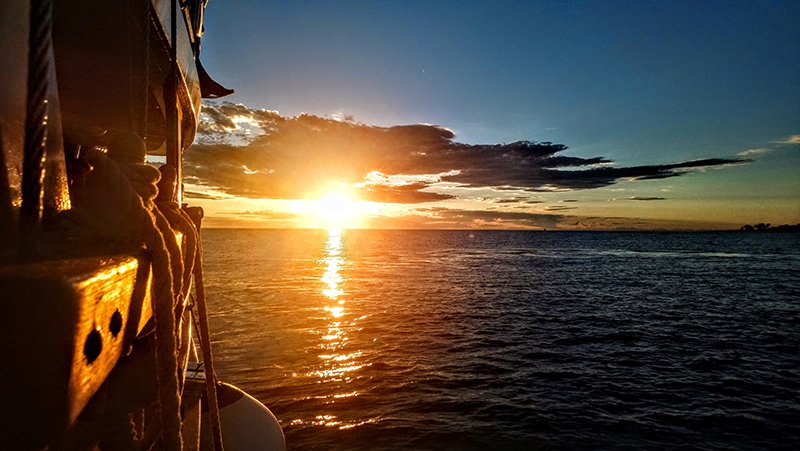
Everyone’s needs are different, and it’s important to factor them in when choosing a watermaker.
One of the main reasons we were drawn to Rainman watermakers is that they use all off-the-shelf, standardised parts. If your Rainman breaks down, it almost doesn’t matter where in the world you are – you’ll likely be able to get standardised spares in the nearest major city. We won’t name any names, but in our quest to identify the best watermaker for our sailboat we discovered that a lot of manufacturers use proprietary parts – ones you can only get from the manufacturer.
We considered this to be extremely undesirable, because
(i) as a cruising sailboat, we want to be able to service our watermaker anywhere in the world
(ii) it can lead to price-gouging, i.e. they can charge whatever they want for spares because you can’t get them anywhere else; and
(iii) – it demonstrates an astonishing lack of awareness on the part of the manufacturer.

Your mileage may vary, but we bought a watermaker for the independence. In fact, we more or less bought the whole boat for independence! Trading a reliance on bottled water for a reliance on obscure, single-source, non-standard parts completely defeats the object.
I have worked in technology all of my life, and for every instance where proprietary parts were truly necessary I could show you 20 more where it was simply an attempt to create a “walled garden” and force you to buy overpriced spares from the manufacturer themselves. In a further handful of cases, it’s to force planned obsolescence and make you throw away an old unit rather than repairing it – which again, is the opposite of how we try to live.
In a non-watermaker example, this is exactly the reason we were forced to replace our windlass in our first season. A simple, $5 helical gear stripped, but because it was proprietary and the manufacturer had long since gone bust, we had no option but to replace it in its entirety – at a cost of about $1500, and all the needless waste accompanying it. We found a machine shop who could copy the stripped gear, but it would have cost nearly $1000 anyway after set-up costs. Not everyone will agree with us but we found that a horrible waste and just an awful design philosophy, and we cursed that manufacturer in a way that would make Blackbeard blush as we hauled up 80M of muddy chain by hand…!

So try to think about your intended cruising patterns and how awkward it would be if you needed spares. If you typically cruise the same grounds, it’s unlikely to affect you that much. If you’re planning an expedition or a circumnavigation however, you’re likely to want to look for manufacturers with a practical design philosophy like Rainman.
Ask around in forums and social media groups and try to gauge what it’s like to deal with the manufacturer. How self-serviceable are the units? How reliable are they? Again, this is something that led us straight to Rainman watermakers. The units have a reputation for being absolutely bulletproof; the pre-sale communication was outstanding, you can get spares anywhere in the world and (nerd alert) the documentation is outstanding too.
Although we eventually went for a fully-installed unit, we also loved the fact you could get a portable version that stows away in a locker or can even been taken in a bail-out situation if you have a 12V source to run it from. You can use the same Rainman watermaker in salt water or brackish (mixed salt and fresh) just by adjusting the pressure level, where some manufacturers require you to purchase a specific unit for each. While we didn’t actually need a lot of these features we appreciated that Rainman was grounded in real-world use cases and had given us that flexibility.
You should also consider if you really need a watermaker. Yes, they are wonderful. Yes, they are basically magic. Yes, it would be nice to be able to stand downwind of your significant other without a peg on your nose. But they also cost about $5,000, and you do have to keep using them every 2-3 days or fill them with pickling solution, else they will foul up and ruin the membranes (Rainman has an “autoflush” unit that makes this a lot easier, see below). If you don’t live aboard full time, you might actually find it an inconvenience!
Rainman Watermaker Review: Rainman 12V Naked
Having considered all of this, let’s talk about the Rainman Naked 12V unit we eventually bought, and why – although the reasons should already be becoming apparent! Here is our honest Rainman watermaker review – warts and all.
Rainman Watermaker Review – The Parts

A Rainman system comes in a few separate parts, which you can configure to suit your needs.
The pressure supply unit, aka. PSU. This is the pump that draws water from the sea, and then pressurises it ready to be forced through the membrane.
The RO unit. RO stands for reverse osmosis, which is the process a watermaker uses to filter the water. The RO unit therefore is a long tube containing the specialist filters that let it separate clean drinking water from salty sea water. The PSU pressurises sea water and sends it into the RO unit. Out of the other end, you get a small amount of pure, clean, drinking water, and the waste product – brine.
Control panel. Rainman make an optional control panel that lets you start and control the unit remotely from somewhere else in the boat. We installed our Rainmain in a pretty awkward location (in a lazarette under the cockpit), so we were very grateful to be able to mount the control panel somewhere rather more accessible! The control panel has instruments that tell you the pressure the system is operating at, how much water you’re making, and even the quality of the water (via a traffic-light system). You can also use it to control the autoflush function (see below).

Autoflush. Another optional extra, but one we would highly recommend. As detailed earlier in the article, you have to run a watermaker very regularly else marine life will grow on the filters and ruin them. The best antidote is regular, even daily, use, but you can also fill the unit with “pickling” solution that stops the fouling from growing. Generally speaking, that means you run the watermaker 2 – 3 times a week while living aboard, and then pickle it in the off-season when the boat is on the hard standing or home berth. It’s a bit of a pain, but not nearly as annoying as lugging 50KG of water from the nearest supermarket and / or chronic dehydration.
Enter the autoflush. Once a week, or at another interval of your choosing, the autoflush will open a valve and take fresh water from your tanks to flush the membrane and prevent fouling. This extends the life of the membranes significantly and removes human error from the equation. Considering an average sailboat has north of 10,000 moving parts to worry about, we’re big fans of anything that essentially maintains itself! You’ll still need to pickle if you don’t run the unit for 30 days, but if you’re like us and can stretch a tank of water to 14 days or more it’s really convenient.
Rainman Watermaker Review – Your Power Options

When specifying a Rainman system, you have three basic choices to make :
- Power source
- Portable (cased) or permanently installed (naked!)
Power source. When buying a Rainman, you can choose between three different power sources:
- AC electric . An AC electric unit runs off mains power, i.e. 120VAC or 240VAC depending on where you are in the world. That mains power in turn can come from a few sources: if you have an inverter, like many cruising sailboats, you’re already making mains power from the 12VDC / 24VDC supplied by your battery bank. You’ll need an inverter that can supply 1250W, although 1500W is recommended. You can also get mains power from the shore, via your shore power connector – although if you spend a lot of time on shore power you might not need a watermaker at all! If you have a generator on board, there’s a high probability your generator is also outputting mains power as well. AC electric units are much faster than DC, and can produce about 4X as much water per hour – while consuming about 3X the power, so they’re more efficient as well. The best option for boats that meet the power requirements, particularly larger boats, boats with power to spare, boats with high water consumption (e.g. charters).
- DC electric . This is the option we chose, for reasons we’ll explain. DC electric means the unit runs directly off your 12VDC batteries. At the time of writing, I don’t believe Rainman make a 24VDC unit, but 24VDC boats can just use the AC version above via an inverter.
The DC version makes a lot less water per hour than the AC version, because of nerdy reasons related to DC and current. A DC system tops out at 34 litres per hour, where an AC can make up to 140. They’re also somewhat less efficient, although if you’re using an inverter to make AC you should bear in mind your inverter is typically wasting 10 – 20% in the process so the numbers aren’t quite as clear-cut as they seem.
It’s marginally quieter than the AC system, but you need to be able to position it fairly close to your battery bank because again, nerdy reasons to do with DC.
We chose the DC unit because:
- Our inverter is only 1200W, and we didn’t want to have to upgrade it to meet the requirement.
- Our generator is also only 1000W, and we prefer not to use it unless we have to.
- Our water needs are only ~20L a day, so we didn’t really care about making water slowly. One hour a day would easily cover out needs.
- We could easily install the Rainman 3ft from the battery bank, so the cable run wasn’t an issue.
- Petrol. Rainman also make a unit that runs directly off dead dinosaurs. Essentially, it’s a suitcase generator like the popular Honda EU-series with a pressure supply unit bolted on (the genset inside is actually a Honda GXH50 4 stroke). It’s a great idea, particularly if you’re using a Rainman in a non-boat scenario (bugout cabin, disaster relief, etc). You can burn fossil fuels directly to make water without the need for a separate generator. I can definitely see the applications, and although it wasn’t relevant for us, it’s another example of how Rainman’s design philosophy seems firmly grounded in the real world. If you liked the sound of the control panel or the autoflush unit, bear in mind you can’t use them with a petrol unit. Rainman says the unit burns about 600ml of petrol per hour, which at today’s gas prices is about EUR 0.70 per hour, or one Euro of fuel for 200L of water.
Rainman Watermaker Review – Size and Quantity Options

Once you’ve decided on a power source, you can then choose the size and quantity of RO membranes to go with it:
- The AC and petrol units can both take two full-size membranes for maximum output – and you’re encouraged to go down that route, because the increase in water output far outstrips the increase in power consumption. Alternatively, you can fit one full-size membrane if you’re really on a budget, or there’s a cute compact unit with two half-size membranes if you’re seriously short on space and/or weight! For 90+% of boats the first option is the best and there isn’t much reason to consider the others. With two full-size membranes you can expect to make 100 – 140 litres of water per hour. With a single membrane, or the two half-size units, you’ll make 50 – 70.
- The DC unit only supports a single full-size membrane – there are no other options. You’ll also make less water than an AC or petrol unit using the same membrane – about 30 litres per hour. If you’re a family, or you have high water needs for some other reason, you’ll likely want to try to get up to an AC unit with two membranes as you’ll make up to 5X as much water per hour. For us, that wasn’t really relevant – it was the difference between making water for 20-30 minutes a day, or an hour. It didn’t seem worth upgrading our inverter or buying a larger genset.
Rainman Watermaker Review – Portable or Permanently Installed

And finally, decide whether you prefer a portable (cased) or permanently-installed (naked!) system:
- If you want petrol, it only comes in the portable, cased form factor. Note that you can’t use the control panel or the autoflush with portable form factors.
- AC or DC electric units can either be portable or permanently installed. The same caveats apply regarding the autoflush and control panel. The cased form-factors come in a rugged, blue plastic case that seems like it will stand up to a lot of abuse.
Portable systems are good if you simply don’t have space to permanently install the unit, and they offer the flexibility of being able to stow your Rainman in a locker when not in use. The PSU needs to stay quite cool while in use, and operating the unit in the open air is a pretty solid guarantee that it will. They’re also great if you don’t have a spare through-hull and you don’t fancy cutting a hole in your boat – you just dangle the hose over the side, making sure it’s good and deep but not amongst any fouling. However, you add a lot of man-hours to your watermaking operation (setting up, packing down, manually flushing…), which should definitely be factored in. You can’t autoflush, and you’re more likely to make a mistake – sucking up air or fouling can damage the unit, and the more times you manually dangle a hose over the side the greater your chances of doing so.
On Hot Chocolate, we already had two perfect, spare through-hulls from where the engine-driven fridge compressor used to be. One of them is deep down in the keel, allowing for a clean bite of water with near-zero chance of fouling or air bubbles. We can make water while underway without needing to watch the hose. The latter was perfectly positioned above the waterline so we can observe the brine output and check it for bubbles (part of the procedure for making water). This made choosing a naked system a no-brainer for us, but I think even if we didn’t have the spare holes in the boat we would probably have made the same decision.
And that’s it – that’s your three basic choices . If you went for a naked system you have a further two optional extras in the form of the control panel and autoflush, both of which represent pretty significant quality-of-life upgrades if you can afford them – but it’s still a fantastic piece of kit if you can’t!
Rainman watermaker review of the installation documentation
I know we’ve already mentioned this, but the documentation is really excellent and it’s clear there has been a lot of thought put into the product. It’s evident Rainman expect people to self-install, whereas when we spoke to one of their competitors (who we won’t name!) they stated “if you need to ask us any questions you shouldn’t be installing it”! Again, this shows a level of pragmatism, forward thinking and just common sense on Rainman’s part that we sometimes found lacking in competitors.
If you’re a manufacturer reading this, please understand that cruising yachts absolutely are going to install and maintain their own electronics, and we’ll desert you in droves if you try to lock us out!
Reviewing the Rainman watermaker installation process

We were pleasantly surprised to find that the unit came with almost everything we needed to install it. We were expecting to supply our own hoses, sundries, etc. but Rainman supplies everything you need – hoses, jubilee clips, hose splitters, T-valves… while we were installing it our local chandlery told us a horror story about a boat who had been waiting eight weeks for a replacement hose for their non-Rainman watermaker, so we greatly appreciated the completeness of the kit! I believe the only items we had to add was a splitter to tee the fresh water output into our tank, because we have the flexible plastic variety and the supplied fittings assumed a conventional solid tank. We happened to have one on board, so our additional material overheads were exactly $0.
Installation was really very straightforward. End-to-end it took me two days to install and test the unit, plus an extra day to get the autoflush set up.
We had a tiny teething problem in that one of the hoses was supplied with an adaptor, and we needed to remove it to screw it in correctly. We raised a ticket with Rainman, they replied in about 2 hours, and had already followed up to see if we were sorted by the time we read their first email!
Only basic hand tools were required to complete the installation, and in fact most of the connections are toolless (e.g. push-fit connectors). We’re now about three weeks into our ownership, and so far, I can honestly say we don’t have a bad word to say about either the company or the unit itself. Our intention is to update this in 6 – 12 months once we’ve had our Rainman for a season and let you know how it shapes up!
Our Rainman arrived from Australia to Greece in a little under 3 weeks, although Greek customs took a further 3 weeks to clear! We ended up having to pay a total of EUR 1100 in VAT and import duties, which was about what we expected. We’ve heard of people not getting charged anything, so it seems to be a bit of a lottery. The biggest hurdle we faced importing it was getting an EORI number (a Greek tax code for imports worth more than EUR 1000). We ended up using our boatyard’s EORI number, meaning they paid customs and we paid them back.

If you have any questions about Rainman or watermakers in general, feel free to use the comments section below and we’ll do our best to help. We’ve also tried to compile some answers to the questions we had when we started this journey and some of the most common ones you see online ( find this section below ). If this review was useful to you, please consider sharing it or joining our newsletter for more quality content and awful puns!
Check out Rainman products here.
Can I run a watermaker off an alternator?
Yes, you can use the power from your alternator while motoring to run your watermaker. Just be aware that if you’re underway, you might be creating bubbles… and if you suck up a bubble it can damage your membranes. Make sure the intake hose is good and deep and your wake is free of bubbles, or just bank the power and make water when you get to the other end.
Can you drink water from a watermaker? Is it good / bad for you?
Absolutely. When your watermaker is functioning correctly it should make water with around 300PPM (parts per million) of contaminants. Safe drinking water is usually 500 – 800, so in most cases, it’s actually cleaner than the water you usually drink!
How to take care of a sailboat watermaker
The number one enemy of watermakers is fouling. When you suck up sea water, it contains billions of microorganisms like plants and algae. Your watermaker filters them out, but some of them get caught in the membrane and can start to grow. The best way to take care of a watermaker is to run it very regularly to flush the microorganisms out before they get a chance to take hold. Run your watermaker every 2 – 3 days minimum, pickle it when not in use, and strongly consider getting a system with an autoflush function like a Rainman – it will make your life a lot easier.
How much water does a Rainman watermaker produce?
It varies, but between 30 litres an hour for a smaller unit or up to 140 litres an hour for a larger unit.
How much electricity does a sailboat watermaker need?
It depends on the size of the watermaker, but basic units consume around 400W, and bigger units around 1.2kW.
Can I run a watermaker off solar power? Do I need a generator if I have a watermaker?
Absolutely, you can run a watermaker off solar power. We have a 400W unit that we run from our 360W panels, via our 12V battery bank. We rarely need to generate in order to make water.
12V vs mains-powered watermakers
Mains-powered watermakers are generally more efficient, producing more water both per Watt and per hour. However, you need a fairly large inverter or generator to use a mains-powered unit. We opted for a 12V system because we didn’t need the speed of a mains-powered system, and we didn’t want to have to upgrade our inverter to accommodate one. You can find more information about why we chose a DC system in the body of this review.
Can you use a watermaker to make water from a river?
Some watermakers can make water from brackish water as well as salt. Some manufacturers require you to specify at the point of purchase, whereas others (like the Rainman) can handle it with a simple pressure adjustment. Just be sure to read and follow the manual carefully or you can damage your membrane.
Solar still vs boat watermaker?
A solar still is a device that makes clean water by evaporating sea water. It’s a great piece of kit to have in a grab-bag, particularly if you’re attempting a longer passage. You can get inflatable solar stills that fold down to the size of a pack of cards. Solar stills are excellent emergency gear but not a replacement for a watermaker, because they typically only make 1-2 litres per 24 hours – vs 2,000+ litres per 24 hours for a watermaker. Their principal advantages are portability and the fact they don’t need any electricity to operate. Both have a home on an ocean-going sailboat!
DIY watermakers
A number of plans circulate online for DIY watermakers. Watermakers are essentially pressure washers that force sea water through a membrane or filter to produce clean drinking water. It’s reportedly possible to build your own using off-the-shelf components (like pressure washers!), and save perhaps $1000 vs buying a pre-configured watermaker. While we’ve heard a lot about the concept over the years, we’re yet to meet a sailor who has built one themselves. Let us know in the comments if you’ve built one and how it’s working out for you!
Watermakers VS Brita filters, filter jugs, lifestraw, etc.
What’s the difference between a water filter jug and a watermaker, and why does one cost $10 while the other costs ~$5000?
Filter jugs use filtration and something called “ion exchange”, meaning the water trickles through a pad made of something like cotton to remove large particles, and activated charcoal or ion exchange resin which reacts with and “grabs” semi-volatile organic compounds out of the water. Sometimes they also use silver, which is antimicrobial, or UV light to kill out bugs. Filter jugs typically can’t remove heavy metals like lead and mercury, and they certainly can’t desalinate water (remove the salt and make it safe to drink). For that level of filtration you need to pressurise the water and use a much more sophisticated filter called a “reverse osmosis” membrane, hence the cost and complexity of a watermaker. The closest cheap equivalent is a solar still (see above).
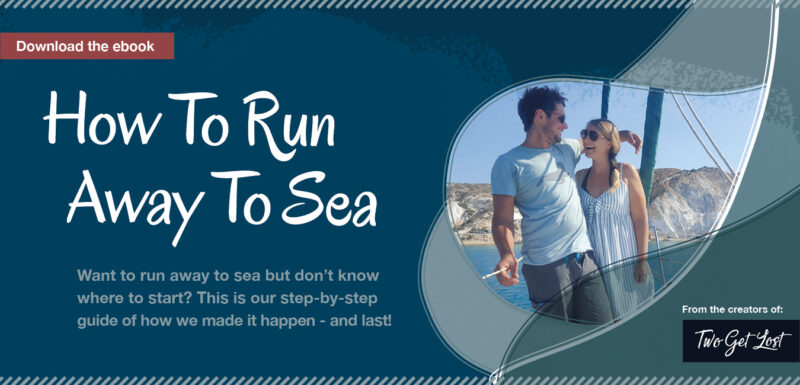
Similar Posts

The 15 Best Sunglasses For Sailing 2024
Tepai cruising tax-how to pay online.

Must Have Galley Equipment For Sailboat Cooking 2024

The 55 Best Sailing Gifts For Sailors 2024

The Best Tenders for Yachts 2024

Travel Insurance For Sailing 2024
13 comments.
Thanks for the detailed review and analysis of the various pros and cons. I plan to get a Rainman for my boat – also in Greece and am weighing up the options. Good practical advice about the autoflush option! Also, I notice you didn’t buy it from the Greek distributor – is there a reason?
Hello, thanks for the comment, and glad it was useful. We have to admit that out of all the upgrades we’ve made to the boat, this is the one that has run the smoothest – the whole process. We’re very, very happy! The reason we didn’t buy from Greece was as simple as price. Adam actually emailed Rainman with a whole bunch of questions (he likes to do his research!) and they cut us a very good deal that made it cheaper to buy from them. It was marginal though so if we hadn’t been out of the water all winter and had been in a rush to get our hands on it we would have bought from Greece. Hope that helps!
This is the best watermaker review I’ve read, haha! I was going to buy Spectra but now I’m seriously considering Rainman.
Thanks! Honestly would recommend it. Let us know which you go for and how you get on!
A very comprehensive and informative review, I’ve been researching these products for some time and can find very little to help me make a decision, can you also let me know how long you’ve had yours and if this has been reliable? I really want to make the right decision when I get one.
Hello, thanks for the comment. Glad we could help! We’ve had ours for a year now and it’s one of those bits of boat equipment that we just don’t think about because it works so seamlessly. Probably the best thing we’ve invested in for the boat (it was expensive but worth every penny!) Let us know if you go for the Rainman and how you get on.
Will do. I follow your blog closely, I’m a big fan of your lifestyle and your honest writing style.
what a great article, I love how honest and balanced this is. 5 stars
Thanks Rachel, really glad you found this useful and hope you do go for a Rainman watermaker. It’s one of the best purchases we’ve made for the boat!
So, you don’t g the specifications for the 12 volt model, what is the AMP versus gallon output ?.
was sent this article by a friend and it did not dissapoint. very thorough and clear explanation. can you review spectra next? ty
Thanks for your feedback and so pleased you found the watermaker review useful. If we ever go a different route in the future we will definitely give some honest feedback on whatever watermaker we opt for!
Comments are closed.
- BOAT OF THE YEAR
- Newsletters
- Sailboat Reviews
- Boating Safety
- Sails and Rigging
- Maintenance
- Sailing Totem
- Sailor & Galley
- Living Aboard
- Destinations
- Gear & Electronics
- Charter Resources

Do You Need a Watermaker for Your Sailboat?
- By Jen Brett
- Updated: October 2, 2019
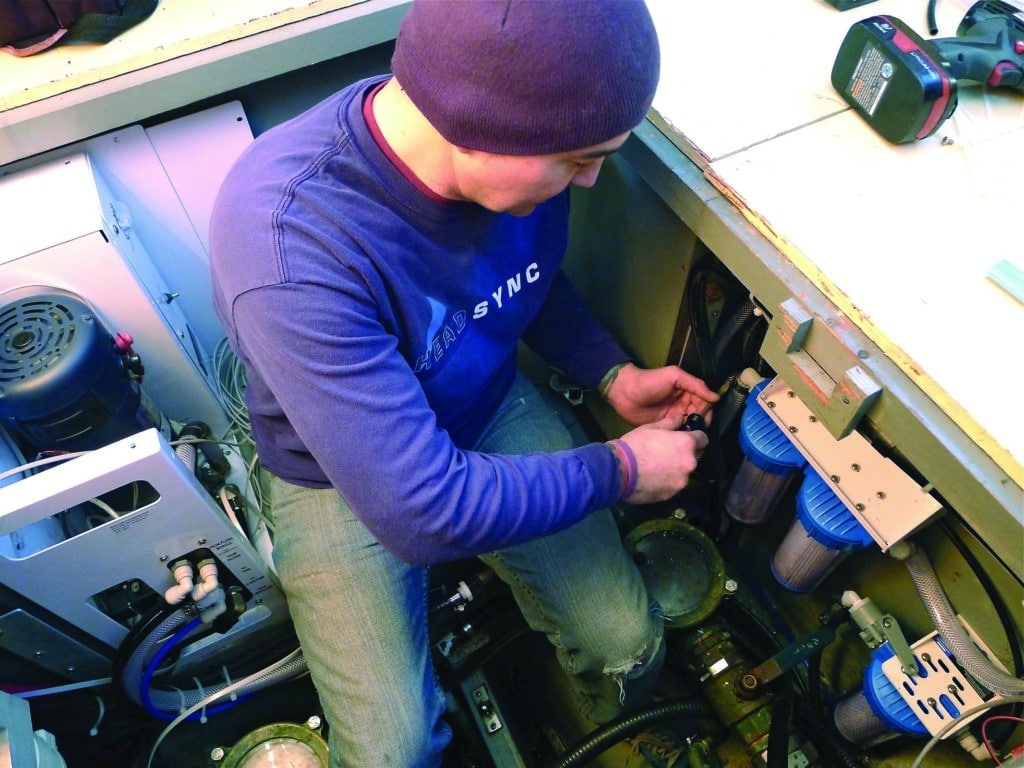
I remember, in the not too distant past, when having a watermaker aboard a cruising boat seemed to be the ultimate luxury. Plenty of sailors considered them too expensive and complicated. Fortunately times have changed. With improved technology and a range of price points on the market, now even average cruising boats of modest means carry a reverse-osmosis system. And really, is there anything that feels better after a day spent sailing and swimming than a hot shower? The freedom and security that come with full water tanks are also a nice bonus, particularly if you’re cruising in an area where fresh water is difficult to come by and pricey when you do.
Choosing a Watermaker
As with any major system, there are many factors to consider when you choose a watermaker. You’ll need to figure out your freshwater needs, the space you have available for the system and how you’re going to power it . Generally speaking, in a reverse-osmosis desalination system the raw water is run through a series of pre-filters, and then a high-pressure pump moves the water through one or more membrane housings. The wastewater, or brine, is released overboard and the product water goes into your water tanks.
Since all of the watermakers that are currently available for cruising sailboats use this process for desalination, the major differences between the systems are how you power the high-pressure pump and the user interface. Powering options include 120/220-volt AC, 12- or 24-volt DC and engine/belt driven. All have their pros and cons.
“The first question I ask a potential customer is ‘Will your boat have a ship’s generator?’” said Rich Boren of Cruise RO Water. “If they plan to have a generator, then the decision to go with a 120-volt high-output watermaker seems natural. While running the generator for battery charging and other loads two to three times per week, they can keep their water tanks full without having to make generator runs just to make water.”
A 12-volt system, such as the Spectra Catalina 300 Mk II or the Horizon Reverse Osmosis Seafari Quest, makes a lot of sense for smaller cruising boats since they don’t need a generator to run and have fairly miserly power consumption. On a breezy, sunny day, a solar panel and/or a wind generator will likely keep up with the demand. “The only difference between 12-volt DC low-output and 120-volt AC high-output watermakers is how the high-pressure pump brings seawater up to the 800 psi needed to drive fresh water through the reverse-osmosis membrane,” Boren said. “The membrane and support equipment, like pre-filtering and plumbing, are the same.”
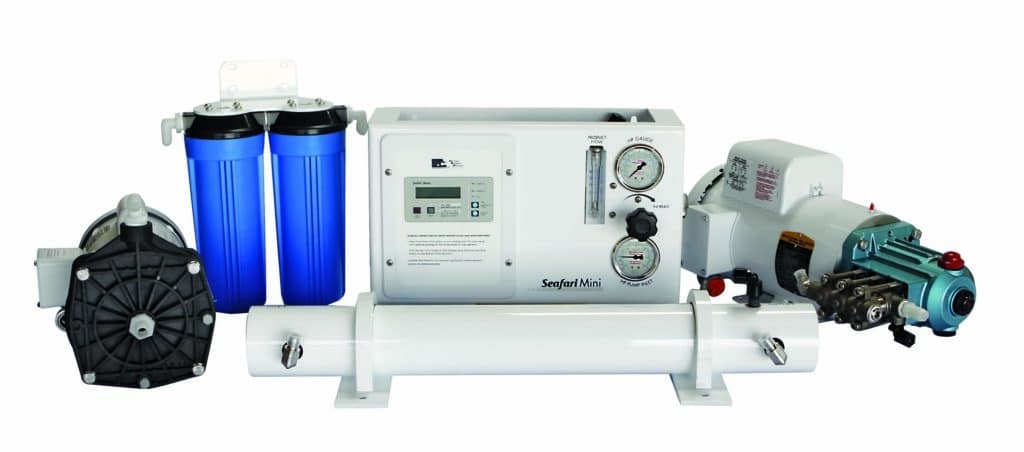
These systems typically produce anywhere from about 6 to 16 gallons per hour, and some units can do so for about a 1-amp-per-gallon power draw.
“Many smaller sailboats, under 45 feet or so, often utilize solar panels,” said Berkeley Andrews of Parker Hannifin, which produces Sea Recovery, Horizon Reverse Osmosis and Village Marine watermaker systems. “Their entire electrical backbone consists of 12-volt or 24-volt. So they must have a watermaker that can operate on low voltage. These customers have limited amp hours on their batteries, so all of their equipment must be suited to handling this.”
In choosing a watermaker, Bill Edinger, owner of Spectra Watermakers, said to be realistic about water needs. “When helping customers decide which system is right for them, first we like to determine their approximate water usage with questions like ‘How many people are aboard normally? Are you going to be living on the boat full time? Do you have a washing machine? Any children? Are you going to be cruising full time or leaving the boat for extended periods?”
A common error people make is choosing a watermaker that is too small for their needs. “The most common mistake I see cruisers making in their watermaker purchase decision is underestimating how much water it will take them to cruise comfortably,” Boren says. “I’m not talking about the minimal amount of water it takes for the crew to stay alive, because there is a big difference between staying alive and comfort. Selecting a watermaker that will only meet their minimal drinking-water needs but not keep up with the comfort needs of the crew can lead to crew tensions and feeling like camping rather than cruising.”
Remember that “watermakers are rated in gallons of production in a 24-hour period,” Edinger said. “So a 300-gallon-per-day watermaker system sounds like a lot of water. The important thing is that it produces about 12 gallons per hour. Normally a system like this will be run three to four hours per day if power is not a critical issue, in this case producing 36 to 48 gallons of water. It’s better for a system to run for a few hours every few days than an hour every day.”
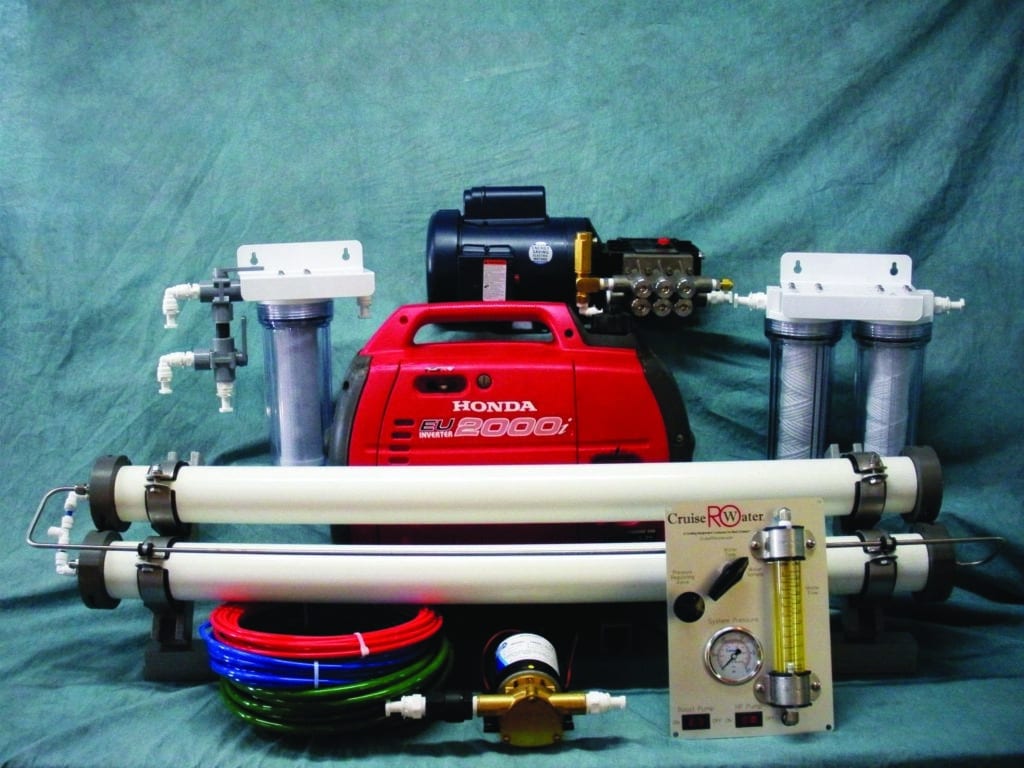
Watermakers for Small Boats
If space is at a premium, consider purchasing a modular system instead of an enclosed one. In a modular system, the components, such as the membranes and filters, can be mounted separately. Another power source for the high-pressure pump is the boat’s diesel engine. In these engine-driven setups , the pump and an additional pulley are mounted on a custom bracket next to the engine. The watermaker can then be run while motoring or using the engine to charge the batteries.
While engine-driven watermakers can produce a large amount of water, 20 or more gallons an hour on average, the downside is that the installation can be more complex than for other systems. “Unlike the 12-volt DC or 120-volt AC watermakers, where you simply bolt the high-pressure pump down and then run the wires and plumbing hoses, the hardest installation aspect of an engine-driven watermaker is finding space. Some boats simply have no room in the engine compartment to mount the 5-pound pump with a 7-inch pulley on the engine while still leaving access to other engine parts that need to remain serviceable,” Boren says.
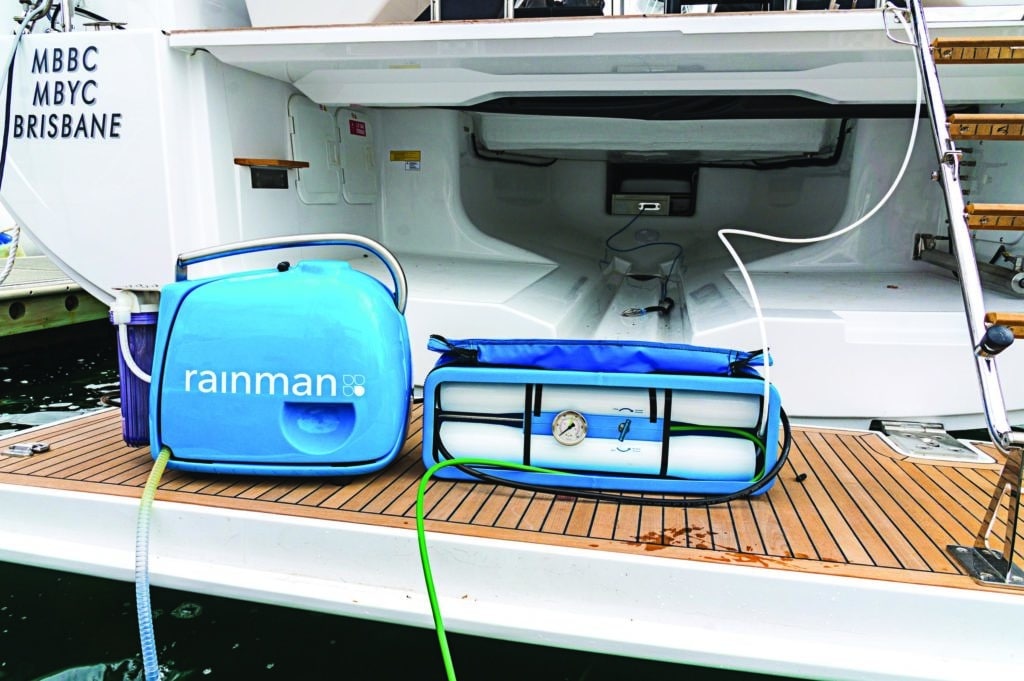
A relative newcomer to the marine market, the portable watermaker is a good solution for cruisers who want the convenience of a watermaker but don’t want to permanently install one. The Rainman is one such system that is available as a self-contained unit driven by a gasoline-powered Honda motor, or as a 115-volt AC-powered unit. “The bulk of our gasoline-powered system customers are sailing yachts between 30 and 50 feet,” said Ron Schroeder of Rainman Desalination. “Our customers seem to prefer to have a simple and somewhat manual system over one that relies on control panels, software and solenoid valves. We are also attractive to those customers who have had bad experiences with the installation process of an installed system.”
The Spectra Passport is another portable system. Edinger said it has already proved popular with offshore race crews and cruisers who need a watermaker for only a limited time.
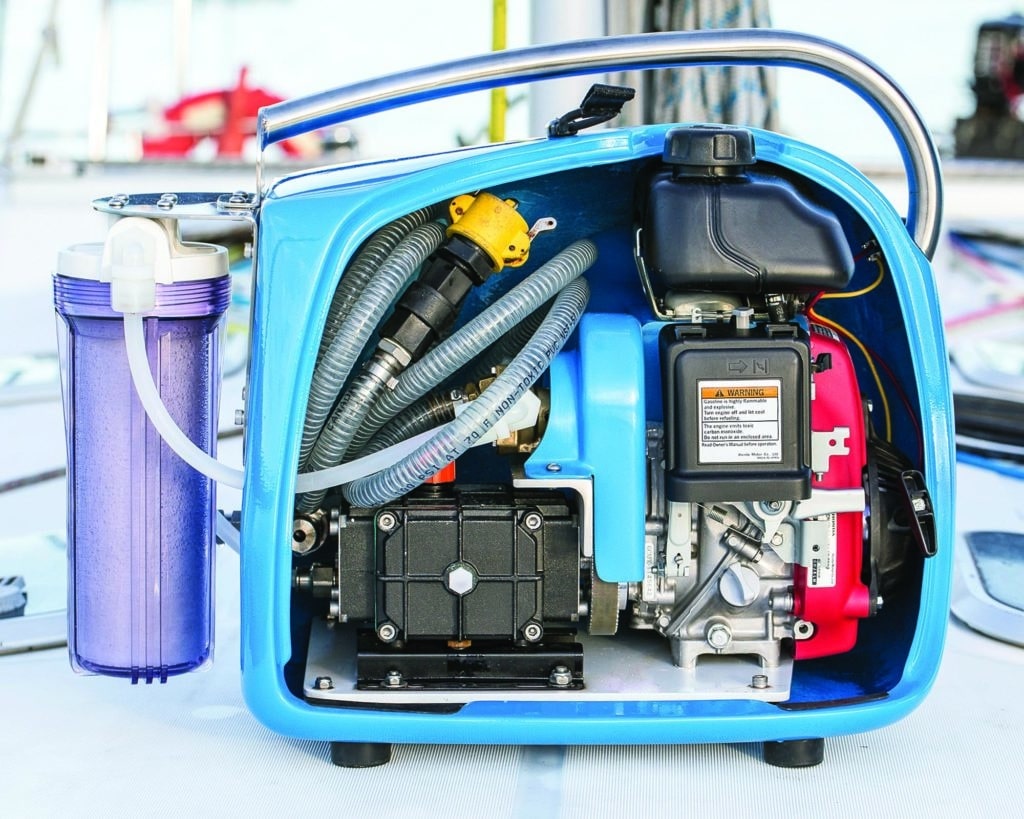
Maintenance for Watermakers
Watermakers have long had a reputation for being difficult to maintain, but the equipment has improved over the years and overall, routine maintenance isn’t more challenging than with other onboard systems. “The best rule of thumb is to operate the watermaker in water that looks good,” Andrews said. “There are a few factors in the feed-water condition that come into play. Operating a watermaker in dirty harbors will most certainly result in repeated pre-filter changes and a clogged sea strainer. If you have extra filters on board, you can get by, but it’s not recommended. The environment in the open ocean and remote anchorages is much better. Also consider how shallow the water is where you’re anchored. Sometimes there can be a lot of tidal movement, which can kick up fine particulate and sediment. This too can also contribute to more frequent filter changes and even damage other components. A nice option is an automatic freshwater flush, which will rinse the watermaker’s membrane element after use. It helps keep the membrane vessel housing free of any biological growth that could foul the membrane and reduce your ability to produce fresh water.”
Whatever system you choose, with proper use and maintenance you can expect years of service from your watermaker. And plenty of hot showers.
Jen Brett is a CW associate editor. This article first appeared in the February 2015 issue of Cruising World.
Aqua Marine: www.aquamarineinc.net
Blue Water Desalination: www.bluewaterdesalination.com
Cruise RO: www.cruiserowaterandpower.com
Dometic Marine Sea Xchange: www.dometic.com
ECHOTec: www.echotecwatermakers.com
FCI Watermakers: www.filtrationconcepts.com
Horizon Reverse Osmosis (HRO): www.hrosystems.com
Katadyn: www.katadyn.com
Rainman: www.rainmandesal.com
Sea Recovery: www.searecovery.com
Schenker Watermakers: www.schenkerwatermakers.com
SK Watermakers: www.skwatermakers.net
Spectra Watermakers: www.spectrawatermakers.com
Village Marine Tec: www.villagemarine.com
Watermakers Inc.: www.watermakers.com
- More: DIY Sailboat Projects , How To , systems
- More How To

When the Wind Goes Light

How We Built Our Own Bulwarks
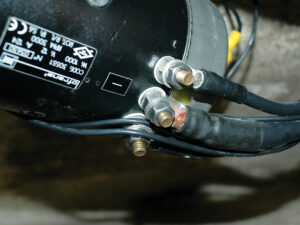
How to Keep Your Windlass Working For You
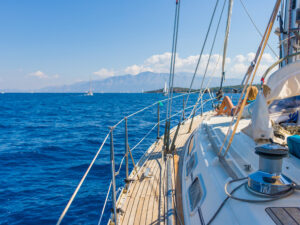
Southern Comfort: Tactical Tips for Sailing South

Windelo 54 Named Multihull of the Year

For Sale: 2019 Lagoon 40

Block Island Voted 2024 Best Harbor in the U.S.

First All-Canadian Team Wins the 8th Race to Alaska
- Digital Edition
- Customer Service
- Privacy Policy
- Email Newsletters
- Cruising World
- Sailing World
- Salt Water Sportsman
- Sport Fishing
- Wakeboarding
3 Best Watermakers for Sailboats (Reviews & Buying Guide)
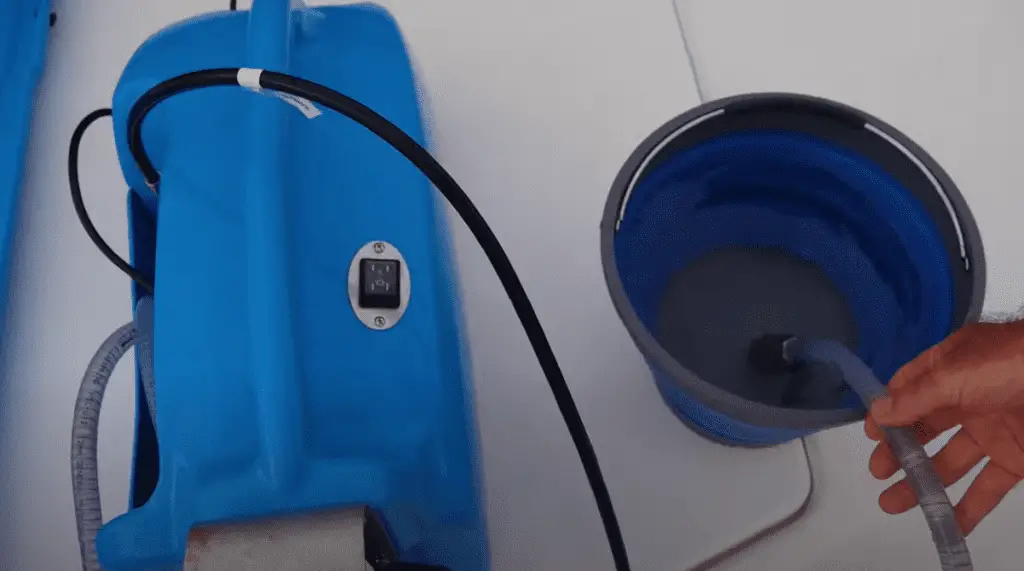
With a boat surrounded by water, there’s surely no such thing as dehydration out on the sea. Right? Well, not exactly. There’s way too much salt in seawater, and your kidneys would have to work overtime to filter it out. And to do that, they would need more water, which explains why copious amounts of seawater is toxic to humans.
So before you take a sip of that salty brine, why not pass it through a watermaker? The best watermakers for sailboats can take seawater and turn it into potable drinking water, giving you an infinite water supply to keep you hydrated and healthy on extended excursions.
What is a Watermaker?
Otherwise called a ‘desalinator’, a watermaker takes salty seawater and passes it through a process called reverse osmosis. This happens by pushing the water through a semi permeable membrane that allows the water molecules to pass through, but restricts salt, bacteria, and other organic material.
The clean, drinkable water is then passed into a water tank where you can then collect water for use. The remaining brine that was left during filtration is then tossed overboard and discarded. What’s nice is that these machines don’t use any chemicals, so there’s no risk of water contamination or pollution.
Some machines also use a pre or post treatment of the water using things like filters, sand, activated carbon, remineralization, or microfiltration to guarantee safe drinking water.
The Benefits of Watermakers

Modern-day technology has made it possible for manufacturers to develop more compact, efficient watermakers than ever before. This has also significantly driven down prices, making them far more accessible to sailors of all backgrounds.
Today, watermakers are recognized as a sailboat essential, especially for people who frequent the waves for long periods of time. Some of the benefits of these machines include:
Efficient Speed and Fuel Consumption
Yes, you read that right. Consider this - just 1 gallon of water weighs 8.3 pounds. If you’ve got 10 gallons on board, that’s equivalent to 83 pounds. A hundred gallons, and you’ve got an extra 830 pounds on board.
Watermakers allow boat owners to shave down their total weight. This lets you sail more efficiently, allowing faster speeds and lower fuel consumption which is important when you’re planning to sail long distances .
More Floor Area
Without a watermaker, you’d have to find room on board for the several tens or hundreds of gallons you need to bring with you. That also entails finding a place on your boat to store these water vats, which would obviously require significant room.
The watermakers of today are compact and lightweight. They can be either modular or self-contained, giving you different options to match your boat’s floor plan and use as little space as possible.
Safe Sailing
To ensure safe sailing, some studies have found that dehydration might actually be the reason for poor sailing performance. With dehydrated captains feeling lightheaded, achy, tired, and confused, it becomes increasingly likely to run into an accident that could endanger the lives of the people on board.
A watermaker guarantees that there will be fresh potable water at the ready any time you might need it. This doesn’t only curb the chances of dehydration, but also provides a solution for a variety of health conditions including diarrhea and various types of infections.
Extended Sailing Duration
You’ll only be able to sail for as long as your supplies on-board last. As your drinking water runs low, you’ll find yourself having to find the nearest dock to replenish supplies every so often. That’s if there are docks and shores you can access throughout your route. But what if there aren’t any?
Having the necessary equipment on board to extend your supply also means that you won’t have to rely on on-shore facilities to see you through your trip. This gives you more independence and flexibility as well as reducing the need to calculate complicated logistics.
Easier Boat Maintenance
Whether you’re underway or parked at the dock, your watermaker can help streamline boat maintenance by bringing freshwater straight to your vessel. With no need to collect buckets of water to lug back on board for a washdown, you can cut back the time and effort it usually takes to keep your boat clean.
Lots of boat owners even use their watermaker to give their boats a quick clean while they’re out at sea. This helps get rid of accumulated filth and dirt, reducing the need for a tedious deep clean once you get back to the dock.
The 3 Best Watermakers for Sailboats
Back in the day, watermakers were a luxury for the rich and the capable. But today, they’re incredibly affordable and easily accessible. Needless to say, manufacturers have also taken liberties with designing their own machines.
For you, that means an endless list of watermaker bets that could easily screw up your choice. So to help narrow down your options and lead you to the right one, here are our top 3 vetted picks:
1. Katadyn Power Survivor 40E Watermaker Desalinator

Small yet powerful, the Katadyn Power Survivor 40E is a reliable workhorse designed for boats with a small crew population of 2 to 3. This modular unit provides 1.5 gallons of water per hour, and draws only 4 amps from a 12-volt system, making it one of the most energy efficient desalinators out there.
This ‘Energy Recovery’ system works to desalinate seawater at just a fraction of the energy used by other watermakers in the same segment. Thus the device gets its name: Power Survivor.
Silent and lightweight, the machine lets you separate its primary system components so you can install the device seamlessly even in tight or awkward, irregular spaces. Most of its parts also come with a 3-year warranty, giving you that extra peace of mind versus damages and malfunctions.
2. AMPAC USA SeaPro Saltwater Desalination RO Watermaker

Able to produce 100 gallons per day, this watermaker was designed for use on small power boats or sailboats. Its super quiet automatic operation features intuitive controls that let you start and stop the desalination process with the push of a button.
Equipped with a noise pulsation dampener, the sounds produced during operation are negligible at best. This lets you run the machine in the evening to store up clean water for the next day without having to disturb your crew’s peace and quiet.
For boats with limited space, the SeaPro comes in a modular design that’s perfect for tight floor areas. It also comes in a partially mounted compact frame option that lets you fit the desalinator in place with little time and effort.
3. Rainman 12 Volt DC Watermaker
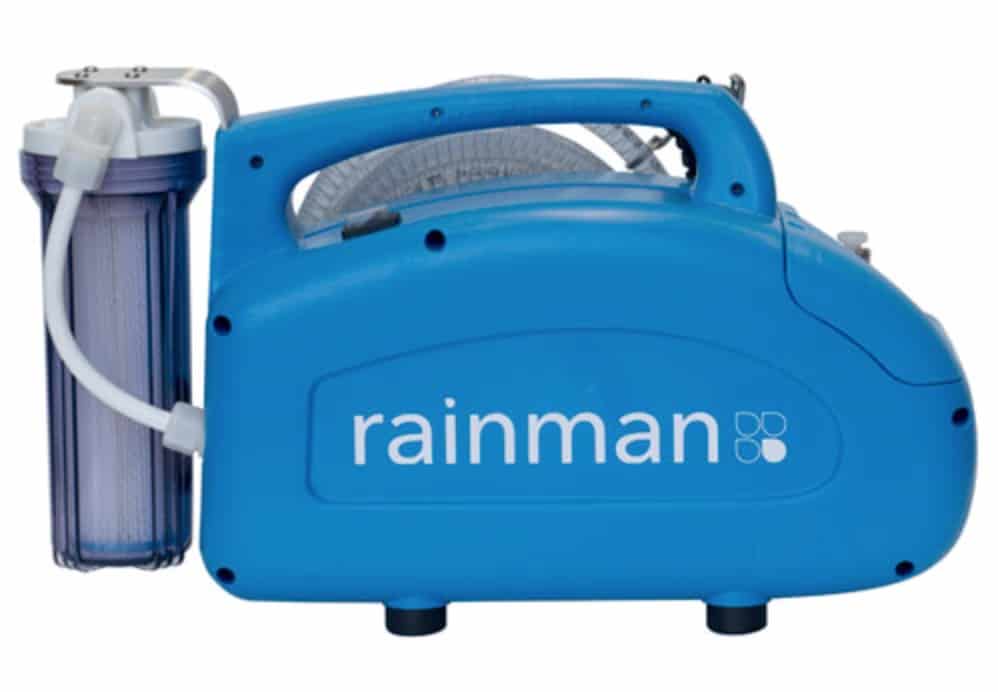
According to Rainman, their 12 Volt DC Watermaker consumes the least energy, able to filter 9 gallons of water per hour. The design touts a two-part system -- one pressure supply unit and another reverse osmosis unit. The former lifts the seawater from the source, while the other performs the desalination process.
What’s unique about Rainman’s watermaker is that the design gives you the option to install the unit directly to your boat, or to keep it handy as a portable watermaker system. This offers immense flexibility, allowing you to set up or take down your system as your situation calls for.
Aside from all of that, the Rainman Desalinator also features a streamlined control panel that makes everything easy to understand and operate at a glance. It also comes equipped with its own LED salinity sensor that tells you when water is good enough to store in your tank.
Choosing the Right Desalinator Watermaker
Not quite sure which one is right for you? Here are a few factors worth taking into consideration when buying a watermaker.
Size and Installation
There are two major options: modular and self-contained. The modular system lets you take the unit apart to install each part at a different part of your boat. This one’s ideal for boats with limited space. The self-contained system has the entire unit built together, which means it has to be installed as one piece.
Gallons Per Hour
How big is your crew? More people means you might need a watermaker with a higher GPH. Smaller machines capable of 1.5 to 2 GPH might be good for crews of 2-3 persons. But larger boats may need several hundreds of GPH to meet all of the crew’s needs.
* See: What size Yacht will Require a Crew?
Non-Proprietary Parts
You’re going to make part replacements one way or another. See to it that you’re buying a machine that uses non-proprietary parts so you can purchase the necessary replacements anywhere online.
Warranty and Services
In case anything happens to your watermaker, who will be there to help you fix it? Check the warranty coverage and see how long the manufacturer is willing to cover it for damages and malfunction. It’s also important to make sure there’s a nearby service center to cater to your needs in case of damage.
Water You Waiting For?
The best watermakers for sailboats offer to give you a virtually endless supply of clean drinking water when you need it. But there are a ton of choices on the market, so it pays to know what you’re getting before you shell out that cash. Consider our bets for the best desalinators for your sailboat, and keep your crew happy, healthy, and hydrated all along the way.
Related Posts
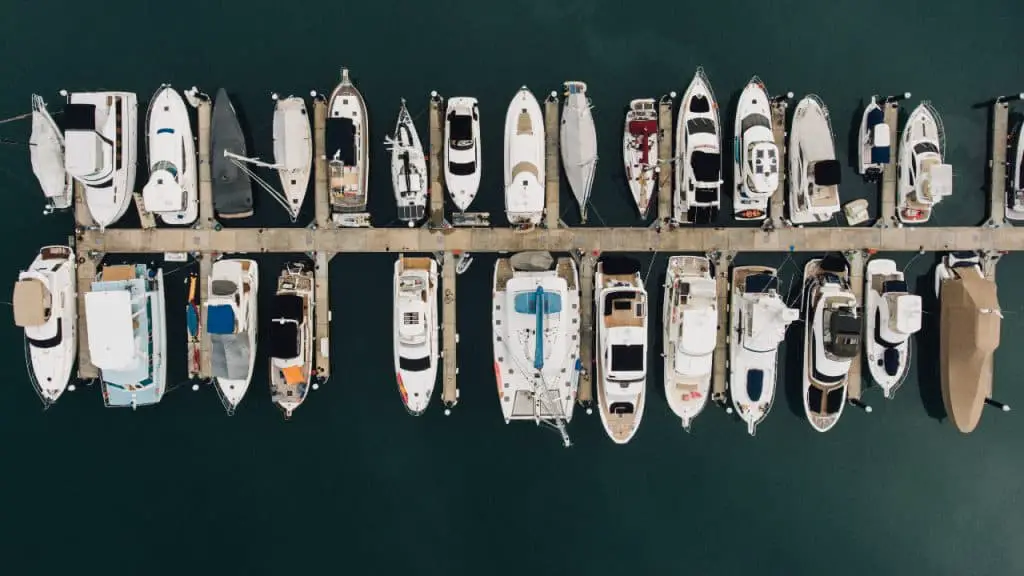
Best Live Aboard Yachts: Top 5 Yachts
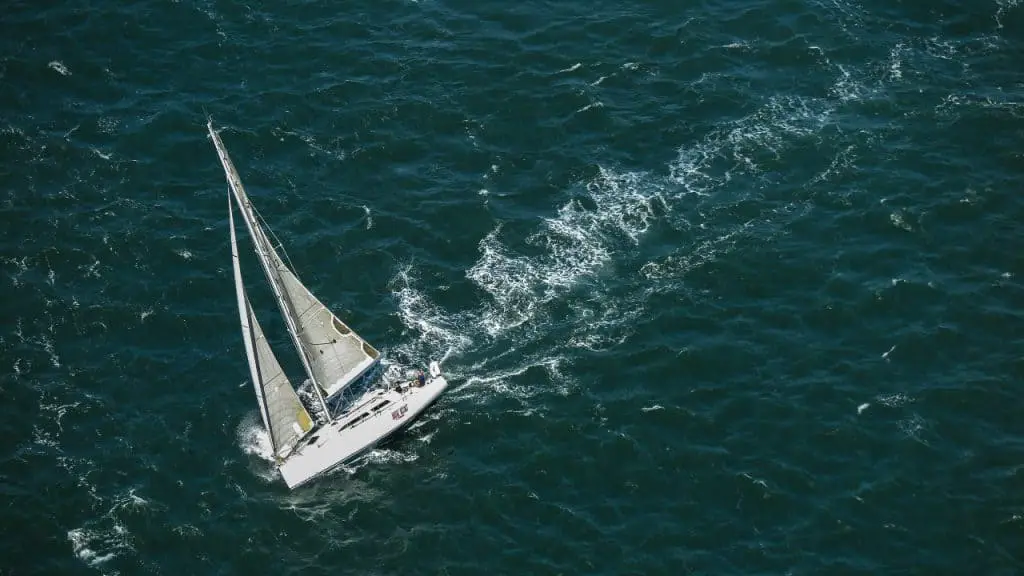
Is Sailing Dangerous? (How Safe or Dangerous Is It?)

Why are Superyachts So Expensive? [The Costs Explained]
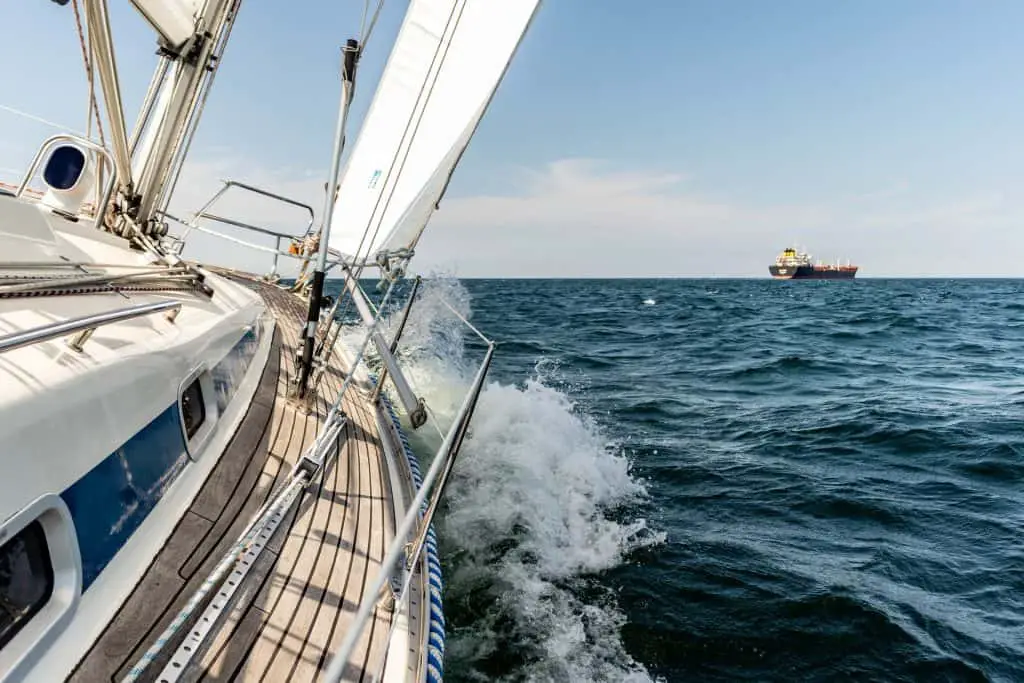
How Long Does It Take to Learn to Sail a Yacht? (How to sail)

- Marine Electronics
A Guide to Marine Watermakers for Your Boat
- By Marlin Staff
- Updated: March 4, 2015
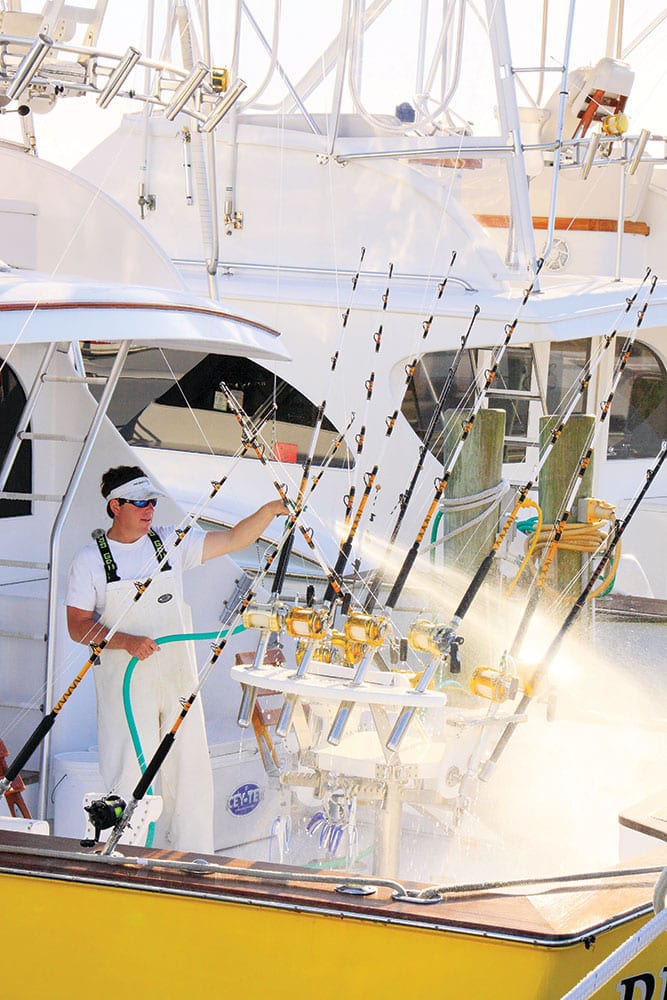
The World’s Largest Watering Hole
Once considered an extravagant option aboard a sport-fishing boat, watermakers are pretty much standard equipment today, with many boats even utilizing two units. Having a steady supply of potable water to shower, cook, live aboard and wash the boat with at the end of the day is a huge benefit. Converting salt water to fresh via the reverse-osmosis process gives you virtually mineral-free water, so it is far less damaging to topcoat finishes and Isinglass curtains than city or dock water. It’s also better for ice machines and the entire freshwater system.
Similar Operation
Boatbuilders who frequently install units have their favorite vendors for a host of reasons, and captains do as well, typically familiarity and service. The basic operation of any unit is very similar, so adapting to different manufacturers isn’t really a big deal as you move from boat to boat. Having the ability to get parts and reliable service should you have a breakdown wherever you fish or travel is always a top consideration.
The integration of automated switching and the ability to start and stop the water-making process without entering the engine room are major conveniences. One of the more recent trends has been the integration of wireless remote control of the units through the use of apps on smartphones and tablets. Not only will these tools start, stop and freshwater flush the units, but they can also be set to run for a specific time or maximum gallon production needed. They can conveniently monitor intake flow, product flow and total gallons, depending on the settings in the app. Several manufacturers also have the ability via a NMEA 2000 backbone to display and operate the units on shipboard monitors.
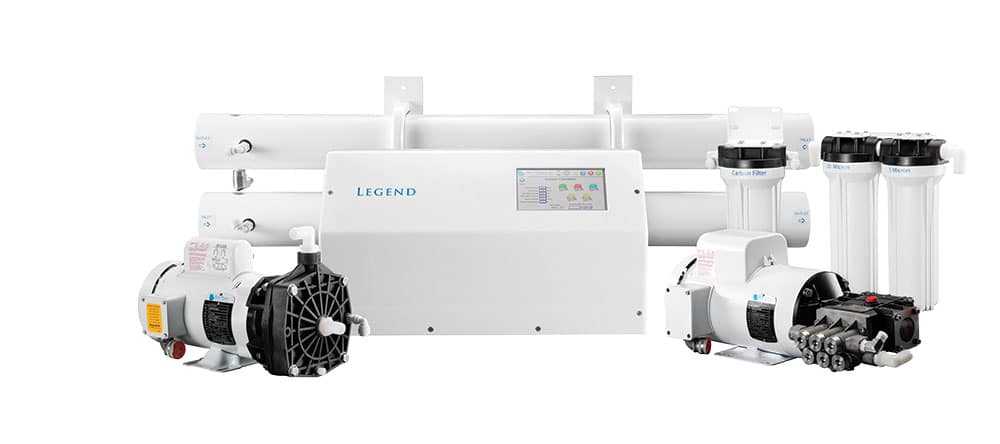
Blue Water Desalination is a relative newcomer to the marketplace with their Legend series of reverse-osmosis marine watermakers. The Legend series offers units with capacities from 475 to 1,850 gallons per day. Available in modular (shown) or container configuration, Blue Water units include a full-color 7-inch touch-screen display for simple operation. The large user interface with easily recognizable icons takes a lot of the worry out of operating the unit. Blue Water’s proprietary software continually monitors operation, helping to maximize production and quality. Featuring remote operation with NMEA 2000 or optional 3- or 7-inch color screens, the Legend series also features high-rejection membranes, freshwater flush and long-life Monel transducers, making it a full-strength competitor in the market.
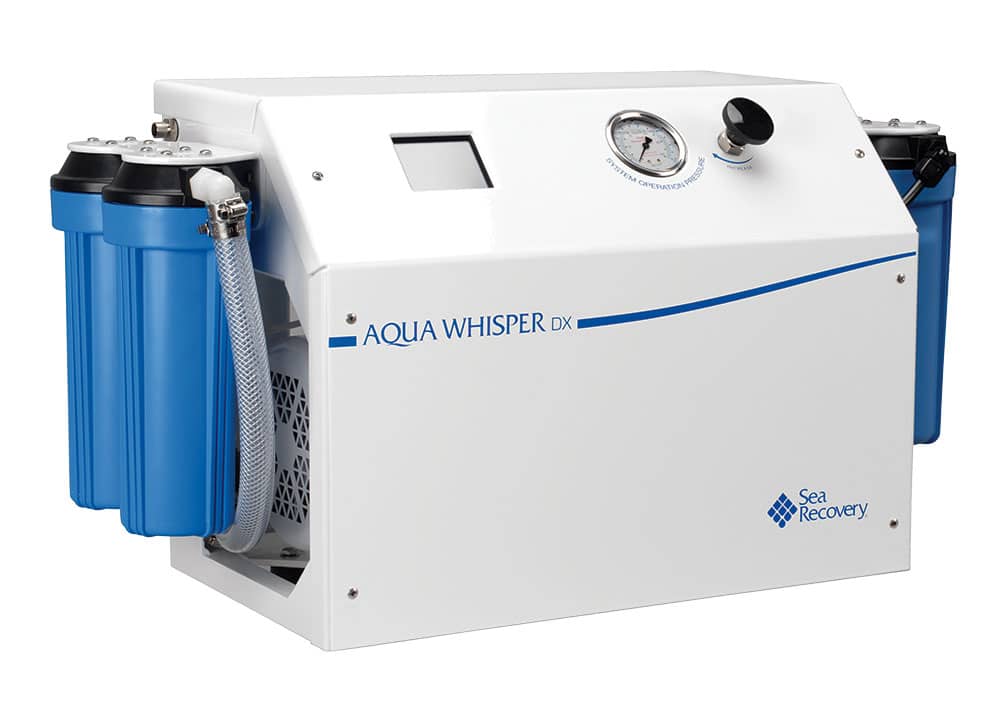
The Aqua Whisper DX series from Sea Recovery has the NMEA 2000 remote-compatibility feature that allows monitoring of all functions on any NMEA-compatible display. These units also have a full-color digital touch-screen display that reads in metric or U.S. standard units for managing all critical functions. They also offer an optional remote screen that allows for the same control mounted on the bridge or in the salon. Made with special attention to noise reduction, the Aqua Whisper units feature a low-noise manifold system and a unique high-pressure plunger pump that has been designed specifically for reverse-osmosis applications. Sea Recovery also offers an optional upgraded pump that is water lubricated, eliminating oil and oil changes, and it can operate up to 8,000 hours between maintenance requirements.
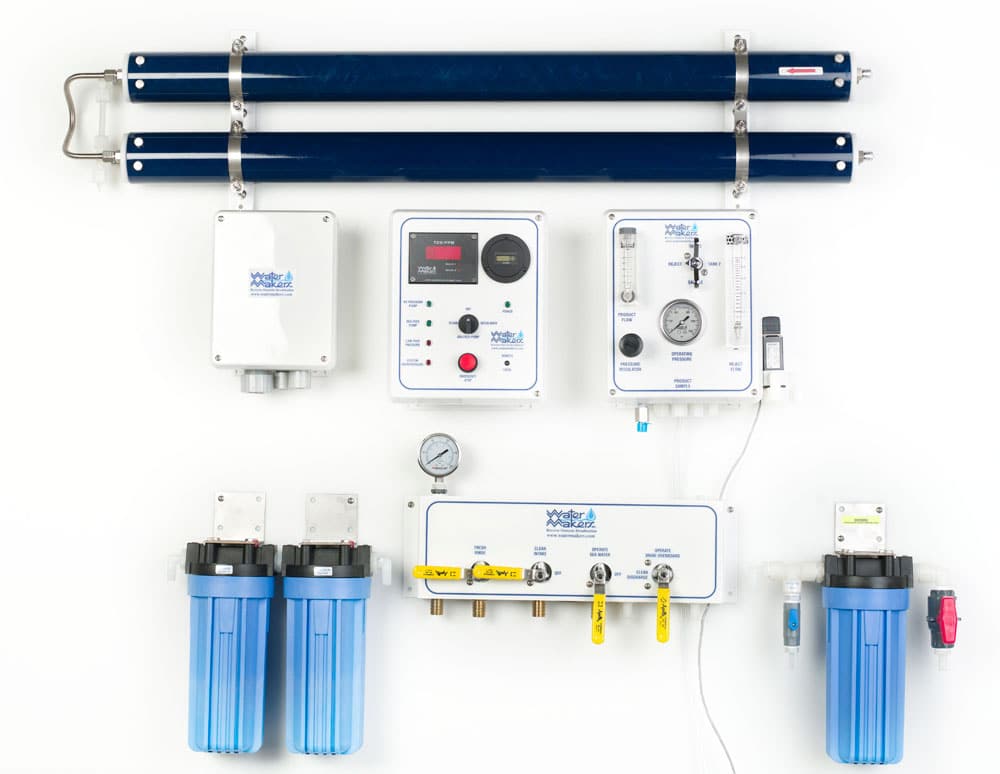
Watermakers, Inc. has been supplying reverse-osmosis units to boats and remote locations for many years, and their WMS-1000 is a workhorse unit that can be set up in a container or modular configuration. It features a heavy-duty 316 stainless-steel direct-drive high-pressure pump and plumbing, high- and low-pressure shut-offs, multitank control, an LED salinity monitor and auto diverter, as well as freshwater rinse and clean for maintaining membranes. Optional upgrade features include automatic start/stop with a manual override, and unattended rinse and remote operation via separate control panels. The WMS series is widely accepted and commonly found on today’s finer custom boats, offering units with daily capacities of 550, 1,000, 1,400, 1,700 and 2,200 gallons per day.
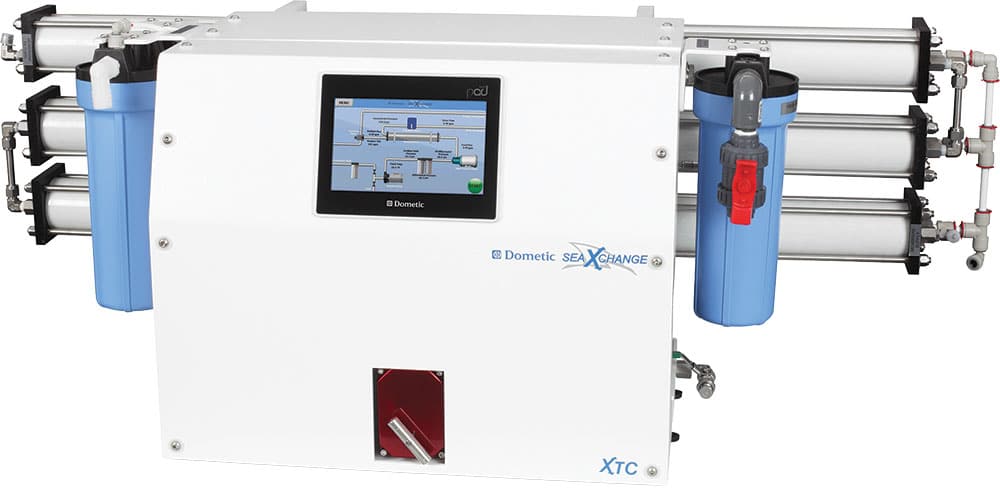
Industry behemoth Dometic offers the XTC series of watermakers with comprehensive manual control as well as total automatic operation. The XTC series offers a unique and functional platform with the addition of Dometic’s Smart Touch Integrated Intelligence Control (STIIC) software that allows users to remotely access the watermaker from anywhere in the world via smartphone, tablet or computer. There is also a mechanical override in the event of a computerized failure of some sort. Available from 600 to 2,200 gallons per day, the XTC Series also features a built-in 7-inch color touch screen with easy-to-see color icons and graphics. With automatic freshwater flush, a 316 stainless-steel high-pressure pump, high-rejection membranes, 316 stainless-steel flow and pressure components and a totally fan-cooled motor with thermal protection, the XTC series offers everything needed for making fresh water aboard.
With the technological advances, computerized controlling, remote access and dramatically improved components, it is hard to argue against having a watermaker aboard. If you travel, cruise or fish daily, having a watermaker increases your travel range and makes living aboard far more comfortable. It certainly helps with boat maintenance by offering virtually mineral-free water to prolong topcoat life. With a good membrane-maintenance program and annual service, your watermaker will give you years of good operation. Having the ability to easily use and maintain these systems will no doubt make your decision to purchase and utilize the full benefits of having a watermaker aboard an easier one.
- More: Boat Maintenance , Boats , Marine Electronics , Sport Fishing Boats
Free Email Newsletters
Sign up for free Marlin Group emails to receive expert big-game content along with key tournament updates and to get advanced notice of new expeditions as they’re introduced.
This site is protected by reCAPTCHA and the Google Privacy Policy and Terms of Service apply.
By signing up you agree to receive communications from Marlin and select partners in accordance with our Privacy Policy . You may opt out of email messages/withdraw consent at any time.
- More Marine Electronics

The Innovators


New Onboard Marine Electronics for 2024

Top New Marine Industry Technology for 2024

New Options for Onboard Internet
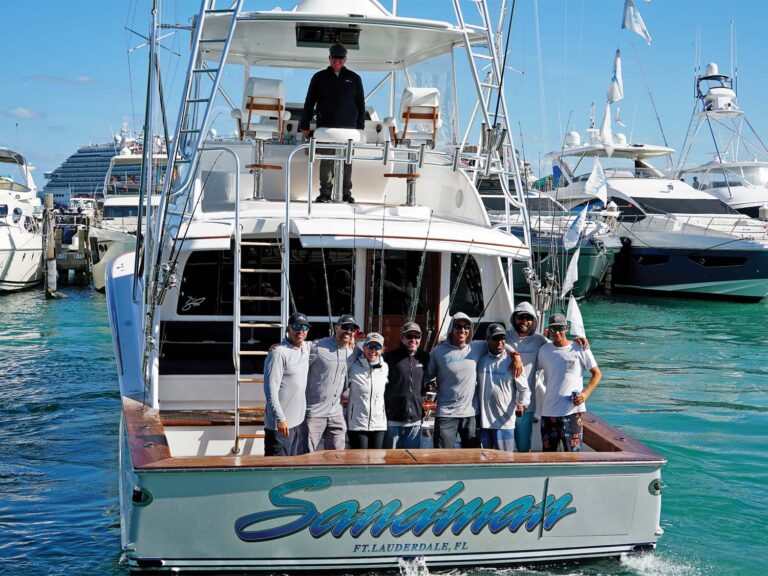
Sandman Triumphs at Final Sail in Miami

Aquaviva Triumphs in Marlin Madness 2024
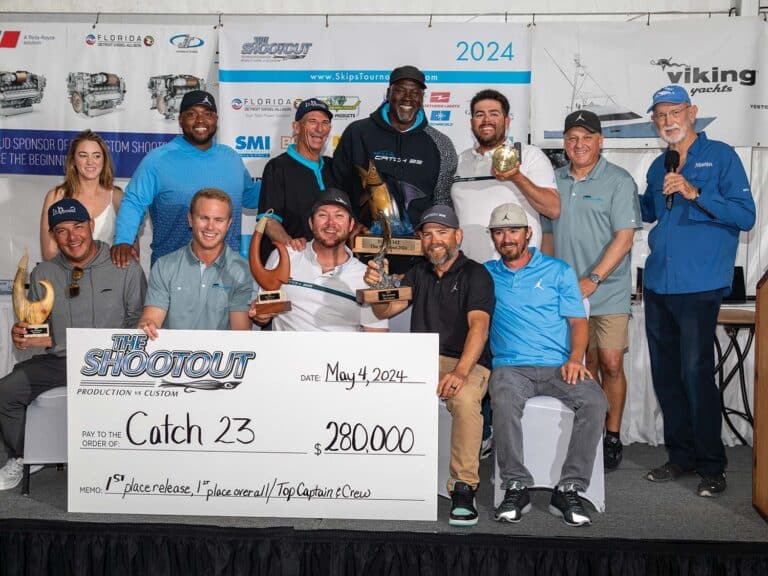
Catch 23 Dominates The Shootout: Custom vs. Production

Reel Steel Wins the Custom Shootout
- Digital Edition
- Customer Service
- Privacy Policy
- Terms of Use
- Email Newsletters
- Tournaments
- Expeditions
Many products featured on this site were editorially chosen. Marlin may receive financial compensation for products purchased through this site.
Copyright © 2024 Marlin. A Bonnier LLC Company . All rights reserved. Reproduction in whole or in part without permission is prohibited.
Sign up for free Marlin Group emails to receive expert big-game content along with key tournament updates and to get advanced notice of new expeditions as they’re introduced.
Portable Watermakers
+1-954-900-8800
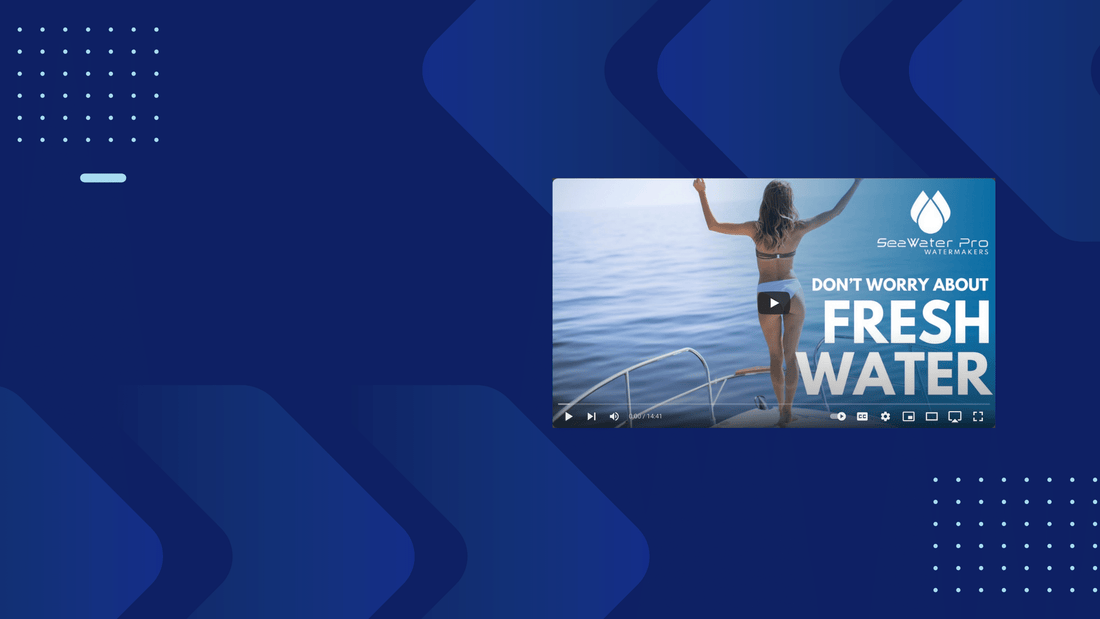
Welcome to SeaWater Pro
Enjoy the purest water without limitations - easy and reliable. Purchase your modular, portable, or compact boat salt water desalinator today!
Fast Express Shipping.
Industry Best Warranty!
Have a question?
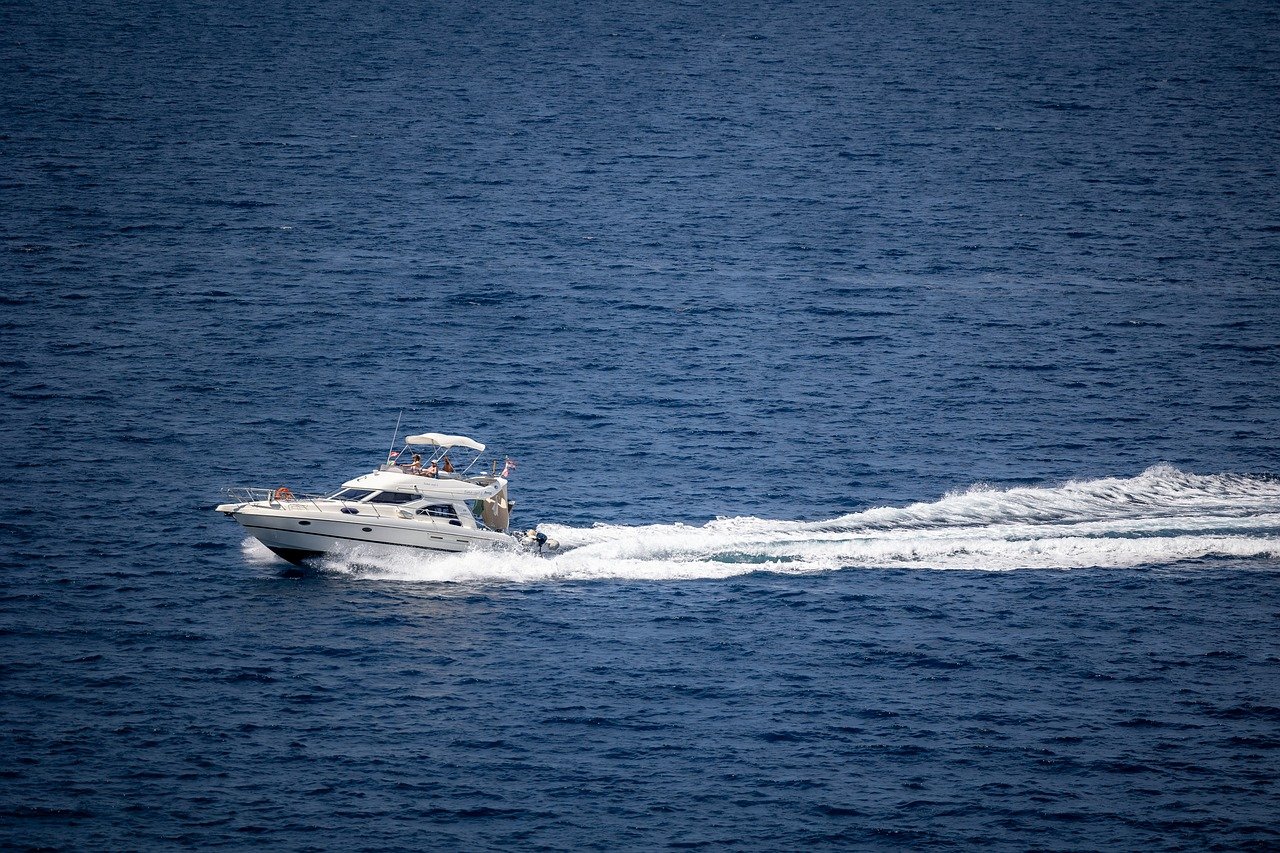
Modular Systems
Available in 17 to 40 GPH - Best for medium to large size vessels.

Watermaker: AC 110/220 Volt 970 Watts, 40 GPH Dual Membrane
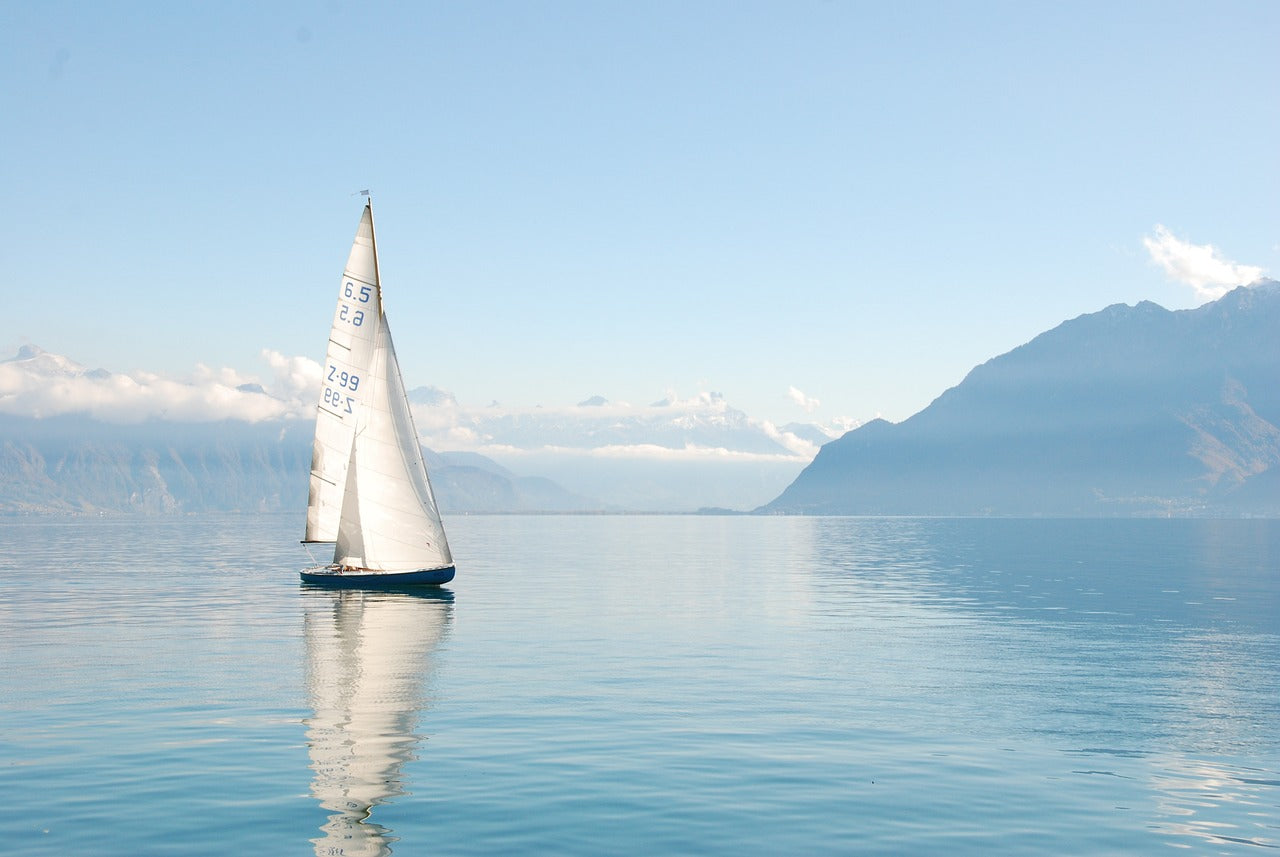
14 GPH - Best for small to medium size vessels.
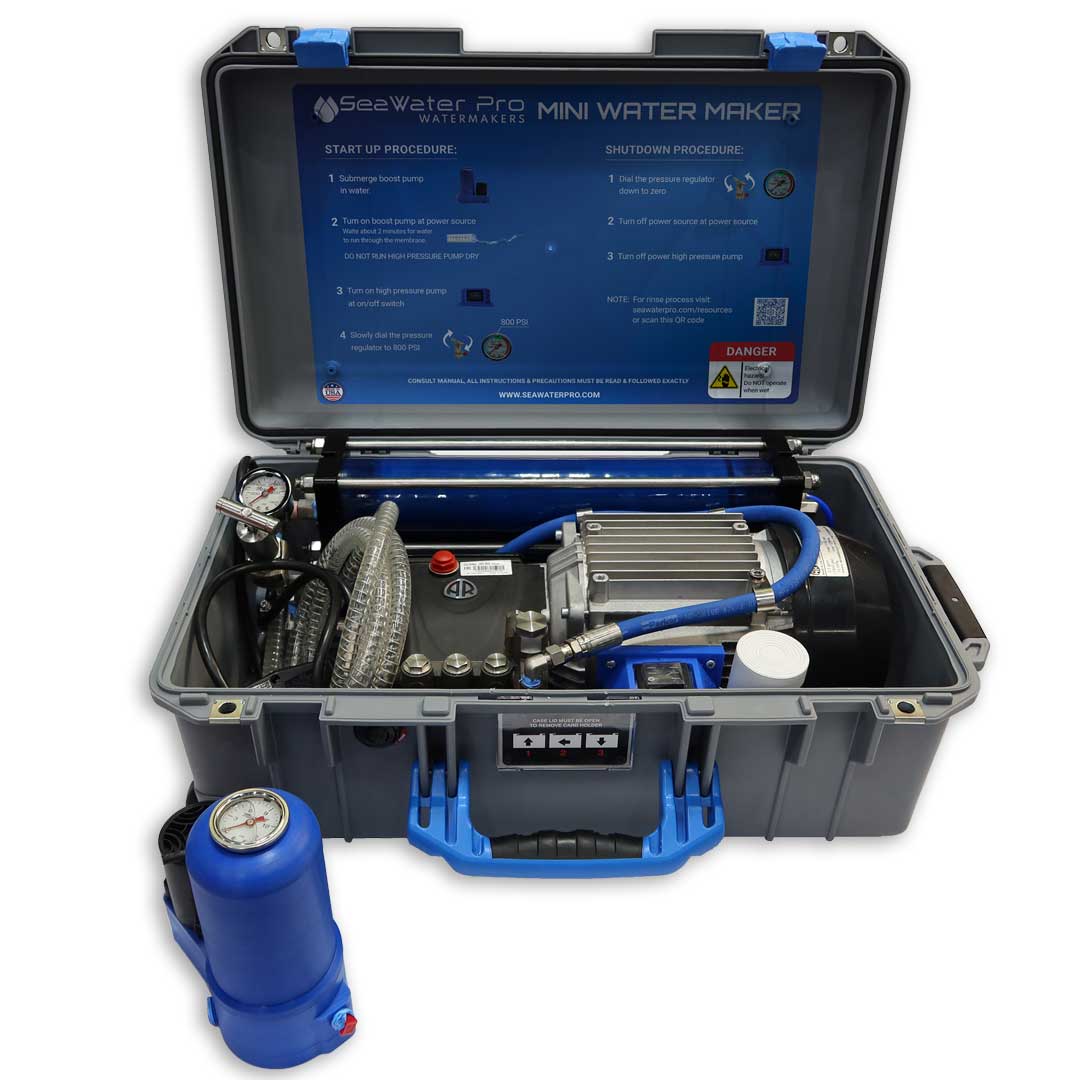
Mini Portable Watermaker AC Powered
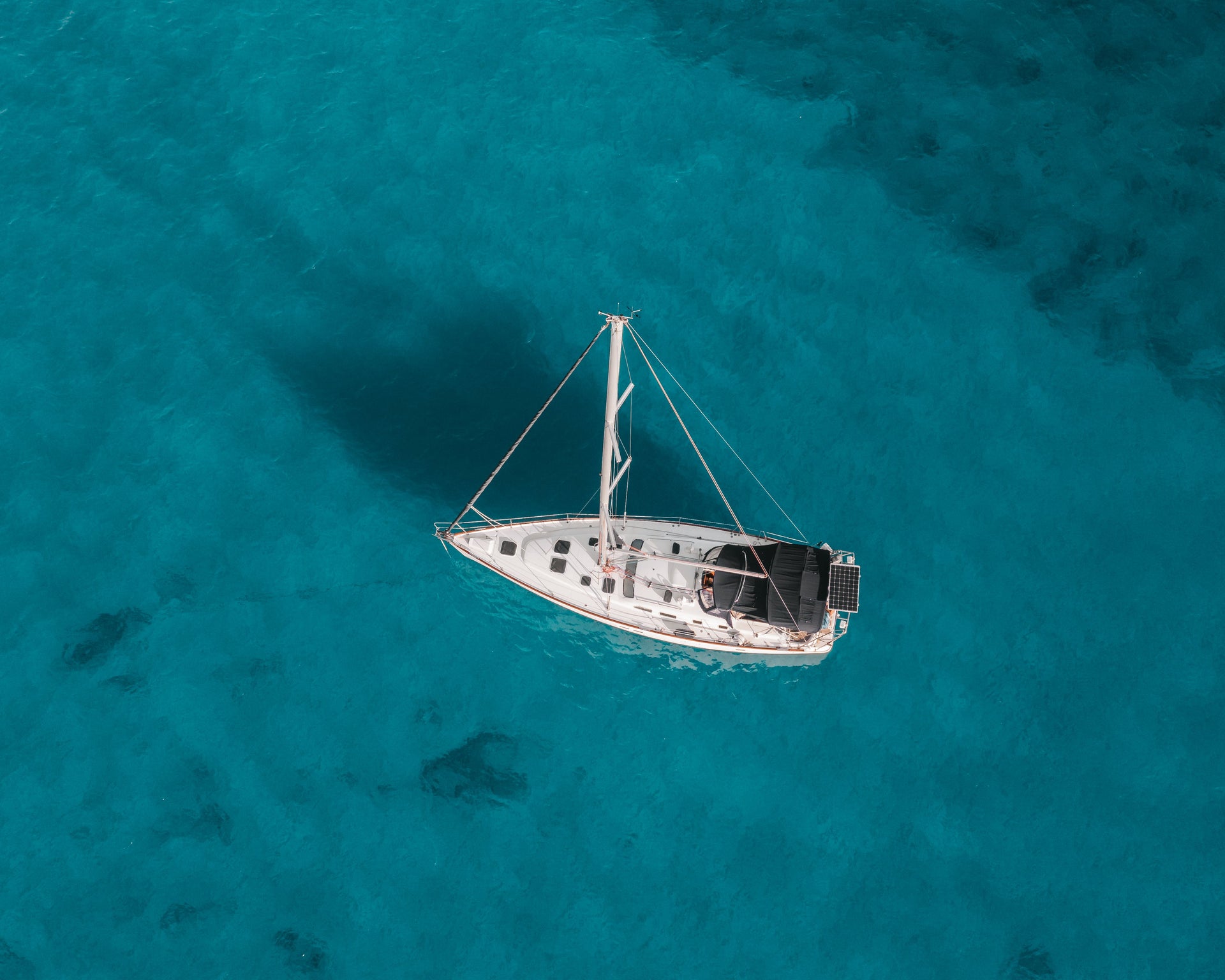
Compact Watermaker
30 GPH - Best for medium to large vessels with limited space.

Plug and Play Piranha 970W/30GPH (22"x16")
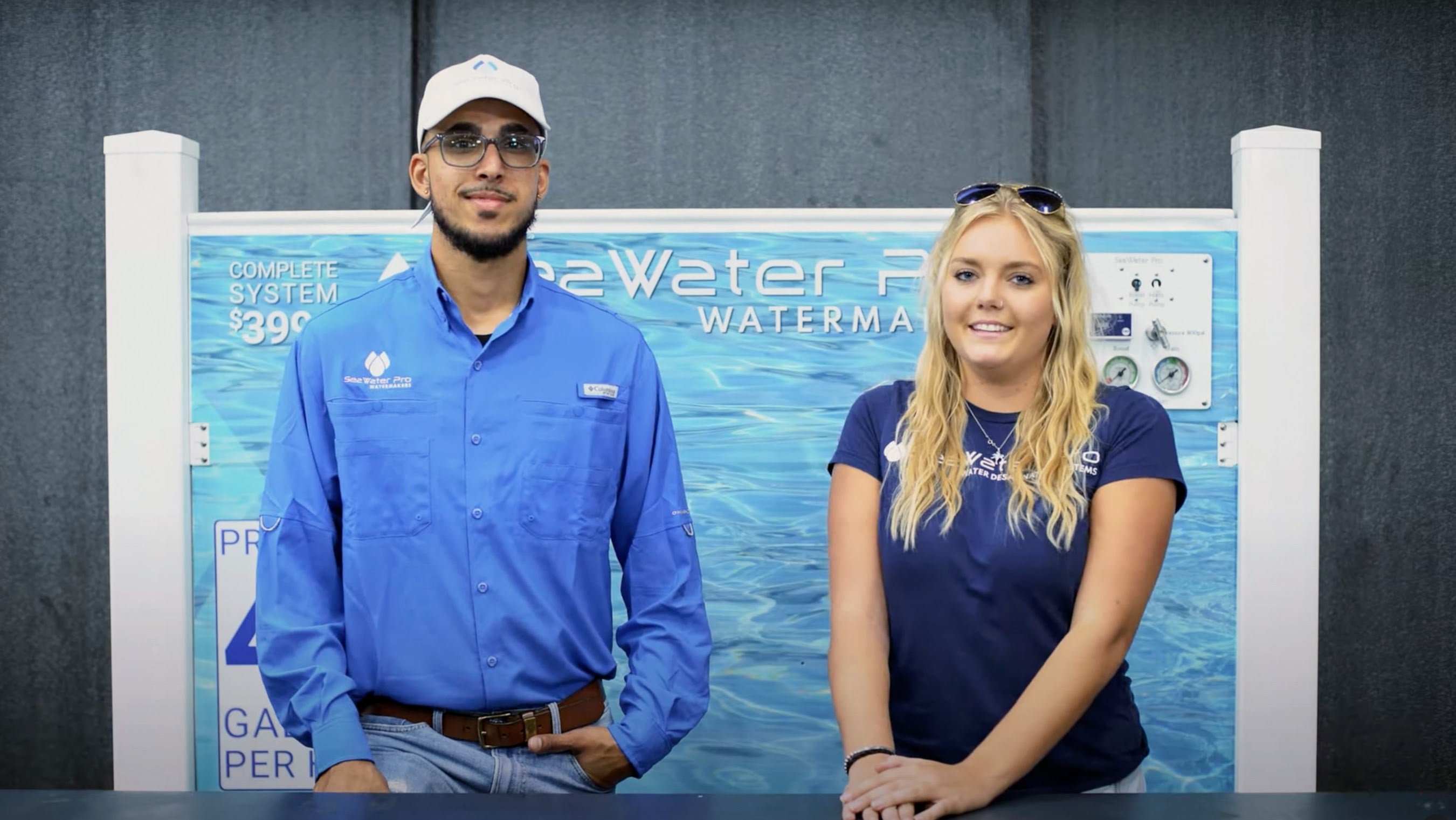
Quick Assembly Video
Customer installations gallery.

SWP Modular & Portable Watermakers
Welcome to SeaWater Pro, the premier provider of high-quality watermakers for boats and portable watermakers for all your marine adventures. Our cutting-edge technology and reliable products will ensure that you have access to clean, purified seawater wherever you go. With our easy-to-use and reliable watermakers, you can say goodbye to bulky storage tanks or worry about running out of fresh water. Our compact and efficient systems are designed specifically for marine use, making them perfect for boats of all sizes. Whether you're cruising the open seas or anchored in a secluded cove, our watermakers will provide you with a steady supply of fresh, drinkable water. At SeaWater Pro, we understand the importance of safe and clean drinking water while at sea. That's why our portable watermakers are equipped with advanced filtration systems that remove harmful contaminants and bacteria. Look no further than SeaWater Pro for your next, most reliable boating adventure investment!
Latest Articles
Demystify desalination, charting your course: your first steps into the exciting world of the sea industry, perks of staying hydrated with a portable watermaker while camping, how do i know which seawater pro watermaker i'll need for my boat.
- Identifying which power source you'd like to run the system. AC or DC power?
- Determine how many gallons per hour will you need to maintain your lifestyle, 17 or 40 GPH.
How much does each SeaWater Pro System weigh?
Every modular watermaker ships in 2 boxes: The first Box is 48 x 12 x 12, 60 lbs. and the second is 24 x 12 x 12, 37 lbs.
Can I install a SeaWater Pro system myself?
Yes! We have videos and instructions for our customers on the resources page .
Do I need a control panel?
Do I need a control panel? Click to watch video
How do I rinse my system after I use it?
Rinse Timer Setup Guide Click to learn more about using your system's rinse timer!
How often do I need to pickle my watermaker?
How to pickle my SeaWater Pro system! Click to watch our short video guide.
Your Cart is Empty
But your water tank doesn't have to be :)
- Choosing a selection results in a full page refresh.
- New Sailboats
- Sailboats 21-30ft
- Sailboats 31-35ft
- Sailboats 36-40ft
- Sailboats Over 40ft
- Sailboats Under 21feet
- used_sailboats
- Apps and Computer Programs
- Communications
- Fishfinders
- Handheld Electronics
- Plotters MFDS Rradar
- Wind, Speed & Depth Instruments
- Anchoring Mooring
- Running Rigging
- Sails Canvas
- Standing Rigging
- Diesel Engines
- Off Grid Energy
- Cleaning Waxing
- DIY Projects
- Repair, Tools & Materials
- Spare Parts
- Tools & Gadgets
- Cabin Comfort
- Ventilation
- Footwear Apparel
- Foul Weather Gear
- Mailport & PS Advisor
- Inside Practical Sailor Blog
- Activate My Web Access
- Reset Password
- Customer Service

- Free Newsletter

Pearson 37 and 37-2 Used Boat Review
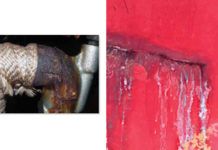
DIY Survey Checklist for Used-Boat Buying
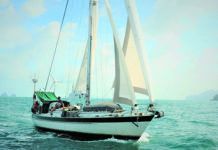
Valiant 40: Reshaping the Cruising Hull

Bristol Channel Cutter 28: Circumnavigator’s Choice

Best Crimpers and Strippers for Fixing Marine Electrical Connectors

Thinking Through a Solar Power Installation

How Does the Gulf Stream Influence our Weather?

Can You Run a Marine Air-Conditioner on Battery Power?

Practical Sailor Classic: The Load on Your Rode

Anchor Rodes for Smaller Sailboats

Ground Tackle Inspection Tips

Shoe Goo II Excels for Quick Sail Repairs
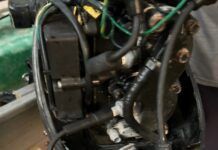
Dinghy Outboard Diagnostics
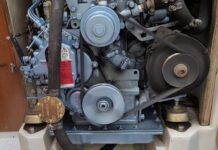
Spring Season Engine Start-Up for Winterized Engines

Solutions for a Stinky Holding Tank

Diesel Performance Additives

Vinyl Boat Lettering DIY Application and Repair

Those Extras you Don’t Need But Love to Have

Hidden Maintenance Problems: Part 3 – Gremlins in the Electrics

Three-Model BBQ Test

Alcohol Stoves— Swan Song or Rebirth?

Living Aboard with an Alcohol Stove

Preparing Yourself for Solo Sailing

How to Select Crew for a Passage or Delivery

Preparing A Boat to Sail Solo

Re-sealing the Seams on Waterproof Fabrics

Chafe Protection for Dock Lines

Waxing and Polishing Your Boat

Reducing Engine Room Noise

Tricks and Tips to Forming Do-it-yourself Rigging Terminals

Marine Toilet Maintenance Tips
- Systems & Propulsion
DC Watermakers: Expensive but Useful for the Cruising Sailor
Reverse-osmosis watermakers run from $3,000 to over $8,000, and though many are similar, close examination is required for the buyer who wants the right one for his or her onboard needs..
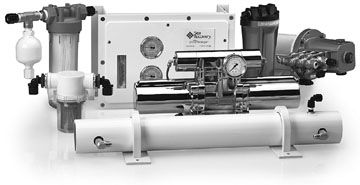
Reverse-osmosis watermakers have long been available for boats, but until a few years ago, they were bulky, power-hungry machines that were barely suitable for the typical cruising sailboat. All that has changed in the last decade or so, and relatively efficient, reasonably compact reverse-osmosis watermakers are now readily available. In the seven years since Practical Sailor last evaluated DC-powered watermakers, there has been slow but steady development in this niche of the marine market.
The trend today is toward higher-output, energy-efficient, more automated watermakers. At the same time, some of the original, dead-simple machines—or their lineal descendants—are still available. This look at today’s watermaker market will help you decide if a watermaker is a good choice for your own boat.
Who Needs a Watermaker? The percentage of sailboat owners who really need a watermaker is very low. If your sailing is coastal cruising in areas with reasonable access to fresh water at rational intervals, you can get by without a watermaker. This would include virtually all North American coastal cruising.
The concept of “reasonable access,” of course, is open to interpretation. Traditionally, when you went to a dock for fuel, you also filled your water tanks, usually without charge. This is still the customary practice in North America, although less so in other parts of the world, where paying for water is acceptable and expected. At virtually every marina in North America, unlimited water use is included in the price you pay for a slip. In other parts of the world, a fee for water—sometimes metered, sometimes a flat daily rate—is added onto the slip cost as a separate item, much like electricity or any other utility.
However, you can pay for a lot of water at a marina or fuel dock—even in places such as the Bahamas, where water is truly expensive—before you will come close to recouping the purchase and operating cost of any watermaker. And, if you have very small water tanks, it will probably still prove cheaper to install additional tankage than to buy a watermaker.
How Much Water Is Needed? This will come as no big surprise: the more water capacity you have, the more water you use. When PS Editor-at-Large Nick Nicholson first installed a watermaker (a first-generation Little Wonder) aboard his home-built, 40-foot cruising cutter Calypso, he was giddy with the idea of making all the fresh water he and his partner could ever use. In the first few weeks, he remembers, he went so far as to wash down the anchor chain with fresh water.
But reality set in pretty quickly when Nicholson discovered that he was using about 15 gallons of water every time he brought the anchor aboard. That meant almost three hours of running the watermaker every time he anchored. Installing a salt water anchor washdown pump brought that episode to a rational conclusion.
How much water do you need every day? There is no simple answer. Some 30 years ago, Nicholson and a friend lived aboard an old racing boat with no shower, no hot water, no pressure water, and one tiny sink with a hand pump in the galley. That vessel’s 62 gallons of fresh water lasted almost exactly two weeks, meaning two people used just under five gallons a day for cooking, bathing, washing dishes, and drinking. Most of that water was lugged in five-gallon soft plastic jugs, down the dock, into the dinghy, up on deck, and into the tank.
Two decades later, during his circumnavigation, Nicholson’s Calypso had 180 gallons of fresh water that would last just over 14 days on average at anchor or on passage, meaning that he used almost 13 gallons a day. “Were we profligate in the use of water?” asked Nicholson. “No. Did we consciously conserve? Yes, but not fanatically.”
With hot and cold pressure water in the galley and head, plus a really good shower, Nicholson and his mate used a lot more water on Calypso than he did aboard that Spartan racing boat. In the tropics, you drink a lot of water: a gallon a day per person would not be unusual. A daily shower is also very nice in the tropics, whether you’re underway or at anchor. You’ll also want to wash off with fresh water after swimming. Nicholson related that he also washed dishes in hot, fresh water aboard Calypso.
While on board Calypso, Nicholson lived as close to normally as possible, keeping the boat and crew clean, healthy, and hydrated. For the sake of comparison, a typical two-person household ashore uses about 200 gallons per day, which makes Calypso’s 13 gallons per day seem absolutely parsimonious.
What’s a realistic amount of water use on a serious cruising sailboat? Figure on three to six gallons per person, per day. Anything less than that is closer to camping out than living in comfort. Obviously, the crew of a 30-foot minimalist cruiser with small water tanks is going to have to be a lot more frugal with water than those aboard a luxurious 40-footer with a lot of water capacity.
Measuring Output If you’ve decided that a watermaker really is for you, the first question to ask is simple: how large a watermaker do I need?
Watermaker manufacturers typically use two standards to measure fresh water output: gallons per day, and gallons per hour. The gallons-per-day rating is ludicrous, as very few watermakers would survive very long running 24 hours per day. Likewise, if you had to live with the noise of a watermaker for more than a couple of hours per day, you’d probably toss the machine over the side.
The gallons-per-hour rating is more important. Remember, however, that there will be about five minutes worth of water discarded every time you start up the machine before the water quality reaches an acceptable standard. Likewise, if you flush the watermaker with fresh water every time you use it—unnecessary if the watermaker is used daily, but never a bad idea—you will waste a gallon or so of fresh water each time that operation is performed. To minimize start-up and shut-down waste, it is best to make water in one multi-hour whack, if you’re making water on a daily basis.
Running Time The decision then becomes how long you want to run the machine daily. This is a matter of personal taste, tolerance for noise, and the vessel’s capacity for electrical power. We would recommend that you buy a watermaker whose rated hourly output allows making all the water your crew will use daily in no more than two hours of operation, with allowance for startup discard water and fresh water flush at shutdown. As an example, a crew of two, using 10 gallons daily and wanting to run the watermaker for no more than two hours per day, should buy a machine with a nominal output of at least six gallons per hour. Note that actual system output will vary with water temperature and salinity, system voltage, and the age and characteristics of the individual membrane.
Noise All watermakers require running a pump. Even the quietest of these pumps is similar in noise to the sound of a medium-sized pump for pressurized water. If the watermaker is isolated from the living spaces, the noise may not be significant. If it is mounted under a cabin settee or quarterberth, you will be quite aware that the watermaker is running. Sailboats, unfortunately, tend to resonate like a drum, with both structure-borne and airborne noise. Cruising powerboats generally have better sound insulation in machinery spaces than sailboats, since the noise of the engine is ever-present when underway. However, if you run the watermaker while the main engine is running to charge batteries, the additional noise of the watermaker will pretty much be lost in the clutter of the main engine noise.
Water Quality Every watermaker is capable of producing decent potable water. Potable water is typically defined as having total dissolved solids (TDS) of less than 1,000 parts per million. Most water produced by watermakers will have a TDS of 300 to 500 ppm. Once again, the salinity of the source water will have an impact on the final water quality. In the open ocean, said Nicholson, Calypso’s water TDS was typically 400 to 425. In the high salinity of the Red Sea, that increased to 450 to 475.
It is imperative that you have a simple hand-held water tester—about $40 at most supply outlets—to monitor water quality on a regular basis. In fact, Nicholson said that he customarily checked water quality five minutes after startup, and just before shutdown, every time he made water. Regular testing of water will enable you to monitor the health of the membrane, and is a good check on system performance.
Power Source There are basically three choices for powering the watermaker on a sailboat: AC electric power, DC electric power, and direct drive from the main engine. If you have a separate generator, AC power is a rational solution, but that usually means a boat over 40′ to justify the space, weight, and cost of a generator.
Driving the high-pressure pump from the boat’s main engine is a good way to maximize output, but it may require a fairly complex installation involving custom brackets, custom pulleys, and modifications to the engine box. Since it is not unusual for a cruising boat to already have one or two big alternators plus a refrigeration compressor belted off the engine, there may not be enough space in the engine box—or enough room on the engine—to add an engine-driven watermaker pump. In addition, the main engine may have to be run within a narrow RPM band to properly drive the high-pressure pump on the watermaker, so this is not the system for everyone.
For the typical cruising sailboat under 45′, that leaves DC power—the ship’s main battery bank—to run the watermaker. Fortunately, that’s a very good option. There’s a nice variety of 12 V and 24 V watermakers out there, from extraordinarily simple (but not cheap) to extraordinarily complex (but not cheap) models.
Maintenance Ironically, the more you use a watermaker, the less maintenance it requires. A watermaker that is used almost daily essentially requires no maintenance, other than occasional replacement of the pre-filter cartridge on the inlet side of the system. According to Nicholson, the longest period of time that Calypso’s watermaker was in commission was from January through August, or eight months. During that time, the boat covered, about 8,000 miles from Bonaire in the Caribbean to New Zealand, and made over 2,000 gallons of water.
Nicholson took on water at Balboa at the Pacific end of the Panama Canal, and at Raiatea in French Polynesia. “Otherwise, we made every drop of water consumed aboard during that period. We replaced a failing feedwater booster pump and a few pre-filter cartridges in that period.”
Current thinking is that it may be less harmful for a watermaker to be flushed with fresh water regularly during long-term storage than the traditional solution of “pickling” the membrane with a sodium bisulfite solution. However, on an unoccupied boat, that means that a fairly sophisticated electronic controller system must be employed to automatically run the flush system on a weekly basis. This also means, of course, that the boat’s battery system must be kept on all the time as well. This is all well and good if the boat is plugged into shore power or has a solar panel system to keep the batteries up when the boat is unoccupied. (Note that long-term storage of the watermaker in this fashion is not possible during periods where the temperature may drop below freezing.)
In any case, a watermaker that is not used regularly must either be pickled—which must be repeated about every six months if it remains unused—or flushed with fresh water every five days or so. While automatic back-flush systems make this less onerous, any electronically-controlled system carries with it the risk of component failure.
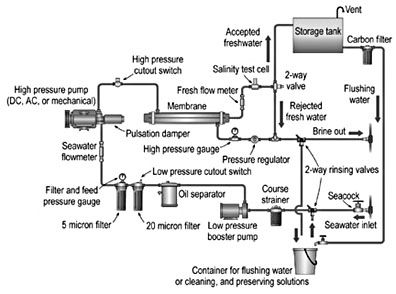
Unexpected Advantages Racing boats carry watermakers for an entirely different reason than cruising ones: to save weight. A gallon of fresh water weighs just over eight lbs. The 180 gallons of water that Nicholson carried aboard Calypso added almost 1,500 lbs. to her departure displacement. While this extra weight is not a major consideration for most cruising boats, it’s a big deal on modern racing boats, and will affect the performance of any boat.
The new Volvo 70s—some of the fastest monohull sailboats in the world—weigh about 30,000 lbs. The longest legs of the Volvo race will have the boats at sea for about four weeks, during which time the nine crew members on board each boat will consume a lot more than 180 gallons of water.
Instead of having big water tanks, each Volvo 70 carries at least one power watermaker with a rated output of no less than 20 liters per hour, plus two manually-operated watermakers. The 20-liter-per-hour output was chosen to permit the installation of low-voltage watermakers (Volvo 70s utilize 24-V DC systems) incorporating a single 20″ membrane. In fact, most Volvo 70s that PS has examined utilize watermakers with slightly higher output. Machinery installations are highly proprietary at this stage, and their proper functioning is critical to success. We will report on how these watermakers perform in a later issue as that event gets underway and progresses.
Energy Efficiency A DC watermaker’s energy efficiency is the measure of the amount of electricity consumed per unit of fresh water produced. This is a useful number, but its actual importance depends on the boat’s entire electrical energy management system. For a boat with limited battery and charging capacity, electrical efficiency may be a paramount concern. For a boat with a big battery bank, big alternator, and additional charging capacity in the form of solar panels and wind generator, electrical efficiency may be significantly less important.
Traditional watermakers use a simple single-piston or three-piston pump to generate the 800 lbs. or so of pressure required to push salt water through a semi-permeable membrane to make fresh water. Whether the pump is powered by an AC motor, DC motor, or by direct-coupling to the main engine or generator, it takes a fair amount of power to run the system.
Over the years, various patented pump designs have been developed to employ the pressurized waste brine [created by the reverse osmosis process] to reduce the energy required to operate the system. Originally, this idea was employed by PUR in the development of efficient manual desalinators such as the Survivor series for military use. Variations on the employment of waste energy are the principles underlying the Clark pump used by Spectra watermakers, and the EfficientSea system used in HRO’s Seafari Escape systems. The original Spectra was, indeed, a breakthrough in energy-efficient DC watermakers, and Spectra watermakers are still among the most energy-efficient systems available on an amp-hour-per-gallon basis.
Village Marine, maker of the Little Wonder, which was the first commercially-viable high-output DC watermaker, has significantly increased energy efficiency through the use of a different membrane configuration and a more efficient DC motor. Whereas the original Little Wonder had a nominal output of six gallons per hour while drawing about 16 amps, the newest configuration draws 13 amps while producing a little more than eight gallons per hour—roughly a 50% increase in electrical efficiency. We should point out that we can verify the output and energy consumption figures for the original Little Wonder, but are using the factory-supplied figures for the new version, which we have yet to test.
Just how important is energy efficiency? Let’s put this in perspective. Take two relatively efficient watermakers, one requiring 12 amp hours of 12V DC power to produce 10 gallons of water, and another requiring 17 amp hours to produce the same amount. That’s a difference of five amp hours of energy consumption per day. If you’re keeping your batteries charged with solar panels, that will be a significant number.
If, however, your primary charging source is a 100-amp alternator on the main engine, you’re talking about another three minutes or so of engine operation daily, which may be of less concern. This is particularly true if the main engine is also running an engine-driven refrigeration compressor at the same time the batteries are being charged and water is being made.
As a significant consumer of power, the watermaker must be part of the boat’s entire energy balance sheet, with battery size and charging sources playing a prominent role in the final configuration of the system, and thus any purchase decision.
Installation Installing a watermaker is not a decision to be taken lightly. First, you need to find a suitable location, and space is always in short supply on a sailboat. Fortunately, many DC watermakers come in both frame-mounted and modular configurations. The frame-mounted system secures all components to a pre-plumbed, pre-wired, drop-in chassis, making for a straightforward, neat installation. The modular configuration separates the bulky components, allowing you to fit them into more limited or irregular spaces. On the downside, with a modular system you may have to spend a fair amount of time fabricating mounting arrangements for the various components, as well as having more wiring and plumbing to complete. Although often more time-consuming to install, modular watermakers greatly outsell self-contained frame-mounted systems in the sailboat market.
You will need to install a dedicated inlet seacock, as well as a non-metallic through-hull fitting above the waterline for waste brine discharge. And you’ll need to build a manifold system that allows diversion of product water either overboard or into the boat’s water tanks. The manifold system must be readily accessible, and it should include the capability of diverting product water to an outlet at a sink for testing water quality.
Of course you will also need a dedicated high-capacity DC electrical circuit protected by a suitable circuit breaker, with heavy wiring to the watermaker’s motor.
Accessibility to all components for service is critical. You will be replacing pre-filter elements on a regular basis, and you may also need access for pickling the membrane if the unit is to be left in storage.
At the very least, we recommend monitoring product water flow and system pressure with simple analog gauges and flow meters, which may be remotely mounted on a control panel if the watermaker is installed in an out-of-the-way part of the boat.
Weight Except for lightweight multihulls or racing boats, the weight of a watermaker is not a consideration. The smallest, lightest DC watermaker—Katadyn’s PowerSurvivor 40E—weighs about 25 lbs. A typical high-output DC installation, including all plumbing and wiring, will weigh from about 75 to around 150 lbs. At the most, that’s equivalent to the weight of about 18 gallons of water.
Automation The biggest tendency in today’s watermakers is toward automation of the water production and maintenance processes. This level of convenience is a decidedly mixed blessing.
On startup, the automatic system monitors output water quality. When TDS drops to an acceptable level, the water is automatically diverted to the water tanks. At shutdown, some automatic systems back-flush the membrane with fresh water. The more sophisticated systems can then be programmed to automatically back-flush the system at regular intervals so that the membrane does not have to be chemically preserved, a sometimes messy and tedious process.
This, of course, all assumes that the electronics function properly, and that the boat’s batteries stay charged in storage so that periodic automatic flushing doesn’t run the batteries down.
These are, in our opinion, a lot of assumptions to make. Electronically controlled management systems fly in the face of the cruising sailor’s “keep it simple, stupid” philosophy, and should only be employed by those to whom absolute ease of operation is the overriding concern. Just remember, it’s a long, long way across the ocean, and getting a new electronic control module shipped to a remote location—much less finding an installer —may not be a simple matter.
Generally, automatic control systems can be bypassed for manual operation in case of a failure. If you have an automatic system with manual backup, make sure you understand its operation before you set off cruising.
The typical electronic management system adds about $1,500 to $2,000 to the price of a manually-controlled watermaker. If you want convenience, you’re going to pay for it.
The Bottom Line For the world-cruising sailboat without a generator, a DC powered watermaker is a viable option. In light of the difficulty you can sometimes have in finding potable water in out-of-the-way places, a watermaker can make a big difference between cruising in comfort, and cruising as a borderline survival exercise.

Without a watermaker, you may spend a lot of your cruising time searching for sources of fresh water. In many parts of the world, the water that comes out of the tap isn’t suitable for drinking, and even the locals may collect rainwater or use bottled water for human consumption. With a reliable watermaker whose operation and maintenance you understand, the search for potable water can be largely a thing of the past.
However, watermakers are expensive. They’re among the most expensive pieces of equipment you can put on a boat, and they can be maintenance-intensive. A DC watermaker will set you back anywhere from $3,000 to over $8,000, just to buy the equipment. Professional installation can easily increase that by 50%. Having a watermaker is somewhat akin to acquiring a pet, albeit a useful one. Once you have it, you may enjoy its company, but you are also obliged to take care of it regularly.
Now let’s take a quick look at some of the most available DC watermakers on the market today. Note that most DC watermakers are available in 12 or 24-V models, reflecting the current tendency to higher DC voltage systems on boats. Although the models listed here are those of primary interest to the average sailboat owner, other higher-output models, including engine-driven and AC-powered models, may also be available from most manufacturers.
PS invites comments from readers who own any of these systems, particularly regarding power consumption, output, and reliability.
HRO Systems, Sea Recovery Horizon Reverse Osmosis and Sea Recovery share common ownership and a common manufacturing facility. Their DC watermakers are identical—only the labeling is different. Their energy-efficient DC models—named Ultra Whisper for Sea Recovery, and Seafari Escape for the HRO-labeled version—feature a stainless steel energy recovery type pump that is conceptually similar to the composite Clark pump used by Spectra. They are available in both modular and fully self-contained configurations.
The stainless steel pump housings, while robust, make these among the heaviest DC watermakers, with weights from 130 to 145 lbs. Full electronic management, including automatic fresh water flush for long-term storage, is an option for both brands right now, but will become standard this fall. A company spokesman also told us that there will be new models introduced this fall that will differentiate the two product lines. Higher-output 24-V DC versions of these watermakers are also available. Both companies also market a more conventional high-pressure DC-powered watermaker, but the efficient energy recovery system watermakers are the more interesting products.
HRO and Sea Recovery watermakers are sold through a traditional dealer system.
Katadyn’s Powersurvivors The Powersurvivors are the current versions of the original PUR products. They are compact, which means they’re useful for a variety of installations, but they also lack any monitoring instrumentation or adjustment. Essentially, these are the most basic DC watermakers around, as well as being among the lightest. The 40E has the distinction of being the only DC watermaker that is convertible for hand operation in the event of power failure. The various Powersurvivor models are widely available through retail outlets such as West Marine. We found the 40E online for $3,000.
SK Watermakers SK is a small company whose primary business is AC-powered watermakers. The DC 150 is available in frame-mounted and modular configurations. These are not energy-efficient watermakers, but they are rugged and nicely made. Since they are sold directly by the manufacturer, they are also the least expensive DC watermakers for their output on the market.
Spectra Watermakers By a slight margin that has decreased with the introduction of new or re-designed models by other manufacturers, Spectra watermakers are the most energy efficient available. These are semi-modular units requiring separate component installation. The MPC 3000 automatic controller offers automatic operation and maintenance, but at a price. The new Z-Brane system, another option on some models, is designed to permanently eliminate chemical cleaning and preservation, prolonging membrane life. Spectra watermakers are available from selected retail dealers and distributors. The new Cape Horn Xtreme has been chosen by several of the Volvo Ocean Race teams to supply water needs for a crew of nine on this 30,000-mile ocean race.
Village Marine Tec. The Village Marine Little Wonder was the original high-output DC watermaker. Still in production after more than a decade, the Little Wonder has undergone significant upgrades in both output and energy efficiency, and offers models with outputs of seven to 12.5 gallons per hour at 12-V DC. All Little Wonder watermakers are supplied complete with pre-filters, manual fresh water flush, and low-pressure boost pump (the latter adds about one amp to the total current consumption).
Both modular and frame-mounted configurations are available in most models, but modular systems outsell framed versions eight to one, since relatively few sailboats have room for the enclosed, self-contained models. Electronic control packages are available only for AC-powered models.
Village Marine sells through factory outlets around the country, and a few selected dealers.
Also With This Article “Value Guide: DC Watermakers”
Contacts • HRO Systems, 800/366-4476, www.hrosystems.com • Sea Recovery, 800/354-2000, www.searecovery.com • Katadyn North America, Inc., 800/755-6701, www.katadyn.com • SK Watermakers, 800/489-0852, www.skwatermakers.com • Spectra Watermakers, 415/526-2780, www.spectrawatermakers.com • Village Marine Tec., 800/421-4503, www.villagemarine.com
RELATED ARTICLES MORE FROM AUTHOR
Leave a reply cancel reply.
Log in to leave a comment
Latest Videos

Hanse 410: What You Should Know | Boat Tour

Sailboat vs Fishing Boat – Rules of the Road

Catalina 445: What You Should Know | Boat Review

How to Wax and Polish Your Boat
- Privacy Policy
- Do Not Sell My Personal Information
- Online Account Activation
- Privacy Manager
- --> Login or Sign Up

- Things You Should Know!
How To Find the Right Watermaker for Your Boat

17th Sep 2021
Boat watermakers use a process called reverse osmosis to turn seawater into potable water that can be used for cleaning, bathing, and drinking while spending time on or below deck. A lot of variables go into purchasing the right watermaker for your beloved vessel. Environmental Marine is here to help you make the best choice for you and your crew.
Watermaker Considerations:
Before purchasing the best watermaker for your needs, consider the following:
- The size of your boat
- Desired features & functionality
- Usage requirements
- Length of use
- The number of vessel occupants
These factors contribute to your water usage requirements and will determine the size and output of your watermaker.
What Size Marine Watermaker is Best?
Your watermaker is integral to health and hygiene while aboard a vessel. After all, you do not want your crew drinking seawater. Marine watermakers should have the capacity to provide fresh water to all passengers daily. The U.S. Coast Guard recommends that each person on board be allotted 30 gallons of water daily.
Example: If you are going on a 1-day fishing expedition with 3 people on board, you will need at least 90 gallons of freshwater available.
How To Calculate Your Water Requirements
Water feels like an infinite resource when you’re out on the open sea, but don’t discount the importance of saltwater versus fresh (potable) water.
Saltwater can be used to wash dishes, cook certain meals, wash hands, and sometimes, even for showering. But desalinated water is best for rising the deck, general cooking, personal hygiene, and drinking.
An easy way to calculate the amount of water you need is to use this convenient calculator from FCI Watermakers . You can also find several FCI Watermakers replacement parts and products from Environmental Marine .
Watermaker Running Best Practices
Consider how many hours per day you'd like to run the watermaker to reach your water requirements. Many boaters prefer to run the watermaker between two and five hours per day. From there, calculate how many gallons of water you’ll need to meet your daily potable water requirements. If you want to create 90 gallons of water in a two-hour timeframe, your watermaker will need to process at least 45 gallons per hour.
Marine watermakers are rated based on the number of gallons of freshwater they can produce hourly. Use this in terms of daily production or the hourly rate multiplied by 24.
More Information on Watermaker Output
Marine watermakers available on the market today can produce anywhere from eight to 344 gallons per hour or 200 to 8,300 gallons per day. Commercial systems can output up to 1,750 gallons per hour.
There are a lot of options on the market for watermakers. The good news is that it allows boaters to choose from various unit sizes, capacities, and production yields so they can find the best match for their needs.
If you have any questions about marine watermakers or other marine equipment and accessories, reach out to the experts at Environmental Marine. For more posts like this one, check out our Helpful Resources .
- #boat watermaker
- #FCI Watermakers
- #marine watermaker
Share This Article

Our Systems
Echo tec. watermakers desalinators for boats, homes, and hotels.
ECHOTec manufactures the most rugged and easy-to-operate desalinators/watermakers or desalination systems for yachts, commercial vessels, offshore installations, and land-based applications such as small communities, hotels, and beach houses. Designed for customer installation and ultra-reliable performance, far from factory-trained service centers, the wide product range covers modular AC, DC, and belt-driven watermakers from 8.4 GPH / 32 LPH to self-contained desalination systems with a production of 14.000 gallons or 53.000 liters per day.
More than 5,000 ECHOTec desalination systems operate dependably and cost-effective throughout the world, many of them on continuous duty. Only the highest quality components, proven to withstand continuous operation in the harsh marine environment and comply with industry standards including NEMA, ASTM, API, NSF, and BSI are selected for safe operation and ultimate product life cycle.
ECHOTec Watermakers are globally available directly from the manufacturer and through a fast-growing net of factory-trained distributors.
Our Featured Desalinators

2400 GDP Series – A Proven Energy Recovery Desalination System
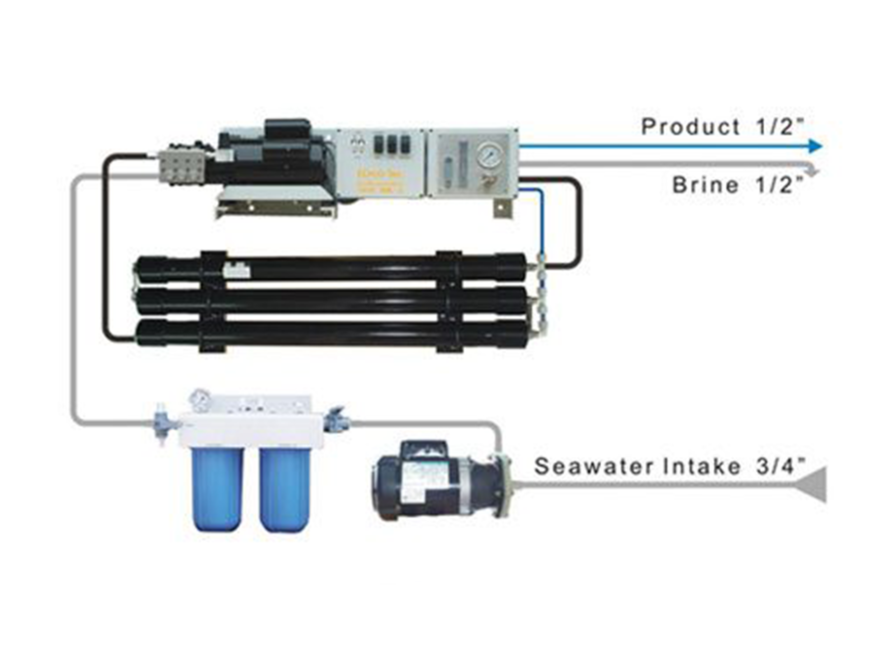
115/230v AC Pro Series (Semi-Modular/Self-contained)

AC Powered Reverse Osmosis Watermaker
Testimonials.
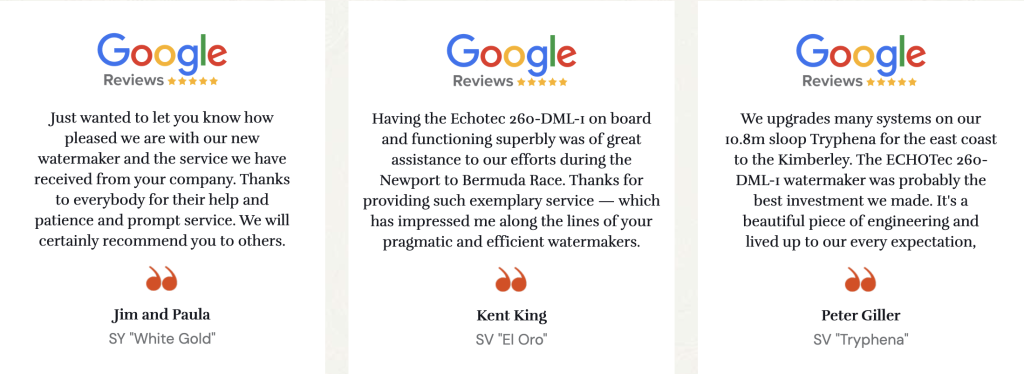
After 8 years experience with our ECHOTec watermaker on “Lindisfarne”, we chose an ECHOTec 260-DML-1 for our next boat “Moon
Annika & Björn

We upgraded many systems on our 10.8m sloop Tryphena for our trip from the east coast to the Kimberley. The ECHOTec 260-DML-1 water maker was probably the best investment we made. It is a beautiful piece of engineering and lived up to our every expectation.
Peter Giller

I have had 3 watermakers on different yachts over the years and I know that I need a robust, simple and efficient machine. My Echotec 260-DML-1 is all those things. In recent voyages to the Louisiades, the Solomons, New Caledonia and Vanuatu, I have enjoyed reliable, easily made water. In the Solomons, where the sea water is very warm, I was getting a litre a minute from my 260-DML-1! I had a couple of queries when installing the unit and was greatly helped by Peter from Blue Sea Machines. I unreservedly recommend both his service and the product.
Lawrie Gubb

After one year in use, I can confirm that ECHOTec was the right choice for our Island Packet 380. The 12V-unit produces a vast amount of freshwater with minimal (service) effort. We particularly appreciate that we can get competent and fast support directly from the manufacturer – even a year after the purchase. We highly recommend this watermaker.
The Habibi Crew

Just to give you some feedback on our watermaker, I must say that I am really impressed with the unit. Having a fair amount of experience with RO units, although normally much larger than this one, I am surprised at the quietness of it. It runs much quieter than expected.
Your service in getting the unit to us before departure was great as was the way it was packaged and shipped. The unit is well put together and I am very pleased with the workmanship and the fact that you supplied everything needed to do the installation.
I am happy that I bought an Echotec watermaker and will be recommending it and your company to anyone who asks.
Matt Lansdown

This was our first attempt at changing our membrane since we installed the ECHOTec 260-DML-1 all by ourselves six years ago in Malaysia. Thank you for your prompt and helpful replies! We previously had a Xxxxxxx system that failed miserably in the middle of the Pacific, repair was complicated and expensive. We love the simplicity of the ECHOTec system. We had zero maintenance, except for the occasional gear oil and filter change, in the past six years! We just have installed new solar panels and are now able to run the watermaker on solar power only during high sun. It’s really great to be able to do this! Great product and outstanding service, thanks again! Kind regards
Denis & Maria

Since 3 years we have an ECHOTec installed like most cruisers we know. After more than 25.000 liters produced, we as well as all our friends have no problems with our desalination system. Therefore, we have decided to use an ECHOTec 260-DML-1 again on our new project: The 100% solar-powered catamaran “Solarwave”, without sails and any fossil fuel.
Michael Köhler

Just wanted to let you know how pleased we are with our new watermaker and the service we have received from your company. Thanks to everybody for their help and patience and prompt service. We will certainly recommend you to others.
Jim and Paula

Having the Echotec 260-DML-1 on board and functioning superbly was of great assistance to our efforts during the Newport to Bermuda Race. Thanks for providing such exemplary service – which has impressed me along the lines of your pragmatic and efficient watermakers.

Marine Watermakers

Which model is right for you?
Schenker watermakers are available in 4 models, Wiki, Zen, Smart and Modular.
All units are fitted with an Energy Recovery System , reducing to a minimum the electric consumption. Materials, manufacturing quality and reliability of all 3 models are equivalent, however their features and capacity are different so, which one is right to meet you needs?
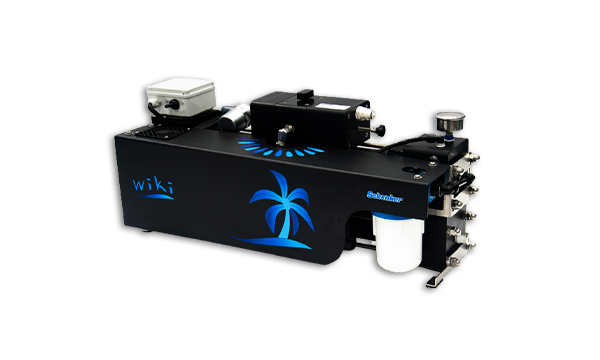
RANGE: 30 LIT/H | GAL/H 7.9
Wiki, term of Hawaiian origin which means "fast, quick". An ideal name for a portable plug-and-play watermaker that can be activated in just a few minutes.
Embrace the freedom of portable drinking water with the compact, Italian-designed Wiki Desalination Unit. Say goodbye to bulky water containers and hello to a more convenient and sustainable solution. Lightweight and easy to use, the Wiki fits into a bag easily stowable in a locker, ensuring clean water wherever you go.

RANGE: 30-50-100-200-300 LIT/H | GAL/H 7.9-13.2-26.4-39.6-53-79
All components are integrated in the main manifolds and there are very few external components like fittings, pipe, valves.
These features make the Zen watermakers very compact , with a special ultra-flat design. Zen in fact is designed to fit into tight spaces and can be installed in every positions, horizontally as well as vertically. Not much bigger than a briefcase!
The Zen are fitted with new generation Energy Recovery Systems that reduce the electric consumption to a minimum.
Zen technology is patented.
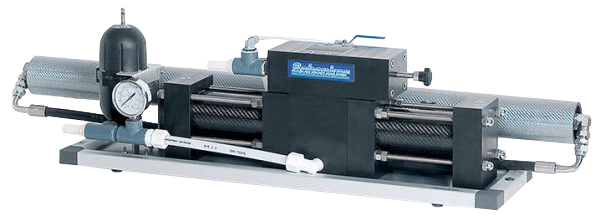
RANGE: 30-60-80-100 LIT/H | GAL/H 7.9-15.8-21-26.4
Light, simple, efficient and affordable.
It is the ideal solution for those who prefer essential systems based on single membranes.
The naked design makes the inspection and maintenance of components very simple.
3 control options available.

RANGE: 35-60-100-150-230-300-500 LIT/H | GAL/H 9-15.8-26.4-39.6-61-79-132
Very compact units based on split membranes.
Large choice of output range ( up to 500 lit/h) to satisfy all needs.
Not sure which is the best solution for you?
Whether you own a sail boat or a big yacht the questions you should ask first are:
Which is the ideal fresh water capacity?
The ideal watermaker should provide the daily fresh water demand of the boat in about 3-4 working hours. On his turn, the daily fresh water demand is based on the number of people onboard and the type of boat. The typical fresh water demand in a sailing boat if about 30-40 lit/day, whereas it is 50 -60 lit/h in a power boat or catamaran. For instance in a sailing boat with a crew of 5 people the estimated daily fresh water demand is 150-200 lit. The ideal watermaker capacity is 50-60 lit/h then.
Which power supply to choose?
All Schenker watermakers are fitted with an Energy Recovery System, and then the electric consumption is very low, either for DC or AC systems. The smaller units, for instance 30 and 50 lit/h are available DC only . The power required is so low that has no sense to consider an AC power. For bigger systems, from 60 to 150 lit/h, are available both DC and AC power supply. If the boat is not fitted with a generator, the choice will be DC, of course. In case a generator is available but used rarely , the DC will be the better choice as well, whereas AC is recommended in case the generator is used extensively. Even for AC system, the low consumption is great advantage as it allow to reduce the size or the load of the generator.
Haven’t found yet what you were looking for?
Contact us, we’ll be glad to support you
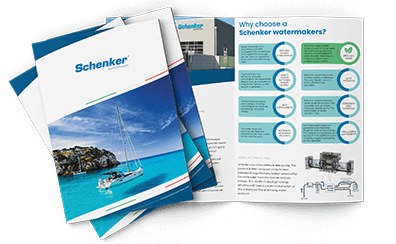
View our products range brochure
Download / View PDF
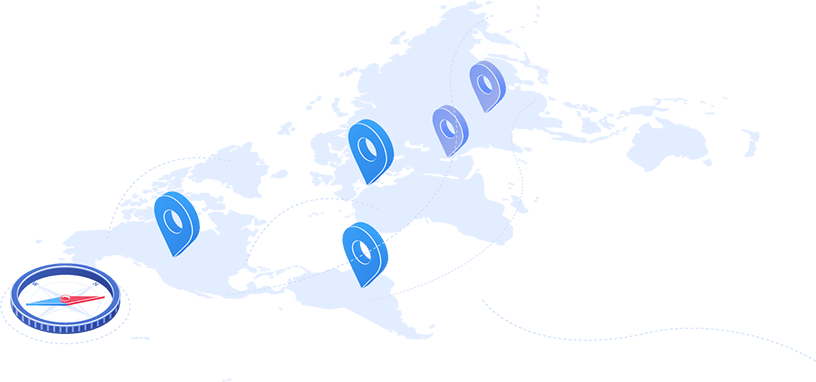
Worldwide dealers
Find schenker dealers near you, send us a message.
Name (required)
Email (required)
Select Your Country (required)
Message (required)
Security check (required)
Dimostra di essere umano selezionando chiave .
Pursuant to and for the purposes of articles art. 7, 13 and 15 of EU Regulation 2016/679 I declare that I have read the privacy policy of this site and consent to the processing of personal data to receive the answer to my request.*
Main Office

Official websites use .boston.gov
A .boston.gov website belongs to an official government organization in the City of Boston.
Secure .gov websites use HTTPS
) or https:// means you've safely connected to the .gov website. Share sensitive information only on official, secure websites.
Boston Celtics Victory Parade and Traffic Advisory
The City of Boston will host a duck boat parade on Friday, June 21, 2024, to celebrate the Celtics winning their 18th NBA Championship.
- Last updated: June 21, 2024
Parade Route and Map
The parade will begin at 11 a.m. on Causeway Street and then follow Staniford Street to Cambridge Street to Tremont Street to Boylston Street, before ending near the Hynes Convention Center.
Download the map (pdf)
Public Transportation
Those attending the parade are strongly encouraged to use public transportation. Riders can find more information on MBTA service, parking, paying fares, and more during Friday’s Celtics Championship Parade on the MBTA's website .
The MBTA will have increased subway service and modified Commuter Rail schedules with additional train times before and after the parade. Riders are strongly encouraged to purchase roundtrip fares in advance.
Accessibility
The parade route will include two designated accessible viewing areas - on City Hall Plaza on the Cambridge Street side and outside of the Boston Public Library on Boylston Street. There is no reserved seating at these viewing areas.
Bluebikes, the regional bike share service, is another great way to get around the City. Information on passes and station locations may be found on the Bluebikes website .
Parking Restrictions (No Parking)
- Causeway Street , Both sides from North Washington Street to Merrimac Street
- Staniford Street , Both sides from Causeway Street to Cambridge Street
- Cambridge Street , Both sides from Staniford Street to Tremont Street
- Tremont Street , Both sides from Cambridge Street to Boylston Street
- Boylston Street , Both sides from Washington Street to Massachusetts Avenue
- Charles Street South , Both sides from Park Plaza to Boylston Street
- Charles Street , Both sides from Beacon Street to Boylston Street
- Arlington Street , Both sides from Newbury street to Saint James Avenue
- Berkeley Street , Both sides from Saint James Avenue to Newbury Street
- Clarendon Street , Both sides from Saint James Avenue to Newbury Street
- Dartmouth Street , Both sides from Newbury Street to Saint James Avenue
- Exeter Street , Both sides from Newbury Street to Blagden Street
- Fairfield Street , Both sides from Boylston Street to Newbury Street
- Gloucester Street , Both sides from Boylston Street to Newbury Street
- Hereford Street , Both sides from Boylston Street to Newbury Street
- Cambria Street , Both sides, from Boylston Street to end at Hynes Center garage
- Scotia Street , Both sides, from Saint Cecilia Street to Dalton Street
- Saint Cecilia Street , Both sides, from Belvidere Street to Boylston Street
- Dalton Street , Both sides, from Belvidere Street to Boylston Street
- Providence Street , Both sides, from Arlington Street to Berkeley Street
- West Street , Both sides, from Washington Street to Tremont Street
- Temple Place , Both sides, from Washington Street to Tremont Street
- Bromfield Street , Both sides, from Washington Street to Tremont Street
- Park Street , Both sides, from Tremont Street to Beacon Street
- Beacon Street , Both sides, from Somerset Street to Tremont Street
- School Street , Both sides, from Tremont Street to Province Street
- Somerset Street , Both sides, from Ashburton Place to Cambridge Street
- New Chardon Street , Both sides, from Cambridge Street to Merrimac Street (Congress Street)
- Bowdoin Street , Both sides, from Dern Street to Cambridge Street
- New Sudbury Street , Both sides, from Cambridge Street to Hawkins Street
- Congress Street , Both sides, from New Sudbury Street to State Street
- State Street , Both sides, from Congress Street to Court Street
- Court Street , Both sides, from Washington Street to Cambridge Street
- New Chardon Street , Both sides, from Cambridge Street to Merrimac Street (Congress Street)
- Staniford Street , Both sides, from Cambridge Street to Merrimac Street
- Lomasney Way , Both sides, from Causeway Street to Nashua Street
- Lancaster Street , Both sides, from Causeway Street to Merrimac Street
- Portland Street , Both sides, from Causeway Street to Valenti Way
- Friend Street , Both sides, from Causeway Street to Valenti Way
- Canal Street , Both sides, from Causeway Street to Valenti Way
- Haverhill Street , Both sides, from Causeway Street to Valenti Way
- Beverly Street , Both sides, from Causeway Street to Valenti Way
- Medford Street , Both sides, from Causeway Street to North Washington Street
- Plympton Street , Both sides, from Albany Street to Harrison Avenue
- East Dedham Street , Both sides, from Harrison Avenue to Albany Street
Public Safety
Please note:.
- Underage and public drinking of alcohol will not be tolerated.
- Boston Police and Boston EMS will have a large presence along the parade route.
- The Office of Emergency Management will also have misting tents out to provide cooling relief at City Hall Plaza and the Boston Common, along with cooling towels.
- Residents are encouraged to sign up for AlertBoston emergency notifications for the latest updates.
Be aware of the heat
While the previously declared heat emergency will have ended by Friday, first responders will be ready to help those feeling adverse effects from the heat. Please remember to stay hydrated and use sunscreen.
Read the public safety update

10 Best Blue-Chip Stocks to Buy for 2024
These blue-chip companies can prosper in all economic and political environments.

Getty Images
Hershey, one of the world's most recognizable chocolate companies, produces a sweet product that people can eat frequently even during hard economic times.
The stock market seems unstoppable right now. The major market indexes are hitting new highs almost every month. Breakthroughs in fields such as semiconductors and artificial intelligence seem set to pave the way for rapid increases in efficiency and corporate profitability. And with inflation starting to moderate, the Federal Reserve may be able to start meaningfully cutting interest rates within the next couple of quarters.
However, things can change on a dime. Recall how the markets plunged both in early 2020 and once again in 2022. If anything is guaranteed in the stock market, it's that there will be stomach-churning volatility at times along the way. A solution for this is to invest in blue-chip stocks. While equities are unpredictable, companies with long track records of success tend to be more stable and more able to weather the various storms that come up along the way. The following companies are both tremendous long-term picks, and also offer considerable value in today's otherwise high-priced market.
These are 10 of the best blue-chip stocks to buy today:
- Visa Inc. (ticker: V )
Estee Lauder Cos. Inc. ( EL )
Brown-forman corp. (bf.a, bf.b), hormel foods corp. ( hrl ), intel corp. ( intc ), toronto dominion bank ( td ), united parcel service inc. ( ups ), hershey co. ( hsy ), johnson & johnson ( jnj ), realty income corp. ( o ), visa inc. ( v ).
A couple of years ago, the credit card giants were on shaky footing. The pandemic shut down international travel, greatly limiting the most profitable revenue stream for these companies: cross-border payments. On top of that, the rise of financial technology (fintech), mobile wallets and cryptocurrency-based payments systems appeared to be a major threat to credit cards. Fast forward to 2024, however, and international travel is stronger than ever. Meanwhile, much of the fintech and cryptocurrency competition failed to get off the ground.
Visa, in particular, is firing on all cylinders. Analysts are projecting that it will bring in $36 billion in revenue this fiscal year, which is way up from the $23 billion recorded in fiscal 2019. And while the pandemic was a short-term drag on the company's results, it counterintuitively ended up helping the firm in the bigger picture. That's because the crisis drove much faster adoption of contactless card payments systems while speeding the decline of cash-based transactions. With analysts forecasting double-digit annualized earnings growth for the foreseeable future, Visa is a blue-chip stock that investors can count on for the long haul.
Estee Lauder is one of the world's leading cosmetic care companies. The company enjoyed a sales boom in 2021 as the economy reopened and people wanted to look their best once the lockdowns ended. However, the sales boom fizzled out faster than expected, causing retailers to have far too much inventory. The downturn has been particularly steep in the key Chinese market.
But this is hardly a permanent condition, and inventory and sales levels will normalize over time. Meanwhile, EL stock has collapsed from a high of $370 to less than $115 today as investors have dramatically overreacted to the near-term earnings slump. In the bigger picture, cosmetics demand will continue to soar thanks to social media, along with rising wealth and consumption levels in emerging markets such as India and Latin America. All this makes Estee Lauder a great blue-chip stock to buy at a fat discount today.
Brown-Forman is one of America's leading spirits companies. Controlled by the Brown family for generations, the company was one of the few alcoholic beverage producers that survived the U.S. prohibition period. The company would take over operations of the Jack Daniel's whiskey brand in 1956 and has grown it tremendously since then, making it a prominent global whiskey brand. In addition, Brown-Forman made a shrewd acquisition, picking up Herradura tequila for $776 million in 2008 just before the tequila boom really took off. The firm is now targeting growth through Jack Daniel's line extensions, more upscale brands like Woodford Reserve, and ready-to-drink products such as canned Jack and Coke.
Brown-Forman shares have risen more than fifty-fold over the past 40 years. Despite the tremendous track record however, investors have soured on the company more recently, with the stock losing 20% over the past five years. Brown-Forman has seen uneven results since the pandemic, but these near-term operational issues have created a tremendous buying opportunity in the storied stock.
Hormel Foods is a packaged foods company focused on protein-based products. The company is an unheralded growth and income champion. In fact, it is one of the rare Dividend Kings , meaning that it has raised its dividend for at least 50 consecutive years. The company has built that enviable track record thanks to its strong brands and superb management team. Hormel also benefits from the fact that a charitable trust controls half of the company, insulating it from meddling activist investors while allowing management to grow the business with a long time horizon. Hormel used to be known for its Spam canned pork product, but it has evolved its portfolio to also include healthier options such as naturally raised and organic meats, nuts and nut butters, guacamole and Mexican salsas.
HRL stock has had a dramatic drawdown over the past two years due to a pandemic-linked drop in profit margins. But analysts expect the company to recover in 2025 and meanwhile this Dividend King's yield sits at 2%.
It's been a rough 2024 for Intel. Shares of the semiconductor giant are down more than 35% year to date while the VanEck Semiconductor ETF ( SMH ) is up more than 50% over the same time period. Intel is dealing with a couple of problems. One, its core computer chip market turned down sharply in 2023 as the work- and study-at-home era ended and personal computing sales plunged. More broadly, Intel has fallen behind rivals such as Nvidia Corp. ( NVDA ) in developing AI-enabled chips for next-generation data centers.
However, investors shouldn't give up on this blue-chip tech giant so quickly. Intel spends more than $16 billion annually on research and development, giving it plenty of opportunity to catch up in the technology arms race. Meanwhile, with assistance from the Biden Administration's CHIPS Act, which subsidizes domestic semiconductor factories, Intel is investing heavily in cutting-edge manufacturing facilities which should further help it level the playing field compared to its rivals.
Toronto Dominion Bank is one of Canada's five large banks. In addition to its dominant retail banking business, Toronto Dominion has substantial operations in investment banking along with an increasing presence in the United States market. It also owns a sizable chunk of Charles Schwab Corp. ( SCHW ), giving it upside as that brokerage continues to recover from last year's interest rates and deposit flight jitters.
TD stock is now selling at its lowest price since late 2020. Investors are worried about a slowdown in the Canadian market and the possibility that Canada's booming housing market may turn to a bust. These are valid concerns, but Canada's banking system has proven to be incredibly resilient, and the government offers strong backing to support the residential mortgage market. This makes TD stock a great dip-buying opportunity now, and the dividend yield is also a generous 5.4%.
With approximately 500,000 employees, 100,000 vehicles, and more than 500 airplanes, UPS is a truly gigantic enterprise devoted to the delivery of small parcels. Along with FedEx Corp. ( FDX ) and DHL Express, these three enjoy massive market share and a generally stable competitive market. UPS enjoys industry-leading profit margins in significant part due to its unrivaled scale and its robust infrastructure investments.
While UPS' long-term outlook remains favorable, traders are worried right now. Shares are off more than 20% over the past 12 months as e-commerce sales growth has slowed down with the end of the stay-at-home era. In addition, competition from Amazon.com Inc. ( AMZN ) in the last-mile delivery market has depressed investor sentiment. These factors have pushed UPS stock down to less than 17 times forward earnings while offering an appealing 4.7% dividend yield.
Hershey is one of the world's largest chocolate and confectionery companies. The consumer staples firm has also made an increasing push into the snack food market in recent years. The firm's appeal comes from its powerful brands. People have a strong association with their favorite brands of sweets and don't often switch away from a preferred flavor profile. Chocolate is also an affordable luxury, something that people can eat frequently even during hard economic times. This positions Hershey well for whatever may lie ahead once the current economic expansion ends.
Hershey stock hit new all-time highs in 2023 as it benefited from solid price increases during the recent inflationary period. However, the stock has now pulled back more than 25% over the past 12 months, pushing shares down to a much more reasonable entry point. In particular, the stock is back under 20 times forward earnings. Human nature doesn't change very quickly; sweet treats will always be in demand, and Hershey's tremendous branding and operating scale will keep it in a leading position for decades to come.
Founded in 1886, Johnson & Johnson has proven to be one of the bluest of blue-chip stocks available in America. The company has introduced a vast number of leading pharmaceutical products, medical devices and consumer wellness products over the decades. The company's broad internal diversification and vast array of different products has insulated it from economic shocks or changing market trends.
Johnson & Johnson has missed out on the GLP-1 drug boom – pharmaceutical companies that have exposure to the diabetes management and weight loss space are booming and everything else is underperforming right now. J&J also recently spun off its consumer products unit as a separate company, and the market is still sorting things out on that front. These factors have pushed JNJ stock down significantly over the past couple of years, offering up this health care leader at just 14 times forward earnings.
Real estate can be a volatile market. And that's especially true in the current macroeconomic environment where high interest rates and abrupt changes in the commercial real estate market are wreaking havoc on many real estate investment trusts (REITs). Fortunately for long-term investors, there is still a great choice in the REIT sector: Realty Income. The triple-net lease REIT has shrewdly navigated the changing tides while remaining a dependable income investment. The company spun off its office properties years ago, helping it avoid the downturn that has since hit that sector. Meanwhile, Realty Income has moved into entertainment properties that are performing better in the current consumer environment.
Realty Income has increased its dividend, which is paid monthly , for more than 25 years in a row, making it one of the few Dividend Aristocrats in the REIT category.
Tags: investing , stock market , Visa , Estee Lauder Companies , Hormel Foods , Intel , TD Bank , UPS , Hershey Co. , Johnson & Johnson , Realty Income Corp
The Best Financial Tools for You
Credit Cards

Personal Loans

Comparative assessments and other editorial opinions are those of U.S. News and have not been previously reviewed, approved or endorsed by any other entities, such as banks, credit card issuers or travel companies. The content on this page is accurate as of the posting date; however, some of our partner offers may have expired.

Subscribe to our daily newsletter to get investing advice, rankings and stock market news.
See a newsletter example .
You May Also Like
Free investment classes and resources.
Marguerita Cheng June 25, 2024

7 Best Semiconductor ETFs to Buy in 2024
Tony Dong June 25, 2024
Best Lithium Stocks and ETFs
Brian O'Connell June 25, 2024

10 Money Quotes for Investors
Kate Stalter June 24, 2024

9 Dividend Aristocrat Stocks to Buy Now
Wayne Duggan June 24, 2024

6 Best Health Care ETFs to Buy Now
Brian O'Connell June 24, 2024

7 Best 5-Star ETFs to Buy
Coryanne Hicks June 24, 2024

7 Best REIT ETFs to Buy
Glenn Fydenkevez June 24, 2024

10 Highest Dividends in the S&P 500
Jeff Reeves June 21, 2024

Nano Options: A Primer
Julie Pinkerton June 21, 2024

7 Drone Stocks to Watch in 2024
Brian O'Connell June 21, 2024

Natural Gas Stocks and Funds
Matt Whittaker June 21, 2024

7 Best Consumer Staples ETFs

What Is Greenwashing?
Kate Stalter June 20, 2024

7 Best Monthly Dividend Stocks to Buy
Glenn Fydenkevez June 20, 2024

7 Best Funds to Hold in a Roth IRA
Tony Dong June 20, 2024

Best Places to Buy Real Estate in 2024
Coryanne Hicks June 20, 2024

15 Best Dividend Stocks to Buy for 2024
Ian Bezek June 20, 2024

8 Top Nancy Pelosi Stocks to Buy
Wayne Duggan June 18, 2024

8 Best Consumer Staples Stocks to Buy
Julie Pinkerton June 18, 2024

- sunwatermarine
- Dec 8, 2021
5 Best Watermakers for Sailboats
Last Updated by Daniel Wade, October 1, 2021

With the right Watermaker, the ocean becomes an almost immeasurable supply of fresh and clean drinking water to keep you hydrated during your offshore sailing adventures.
Many sailors do spend a lot of their time and money on various parts of the sailboat including the sails, engine, electronics, and generators especially when preparing for long-distance voyages.
While there's absolutely nothing wrong with this, they often overlook one crucial part of general human survival: having an ample supply of fresh drinking water.
Whether you have freshwater drinking tanks on your sailboat or planning to cruise in areas where you can easily access clean drinking water, the hassle involved in having to come to the dock to fill the water tanks can be quite overwhelming.
This is exactly why you need to find the best watermakers for sailboats.
Like many other nautical technologies, watermakers have significantly advanced in the last few decades to become very efficient and more reliable. They're no longer a luxury on your sailboat but a necessity. Better still, watermakers have become relatively affordable and are meant to keep you hydrated as you explore areas that do not have clean and fresh drinking water.
In this article, we'll take a look at how watermaker systems work, highlight their benefits, and highlight the best sailboat watermakers on the market right now. At the end of this read, you should be able to choose the best watermaker for your sailboat.
Benefits of Having a Watermaker on Your Sailboat
The freedom and security that come with having full water tanks on your sailboat are of immense importance, especially if you're cruising in an area where fresh drinking water is hard to come by and quite expensive when you do. As such, having a watermaker aboard your sailboat is no longer a luxury like it used to be in the past. With a steady supply of fresh and clean water, your life on the sailboat will be a lot better. This is because you'll have enough clean water to drink, cook, wash, and shower, which is beneficial if you want to enjoy your sailing adventures.
Honestly speaking, many sailors do not actually need a watermaker. Well, if you're planning to sail just near the shores, then there's a chance that you can easily access fresh and clean water by the dock. But this can be limiting if you've been dreaming of going off the grid and sailing to some exotic and unknown places in the world.
With that in mind, a watermaker makes a lot of sense to most sailors. You won't have to worry about having to carry aboard gallons of freshwater for cooking and drinking during your voyage. You won't have to treat freshwater as a precious commodity that must last until you can refill at the next port. With a watermaker, you can simply go ocean crossing without worrying about running out of water.
A watermaker allows you to have a steady supply of fresh and clean water to keep everybody well-hydrated and healthy. You can clean the water anytime you feel like and all you have to do is replace the filter once in a while and you'll be good to go. In essence, a watermaker is probably one of the most important equipment to have aboard your sailboat, so installing it is of great importance if you're a serious sailor.
The Basics of Modern Marine Watermakers
Modern marine watermakers essentially follow the principle of reverse-osmosis to produce pure, drinking water from seawater. During this process and through very high pressure, seawater is forced through a semipermeable membrane that only allows freshwater molecules to pass through it but not salt, bacteria, or any other organic material. The newly made pure, drinking water is then piped to the sailboat's water tanks while the leftover (brine) is discharged overboard.
Even though marine watermakers may differ in the type of pump that's employed and how it is driven, this is one of the most important features in every watermaker. In most cases, water can be electrically pumped or powered directly off the boat's engine. If you have an AC generator or alternator on your boat, it would make much sense to use the AC output to drive the watermaker directly. You can also choose the DC-powered models if you rely on renewable energy from solar or wind. Alternatively, you can still go for AC-powered watermakers but you'll have to buy an inverter.
All in all, DC-powered watermakers are more efficient since they integrate a power-saving energy recovery system (ERS). You must, however, keep in mind that your energy consumption levels might be quite high if you're sailing in colder and saltier areas. This is because the water purification process might be a bit slower in such areas. As such, you should consider investing in a more high-powered watermaker system if you will be sailing in colder and saltier areas than if you're planning to sail more in warm and less salty areas.
As far as an engine-driven watermaker is concerned, you should mount the high-pressure pump on the engine so that it can be belt-driven using an automatic clutch. An engine-driven watermaker should be your first option if you want large quantities of fresh drinking water. This is more productive than AC or DC-powered watermakers. Even with a relatively small engine, this setup has an automatic regulator that constantly pumps the water. With that in mind, engine-driven watermakers are ideal if you want to reduce your energy consumption. To put it into perspective, an engine-driven watermaker can lower energy consumption by an enormous 80%, especially when compared with conventional AC or DC-powered watermaker systems.
How to Choose the Best Watermaker for Your Sailboat
There are many factors to consider when looking for the best watermakers for your sailboat. Here are the most important things to consider.
Your Freshwater Needs
One of the most important things to consider before spending your money on a watermaker is your freshwater needs. What quantity would be enough to keep you going on your sailing adventure? While the quantity might differ from one sailor to the other or from one boat to the other, you should consider the number of gallons that a particular watermaker can produce per day. This will help you in choosing the ideal watermaker; a model that will ensure that you never run out of water. Do not underestimate your water needs, especially if you're planning to sail with your children or if you're planning to stay on the boat for an extended period of time.
Do you have enough space on your vessel to accommodate the type of watermaker you're looking to buy? While most watermakers are designed to fit in the smallest of space, you should consider the actual size of the watermaker and find out whether you have enough space on your vessel to fix it.
Watermakers can run on electricity, renewable energy such as wind and solar (if you have them on your vessel), or both. When looking for the perfect watermaker, you should consider how to power it and whether or not the watermaker has low-energy consumption, which is definitely a great feature. Again, there are also engine-driven watermakers, so it's important to know exactly what you're going for.
Maintenance
Watermakers have a reputation for being difficult to maintain. Fortunately, the equipment and components have improved in the last few years so you should go for a model that's easy to maintain. You should use the watermaker in water bodies that look good, You should avoid using the watermaker in dirty harbors as you may have to change the filters every so often or even damage your watermaker altogether.
Best Watermakers for Sailboats
Let's take a look at the best watermakers available on the market right now.
The Ultra Whisper

Engineered by limited electrical options that can run on either DC or AC, THE Ultra Whisper by Sea Recovery is one of the best watermakers currently available on the market. In addition to being very quiet, this watermaker features an automatic operation that requires very minimal operator adjustment.
This watermaker is ideal for small powerboats and sailboats since it can serve as an efficient water supply. This model boasts about a 75% reduction in power consumption, especially when compared to other models.
Smooth and quiet water production
Can produce up to 2,280 liters per day
Ideal for small boats
It is energy efficient
It might not be perfect for large boats
Echotec Watermaker

If you want a watermaker model that can produce 60 liters per hour flawlessly and with no maintenance apart from changing the filters, look no further than the Echotec Watermaker. This model is designed for ultra-reliable performance and easy customer installation.
This watermaker is made from high-quality components that can withstand the continuous harsh marine environment, making it one of the most durable watermakers on the market. This is essentially a series of modular watermakers ranging from 12-volt to 24-volt DC-powered models. They bring forth energy efficiency, a computerized energy recovery system, and ultimate reliability to ensure that you never run out of fresh drinking water while out there on the sea.
Energy efficient
Cost-effective
Comes with a very low speed
Not ideal for large boats
Spectra Katadyn PowerSurvivor

As a compact and energy-efficient watermaker, the Spectra Katadyn PowerSurvivor is arguably the most affordable watermaker currently available on the market. We are talking about a model that only requires 4 amps to desalinate water for your sailboat. It can produce 1.5 gallons of fresh drinking water per hour, which is an excellent return for a watermaker of its size.
It is also one of the most portable watermakers around. You can choose to either install it permanently or temporarily in case you want to take it somewhere else. This portability is also essential if you're looking for a space-saving model that can fit in the smallest of compartments. Its simple but rugged design is essential in ensuring that it can perform at its best even in harsh marine conditions. In terms of its power capabilities, this is the only model on the market that will convert to a hand-operated system or manual power if there's a power shortage.
Portable and lightweight
Rugged design to withstand harsh marine environments
Efficient and reliable
Can revert to manual power if there's a power shortage
Perfect for off-grid sailing
Gasoline or diesel can easily damage the semi-permeable membrane
Village Marine - Little Wonder Series

Whether you're looking for a watermaker for your small sailboat or looking for a watermaker that can efficiently serve those huge yachts, the Village Marine Little Wonder Series provides everything. This model is meant for experienced sailors who are looking for various capacity options. This watermaker weighs just about 69 pounds but can produce nearly 180 gallons of fresh drinking water each day.
Designed with a low RPM high-pressure pump, this model remains one of the most efficient and economical watermakers on the market. That's not all; this watermaker is designed with corrosion-resistant features and is one of the most serviceable watermakers in the game. It is reliable, quiet, and portable; all factors that make a watermaker great.
Easy to operate
Corrosion-resistant
Easy to maintain
Quiet and versatile
It doesn't have automatic adjustment controls
Ventura 150 Watermaker

This is one of the most versatile watermakers on the market. It can use both electricity and renewable energy. This model is engineered to be lightweight and energy-efficient and its compact and modular design makes it a great option if you're looking for a watermaker that's easy to use and install in confined spaces.
The Ventura 150 watermaker is highly efficient as it can produce over 6 gallons of water an hour, which makes it quite perfect for small vessels. This sailboat watermaker features a controller that allows you to operate and monitor the device remotely. It also has the auto store button that will automatically flash the system after every five days.
This watermaker is quiet and surprisingly compact despite its ability to produce about 150 gallons of water per day. It also gives you the option of going for the automated manual or manual model.
Very versatile
Can use both electricity and renewable energy power
It is smooth and quiet
It is compact and lightweight
The manual model has analog controls
To this end, it's easy to see that having an ideal watermaker aboard your vessel is one of the first crucial steps towards being self-sufficient and sustainable. With a watermaker, you'll be able to access fresh drinking water at all times when sailing even in far-flung places. Most of these models are well-constructed and incorporate some of the best technologies that make them efficient, reliable, and easy to install, use, and maintain.
So when it comes to choosing the best watermaker for your sailboat, it may all come down to what is ideal for you in terms of energy consumption, efficiency, the quantity of water produced, among many other things. With an ideal watermaker, you can remain off the grid for as long as you want without ever worrying about running out of water and this is of great importance in enjoying your sailing adventures.
Recent Posts
James Richmond on bluedotliving.com
Flanigan's Eco-Logic Convo Featuring James Richmond
Horsepower VS. Torque
Kommentarer

Chris Brown's Bulge Goes Viral After Fans Spot Huge Imprint at Concert

Lele Pons Hottest Shots To Celebrate Her 28th Birthday!

Celine Dion Suffers Seizure On Camera In New Documentary 'I Am'

See Tabitha Brown And Hot Hubby Chance Vacaying In Cabo!

Bhad Bhabie Livin' Best New Mama Life, Twerking on Yacht, Partying
Vogue world 2024: kendall jenner, cara delevingne, more stars strut in paris, vogue world 2024 kendall, cara, sabrina & more ... strut their stuff in paris.
All eyes were on Paris this weekend -- but not because of the forthcoming Olympics ... it all had to do with celebs who got dressed up in wacky outfits and posed in front of cameras.
Countless stars descended upon the City of Light Sunday for Vogue World 2024 -- a fashion event rivaling the Met Gala and fashion week itself. The event went down Sunday at the famed Place Vendôme ... where A-listers were channeling an Olympics theme.
There were plenty of famous faces ... Cara Delevingne , Joey King , Selma Blair , Pharrell Williams , Emma Chamberlain and more all showed off some pretty out-there looks.
Selma wore an all-black ensemble with her chic blonde locks tied back in an updo. In contrast, Joey rocked a white, '60s style mod dress ... looking pretty elegant.
Waiting for your permission to load TikTok Post.
There were plenty of starry cameos too ... Sabrina Carpenter , Ciara , Teyana Taylor , Katy Perry , Serena Williams and others strutted their stuff in the famed Parisian square.
The event even brought rekindled lovers Kendall Jenner and Bad Bunny together ... they both popped up in the show at different points. While Kendall notably rode through on a horse next to Gigi Hadid , Bad Bunny graced the audience with musical performances.
Check out all the can't-miss moments for yourself ... it was a who's-who!
- Share on Facebook
related articles

Bad Bunny Gets Handsy with Kendall Jenner While Clubbing in Paris

Joe Burrow, Justin Jefferson Walk In Paris Fashion Show
Old news is old news be first.

IMAGES
VIDEO
COMMENTS
Watermakers also come in all shapes and sizes, with modular options best suited for smaller boats, as the parts can be "stashed" in whatever precious extra cargo space is available. Best Marine Watermakers. Let's take a look at a roundup of some of the best boat watermakers on the market right now for your vessel. The Ultra Whisper
Spectra Katadyn PowerSurvivor. As a compact and energy-efficient watermaker, the Spectra Katadyn PowerSurvivor is arguably the most affordable watermaker currently available on the market. We are talking about a model that only requires 4 amps to desalinate water for your sailboat.
The best sailboat watermakers for liveaboards. The Rainman naked 12V watermaker is a great option for anyone looking for a compact, efficient way to produce fresh water. The unit is simple to set up and use, and it produces up to 30 litres of fresh water per hour for a smaller unit, or up to 140 litres per hour for a larger one.
High-pressure pump watermakers are fast, but they aren't the most energy- efficient way of creating clean water. They are usually tuned to produce 60 litres per hour or more but can draw upwards of 500W and while there are 12V versions, they typically use mains voltage pumps and are better suited to being run from a generator than a battery bank.
In our tests, its 1/18-hp. motor drew 4.8 amps, producing about 1.6 gallons per hour, consuming 39 watts per gallon of water. It is very compact, and like all PUR watermakers, easy to service and operate. At 72 dB, its noise level was the equivalent of the quieter large 12-volt machines.
Katadyn-owned Spectra produces a wide range of watermakers, from the hand-operated Survivor 06 to a commercial AC model capable of producing 10,000 gallons per day. The most suitable units for cruising yachts are its DC/AC-powered Ventura, Catalina and Newport models, offering production rates of between 6.3 and 41gph.
In terms of installation, the kinds of watermakers that work best with the typical small or mid-size cruising sailboat are those that are fully modular—i.e., in which the filters, strainers, pumps and semi-permeable membrane are all installed separately in whatever kind of an arrangement suits your boat best. ... Review: Jeanneau Yachts 55 ...
Desal systems suitable for recreational cruising range from $3,500 to $11,000, with the price difference based mostly on the production. A few portable systems are priced as low as $1,200, but their output won't do the job for more than basic needs for a couple aboard. We'll look at some of those available in Part 2.
Watermaker running costs. An ERD unit will typically produce 20-60 litres per hour. The lower demand on the pump means it can be reasonably powered by 12V with as little as 9A, and can produce a litre of water with just 4-5Wh of energy. High-pressure units need between two and three times that energy per litre.
A watermaker on a yacht converts seawater into fresh water through a process known as reverse osmosis (RO). A high-pressure pump pushes seawater through a semi-permeable membrane that filters out salt, organics, and bacteria. The fresh water is pumped into your water tanks while the remaining brine bi-product is discharged over the side of the ...
A Rainman watermaker turns salt water to fresh, drinking water! The watermaker needs two things to work: a raw water source, like the sea, and a power source, which on a sailboat is typically your batteries and solar panels. You can get watermakers that run directly off the 12VDC / 24VDC your batteries provide, or from your inverter at 120VAC ...
Since all of the watermakers that are currently available for cruising sailboats use this process for desalination, the major differences between the systems are how you power the high-pressure pump and the user interface. Powering options include 120/220-volt AC, 12- or 24-volt DC and engine/belt driven. All have their pros and cons.
Rainman was originator in 2014 of the first commercially successful gasoline-powered portable water-maker. The 2022 unit is powered by a 2.1 hp Honda four-stroke. It weighs 58 pounds (23 kg) and can lift water a max of 6' (2 m). The required RO unit adds another 51 lb (23 kg) to the package.
1. Katadyn Power Survivor 40E Watermaker Desalinator. Small yet powerful, the Katadyn Power Survivor 40E is a reliable workhorse designed for boats with a small crew population of 2 to 3. This modular unit provides 1.5 gallons of water per hour, and draws only 4 amps from a 12-volt system, making it one of the most energy efficient desalinators ...
Watermakers, Inc. WMS-1000 Courtesy Watermakers, Inc. Watermakers, Inc. has been supplying reverse-osmosis units to boats and remote locations for many years, and their WMS-1000 is a workhorse unit that can be set up in a container or modular configuration. It features a heavy-duty 316 stainless-steel direct-drive high ...
Schenker's three-years warranty is backed up by our international network of sales and service representatives. RANGE: 30 LIT/H. Portable marine watermaker. Checkout all models. RANGE: 30-50-100-200-300 LIT/H. Quiet, small, efficient, inexpensive. Checkout all models. RANGE: 30-60-80-100 LIT/H. Smart, light and affordable.
Welcome to SeaWater Pro, the premier provider of high-quality watermakers for boats and portable watermakers for all your marine adventures. Our cutting-edge technology and reliable products will ensure that you have access to clean, purified seawater wherever you go. With our easy-to-use and reliable watermakers, you can say goodbye to bulky storage tanks or worry about running out of fresh ...
A DC watermaker's energy efficiency is the measure of the amount of electricity consumed per unit of fresh water produced. This is a useful number, but its actual importance depends on the boat's entire electrical energy management system. For a boat with limited battery and charging capacity, electrical efficiency may be a paramount concern.
ECHOTec manufactures the most rugged and easy to operate desalination systems. With the release of the new 12 / 24 Volt Watermaker 200-DML-1, ECHOTec achieved a breakthrough in efficiency for watermakers, utilizing ultra-reliable triplex ceramic plunger pumps. The ECHOTec. pump is a low revolution (570 RPM) stainless steel version, driven by a ...
Watermaker Considerations: Before purchasing the best watermaker for your needs, consider the following: The size of your boat. Desired features & functionality. Usage requirements. Length of use. The number of vessel occupants. These factors contribute to your water usage requirements and will determine the size and output of your watermaker.
Designed for customer installation and ultra-reliable performance, far from factory-trained service centers, the wide product range covers modular AC, DC, and belt-driven watermakers from 8.4 GPH / 32 LPH to self-contained desalination systems with a production of 14.000 gallons or 53.000 liters per day. More than 5,000 ECHOTec desalination ...
The ideal watermaker should provide the daily fresh water demand of the boat in about 3-4 working hours. On his turn, the daily fresh water demand is based on the number of people onboard and the type of boat. The typical fresh water demand in a sailing boat if about 30-40 lit/day, whereas it is 50 -60 lit/h in a power boat or catamaran.
Public Transportation. Those attending the parade are strongly encouraged to use public transportation. Riders can find more information on MBTA service, parking, paying fares, and more during Friday's Celtics Championship Parade on the MBTA's website.. The MBTA will have increased subway service and modified Commuter Rail schedules with additional train times before and after the parade.
Bhad Bhabie's motherhood version of living her best life looks a lot like it did before she had a kid ... twerking like there's no tomorrow and making the most of L.A.'s scorching summer on a yacht.
Bhad Bhabie Livin' Best New Mama Life, Twerking on Yacht, Partying
Here are seven of the best. Glenn Fydenkevez June 24, 2024. 10 Highest Dividends in the S&P 500. These dividend stocks offer 6% or better, but they come with risk. Jeff Reeves June 21, 2024.
Bhad Bhabie Livin' Best New Mama Life, Twerking on Yacht, Partying. David Corenswet in Full Superman Costume, First On-Set Photos David Corenswet It's a Bird, ...
Last Updated by Daniel Wade, October 1, 2021With the right Watermaker, the ocean becomes an almost immeasurable supply of fresh and clean drinking water to keep you hydrated during your offshore sailing adventures.Many sailors do spend a lot of their time and money on various parts of the sailboat including the sails, engine, electronics, and generators especially when preparing for long ...
Bhad Bhabie Livin' Best New Mama Life, Twerking on Yacht, Partying. Vogue World 2024: Kendall Jenner, Cara Delevingne, More Stars Strut in Paris
The Boston Celtics were properly feted by their fans in the City of Boston with a duck boat parade for the Celtics winning the 2024 NBA Championship after beating the Dallas Mavericks in five games on this past Monday (June 17) night.. But now, you can watch Jayson Tatum interact with fans who made the trip out to the parade as the Celtics celebrated the long-coveted Banner 18.